- Best time to visit Indonesia
Book your individual trip , stress-free with local travel experts
- roughguides.com
- Travel guide
- Itineraries
- Local Experts
- Travel Advice
- Accommodation
Plan your tailor-made trip with a local expert
Book securely with money-back guarantee
Travel stress-free with local assistance and 24/7 support
Matt Mickiewicz
Trip Provider took us far off the beaten tourist path in Bali, and arranged a unique and very special experience far away from the tourist crowds that we w...
Indonesia is a year-round destination with a tropical climate. Determining the best time to visit Indonesia depends on various factors such as weather, crowd levels, and your own preferences. The country's tropical climate and diverse geography offer unique experiences and opportunities throughout the year. If you're wondering about the best time to visit Indonesia, it's important to consider what you want to see and do during your trip. From trekking through lush rainforests to lounging on idyllic beaches, Indonesia has something for every type of traveller. Can't decide? We'll explore the different seasons and help you decide when is the best time to visit Indonesia for your next adventure.

When to go to Indonesia per month
Indonesia peak season, indonesia wet season, indonesia dry season, islands and their best time to visit, tailor-made travel itineraries for indonesia, created by local experts.

6 days / from 830 USD
Bali's Beaches and Temples
Experience Bali's brilliant beaches and temples with this stunning trip. Marvel at ancient temples like Tanah Lot and Pura Besakih, soak in stunning sunsets, stroll bare-footed along the best beaches in Bali and haggle at local markets – experience all of this, and much more, with this unique trip!

10 days / from 1600 USD
Rest and Relaxation in Bali and Lombok
This unique trip will take you to some of Bali and Lombok's most traditional places. Look forward to driving through tropical landscapes and spending time in villages nestled in scenic spots of traditional luxury with infinity pools and stunning vistas over the ocean.

10 days / from 2100 USD
Royal Bali - Culture & Beaches
Enjoy a luxurious stay in Bali, with hand-picked 5 Star Hotels. This trip includes privately guided tours as well as leisure time, ideal for families with kids. Highlights include sea temple Tanah Lot, Jatiluwih rice terraces and Uluwatu temple with its famous Kecak dance.
If trekking is a priority, it's best to avoid the wettest months of the year when many volcano hikes are closed. The weather patterns make the dry season ideal for hiking, biking, and bathing in waterfalls.
However, temperatures remain high during the rainy season and rainfall is limited to short downpours. So it remains a great time to visit Indonesia — particularly if you want to visit temples and museums.
Arguably, when deciding when to go to Indonesia, the best time to visit is May, June and September . These are the shoulder months of the dry season. You’ll get clear days but you'll find the islands have fewer tourists and are less expensive.
Planning tip: If you prefer a quieter and more affordable trip , consider traveling during the shoulder seasons of April to May or September to November, when the weather is still good, but the crowds are thinner, and prices are more reasonable.

Padar Island close to Komodo National park
The weather in Indonesia varies depending on the region and season, but it generally experiences high temperatures and humidity levels throughout the year.
Weather in Indonesia in January
January is one of the wettest months in Indonesia, with heavy rainfall and high humidity. The weather conditions during this time can make outdoor activities like trekking and volcano hikes difficult.
Weather in Indonesia in February
February is still very much a part of the wet season. That said, the rainfall begins to decrease, and the weather becomes more temperate. Temperatures remain warm, with average highs of around 30 degrees Celsius.
Weather in Indonesia in March
In March, the rainfall begins to decrease, and the weather becomes more temperate. Temperatures remain warm, with average highs of around 30 degrees Celsius. However, the weather can still be unpredictable, and there may be occasional showers.
Nyepi, the Balinese New Year, kicks off at the end of March or beginning of April, which is a great local experience.
Weather in Indonesia in April
April sees the start of the transition period between the wet and dry seasons.
The tail end of the rainy season is the best time of the year to visit Indonesia for natural beauty. At this time, the jungle and rice fields are at their most lush, while rain showers are increasingly few and far between.
Weather in Indonesia in May
May marks the end of the wet season in Indonesia, and the country begins to experience a dry spell. Temperatures can soar during this period, particularly in urban areas, but the humidity levels are generally lower than during the wet season.
May is an ideal time for outdoor activities like hiking, biking, and exploring the countryside. This is also a prime month for diving off the coast of Bali , Lombok and Komodo National Park .
Weather in Indonesia in June
The weather in June is generally pleasant with low humidity. In June you'll find favourable weather conditions — with blue skies, sunny days, and little rain. June is the time of the most consistent surf, especially in Java and Bali.
Culture-seekers may like to time their visit with the Bali Arts Festival, which runs from June through to mid-July.

Nusa Lembongan Bali Indonesia © Shutterstock
Weather in Indonesia in July
Indonesia in July is marked by warm and sunny weather. However, temperatures can soar, particularly in urban areas, and visitors should take precautions to protect themselves from the sun and heat. July marks the start of the peak season.
Weather in Indonesia in August
August is the busiest month across most of Indonesia’s tourist hot spots, and you'll find there are beach parties and festivals galore. The weather makes it a great time to visit Indonesia. However, this is also a time of high season prices.
Weather in Indonesia in September
September is one of the best months to visit Indonesia — when the summer chaos has dissipated. Still dry and sunny, it’s a great time for land-based activities.
September is when one can catch the Erau Festival Tenggarong — a fantastic display of indigenous Dayak skills and dancing.
Weather in Indonesia in October
In October, the weather in Indonesia begins to cool slightly, with more moderate temperatures (average temperature of 27°C) and lower humidity levels. This is the perfect month for exploring the many cultural attractions that the country has to offer — including ancient temples, museums, and traditional villages.
October is also when the Krakatau Festival Lampung takes place — five days of events highlighting Lampung’s cultural heritage.
Weather in Indonesia in November
November is known as the shoulder season and is the best time to visit Indonesia. This is the transition month between the dry and wet seasons, with increasing rainfall and cooler temperatures. However, the weather can still be pleasant for outdoor activities.
In November, one can time their visit with the Kora Kora Festival. This is a great way to experience traditional longboat races in the Maluku Islands .
Weather in Indonesia in December
Generally speaking, Christmas and New Year are extremely busy and expensive. December is one of the wetter months and can be a time of heavy downpours and humidity. However, the festive season is the best time to visit Indonesia for raucous parties.
Many visit Indonesia for the Kasada Bromo. During this celebration, 0fferings are made to the gods and thrown into the crater.

Lombok Senggigi Beach © Shutterstock
Indonesia's peak season typically falls between June and August, coinciding with the dry season when the weather is sunny and pleasant. This is the most popular time to visit Indonesia, particularly for beach and outdoor enthusiasts who want to enjoy activities such as surfing, diving, and island hopping.
During the peak season, tourist hotspots such as Bali, Lombok, and the Gili Islands can become quite crowded and accommodation prices tend to be higher than during the rest of the year. It's advisable to book in advance to secure your preferred travel dates and avoid disappointment.
If you prefer a quieter and more affordable trip, consider traveling during the shoulder seasons of April to May or September to November, when the weather is still good, but the crowds are thinner, and prices are more reasonable
Indonesia's wet season typically lasts from October to May and is characterized by high humidity and heavy rainfall, particularly in December and January.
It is easy to find good deals when visiting Indonesia in the low season. From October to April, you can travel with little advance booking and low prices. Despite frequent downpours, temperatures hover around 30 degrees, and a big plus is that the islands are less crowded and cheaper.
Indonesia's dry season typically lasts from May to October and is a busy time for tourism. The weather is characterized by sunny and dry weather, with low levels of rainfall and warm temperatures. Average highs range from 28-32 degrees Celsius in most parts of the country.
It is not a good idea to visit Indonesia during peak tourist season (between July and mid-September). This is when prices soar and rooms can be fully booked for weeks on end.
Best time to visit Bali
The best time to visit Bali is during the dry season, which runs from April to Septembe r. During this time, the weather is sunny and dry, making it perfect for outdoor activities such as sunbathing, swimming, and hiking. The peak season in Bali falls between July and August, when the island can get crowded and prices may be higher.
However, if you visit Bali during the shoulder season (April to June or September to November), you can still enjoy good weather and fewer crowds.
The wet season in Bali runs from October to March, and while it may be cheaper to travel during this time, heavy rain can disrupt travel plans and limit outdoor activities.
Best time to visit Java
The optimal period to explore Java is from April to September when the dry season prevails. During this period, the climate is generally sunny and arid, ideal for engaging in outdoor endeavors such as hiking and sightseeing.
It's worth noting that the high season in Java falls between June and August, which means the island can get quite crowded and prices may be higher. The shoulder season in Java occurs from May to June or September to November, while the wet season runs from October to April. During the wet season, heavy rainfall may hinder travel plans and limit opportunities for outdoor activities.
Best time to visit Lombok
For the best experience, it is recommended to visit Lombok between April to September during the dry season. The weather is usually sunny and dry, making it ideal for outdoor activities like swimming, surfing, and snorkeling. July and August, is peak season which can lead to overcrowding and higher prices.
Nevertheless, if you plan to visit Lombok during the shoulder season, which spans from May to June or September to November, you can still enjoy pleasant weather conditions and avoid large crowds.
The Rough Guides to Indonesia and related travel guides
In-depth, easy-to-use travel guides filled with expert advice.
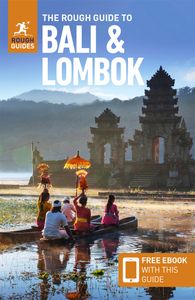
Travel advice for Indonesia
From travel safety to visa requirements, discover the best tips for traveling to Indonesia
- Culture and Etiquette in Indonesia
- Eating and drinking in Indonesia
- Getting around Indonesia: Transportation Tips
- How to get to Indonesia
- Travel Tips Indonesia for planning and on the go
Find even more inspiration here
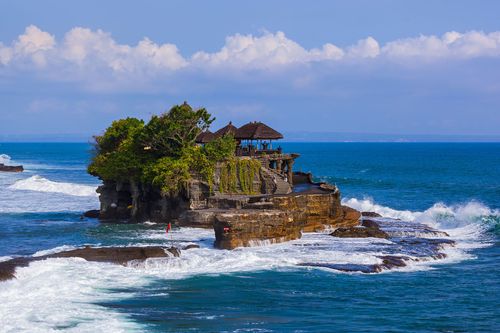
- Travel Tips
written by Rough Guides Editors
updated 25.04.2024
Ready to travel and discover Indonesia?
Get support from our local experts for stress-free planning & worry-free travels.
- Where to stay
- Travel advice

The Ultimate Guide: Best Time to Visit Indonesia
Indonesia, with its sprawling archipelago of over 17,500 islands, presents an alluring destination that promises adventure, relaxation, cultural immersion, and natural wonder. From the lush, terraced rice fields of Bali to the vibrant streets of Jakarta, each island offers a unique experience, making Indonesia a perennial favorite for travelers around the world. However, the vastness of the country also means that it experiences a wide range of weather patterns, affected in part by the global phenomena of climate change. The best time to visit Indonesia can vary significantly depending on where and when you travel, as well as what you want to do.
Low Season: Tranquil and Affordable (January–February)
December: festive spirit amidst the showers, best time to visit jakarta: the urban experience, impact of ramadan, general tips, introduction.
The Indonesian archipelago stretches across a significant portion of the Equator, with landscapes ranging from volcanic mountains to tranquil beaches, dense rainforests, and bustling metropolitan areas. This geographical and cultural richness means that any time of year can be the perfect time to visit, depending on your travel goals. Yet, with climate change altering weather patterns, it has become more important than ever to plan your trip carefully. Unpredictable heavy rainfall, shifting seasons, and even rising sea levels can impact the traditional dry and wet seasons, which are pivotal in deciding the best time to visit Indonesia .
The Indonesian Meteorological, Climatological, and Geophysical Agency (BMKG) provides valuable insights into the nation’s climatic conditions, helping travelers make informed decisions. By understanding the nuances of Indonesia’s best weather and the activities you’re most interested in, you can tailor your visit to ensure it lives up to every expectation.
Factors Influencing Your Visit
While weather is a critical factor in determining the best time to visit, it’s not the only consideration. The perfect travel season for you might also depend on:
- Outdoor Activities: Indonesia is renowned for its world-class surfing, with spots like Uluwatu and Kuta in Bali drawing surfers from across the globe. Volcano climbing is another popular activity, with Mount Bromo in East Java and Mount Rinjani in Lombok offering spectacular views to those who make the ascent. Wildlife enthusiasts flock to places like the rainforests of Borneo and Sumatra, hoping to catch a glimpse of orangutans in their natural habitat.
- Cultural Festivals: Indonesia’s cultural calendar is brimming with vibrant festivals that offer a glimpse into the nation’s rich traditions. The Bali Arts Festival and the Raja Ampat Sea Festival are just two examples of events that attract visitors looking for unique cultural experiences.
- Crowd Avoidance: Some travelers prefer to visit during quieter times to avoid the crowds that can come with peak tourist season. Understanding when these peak times are, which typically align with global holidays like Christmas and New Year’s Eve or the European summer holidays, can help you plan a more peaceful getaway.
By considering these factors alongside weather patterns, you can choose the best time to visit Indonesia for an experience that aligns with your personal travel preferences.
Understanding Indonesia’s Seasons
Indonesia’s proximity to the equator means it experiences a tropical climate, characterized by two main seasons: the dry season and the wet season. The dry season , which generally runs from May to September, is marked by lower humidity levels, less rainfall, and more sunshine, making it the most popular time for tourists to visit. During these months, the days are consistently warm and nights are cooler, creating perfect conditions for lounging on beaches, diving in clear waters, and exploring the islands’ diverse landscapes.
Conversely, the wet season spans from October to April. This period is often characterized by higher humidity and heavy rains that can lead to sporadic flooding and disruptions in travel, particularly in regions with less developed infrastructure. However, the rainy season also brings with it a certain charm; the landscape becomes even more lush and vibrant, and there are opportunities for travelers to enjoy the islands with fewer crowds and at lower costs.
Regional Weather Variations It’s important to note that Indonesia’s vast size means that weather patterns can vary significantly from one region to another. For instance, while Bali and Java might be enjoying dry, sunny weather, the Maluku Islands and West Papua could be experiencing their own wet season, with increased rainfall. Understanding these regional differences is key when planning your trip, as the best time to visit Indonesia can depend greatly on where in the archipelago you intend to go.
High Season: Busy but Beautiful (July–August, Christmas & New Year’s Eve)
During the high season, Indonesia truly comes alive. The weather is generally at its best, with clear, sunny days and minimal rainfall, making it an excellent time for beach parties and various outdoor adventures such as trekking, surfing, and diving . This period coincides with the European summer holidays, leading to an influx of international tourists and a vibrant, festive atmosphere throughout the islands.
While this can be the ideal time for those looking to enjoy Indonesia’s outdoor offerings at their peak, it’s also when tourist areas are the most crowded and prices for flights, accommodation, and attractions are at their highest. Additionally, certain areas like West Papua and Maluku experience their own unique weather patterns, often with heavy rains even during these months, which can affect travel plans.
Shoulder Season: The Sweet Spot (March–June & September–November)
The shoulder season in Indonesia offers a compelling alternative to the peak season. The weather remains favorable, yet the crowds have dissipated, and prices for travel and accommodation start to drop. This time of year often offers the best conditions for surfing with consistent swells and fewer people in the water, as well as wildlife encounters , particularly in terms of spotting orangutans who are drawn out by the fruiting trees.
However, travelers should be aware that during certain times, especially between September and November, some regions can experience smoke haze due to agricultural fires. This pollution can impact air quality and visibility, so it’s important to stay updated on environmental conditions before planning activities in affected areas like Sumatra and Kalimantan.
The low season brings with it the most significant rainfall, with high humidity and short, intense downpours being common. This can limit some outdoor activities, particularly hiking, as trails can become slippery and unsafe. Wildlife spotting may also be more challenging during these months. Yet, for those willing to brave the occasional shower, the low season offers a more relaxed and intimate experience of Indonesia.
Traveling during this time means fewer tourists, which can translate to more personal interactions with locals and a deeper cultural immersion. It’s also when you’ll find the best deals on accommodation and possibly even at tourist attractions. In areas like West Papua and Maluku, the low season is actually the dry season, offering a unique opportunity to explore these regions under different weather conditions than the rest of the country.
Monthly Travel Insights
To further refine your travel planning, let’s explore what Indonesia has to offer month by month. This detailed guide will provide insights into weather patterns, events, and general tourist trends to help you pinpoint the best time to visit Indonesia for your interests.
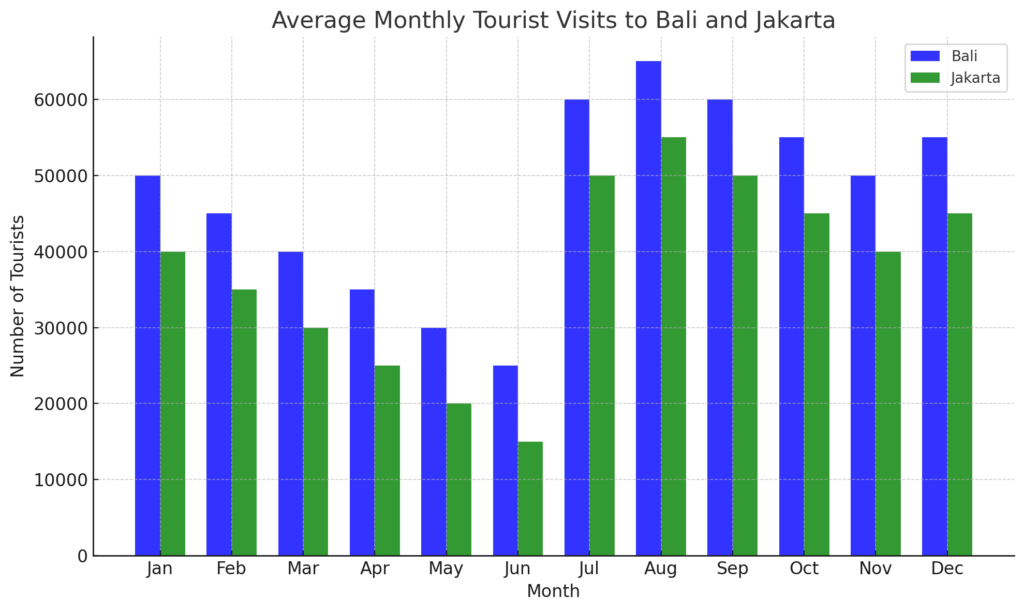
As you prepare to explore the enchanting Indonesian archipelago, let the magic of the islands inspire your journey, and may your travels be filled with unforgettable moments.
For the most current travel information and tips, the Indonesia Travel website is an excellent place to start.
Call to Action
Now that you’re ready to plan your trip to Indonesia, don’t forget to check out the latest travel deals and packages. Whether you’re looking for a luxurious resort stay in Bali, an eco-tour in Kalimantan, or a cultural excursion in Yogyakarta, there’s something for everyone.
We invite you to share your experiences, tips, or questions about traveling to Indonesia in the comments below. Your insights can help fellow travelers make the most of their Indonesian holidays.
Safe travels, and Selamat Jalan (have a good trip)!
Related Posts

Indonesia in February: Enchanting Escapes and Secrets
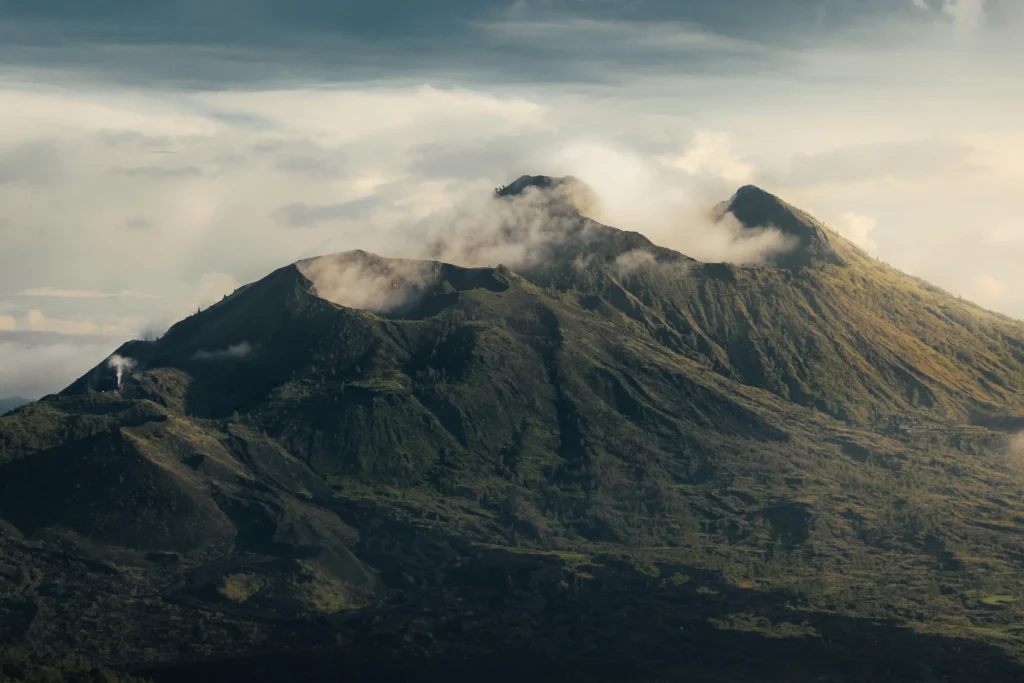
Bali Mountains: A Guide to Majestic Peaks and Cultural Treks
Leave a comment cancel reply.
Your email address will not be published. Required fields are marked *
Save my name, email, and website in this browser for the next time I comment.
Change location
- UK / International
- Call toll-free from 9am EDT
- 617-223-4521 617-223-4155 or
- REQUEST A QUOTE
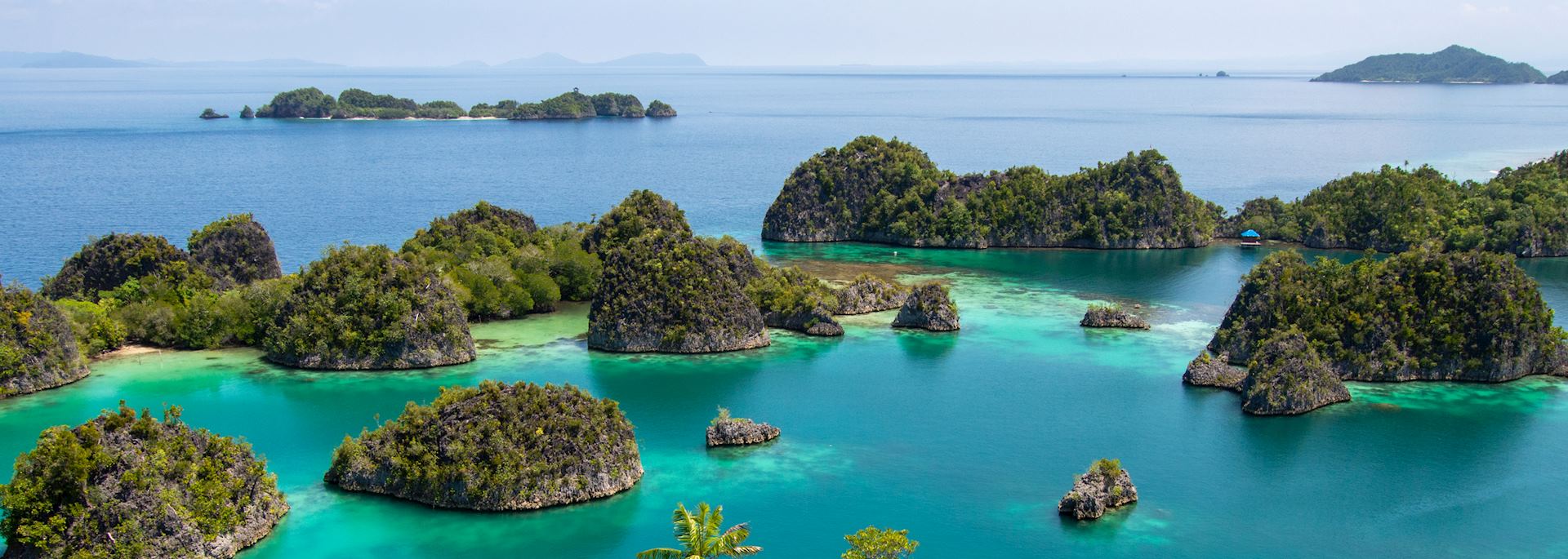
When is the best time to visit Indonesia?
- Month-by-month
The best time to visit Indonesia is between April and October, when the weather is perfect for island-hopping, snorkeling, and beach relaxation.
Bridging the Equator, Indonesia is hot all year round, with the only change coming between November and March when the country sees widespread rain, particularly in the south.
Although the rain may scupper your plans to relax by the beach, it does bring some pleasant changes. Indonesia’s rich collection of temples are often quieter at this time of year, making exploration much more rewarding. The scenery is beautiful, and if you venture into the highlands the temperatures are cooler, which can be a welcome change from the humid conditions on lower ground.
- Make an inquiry
- Request a brochure
Month-by-month guide for traveling in Indonesia
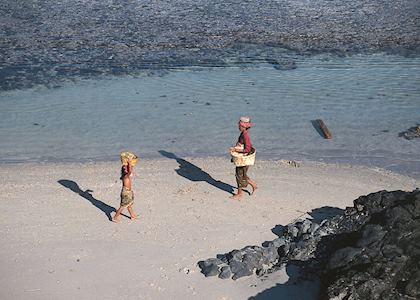
Visiting Indonesia in January
During January the rains are widespread across Indonesia, and although it's difficult to find some sun, you can still be lucky at this time of year. For guaranteed sunshine, it's best to head further north.
Events & Festivals
- Chinese New Year (date varies): As with many Southeast Asian countries, Chinese New Year is celebrated in Indonesia as a public holiday, with traditional festivals taking place throughout the country.
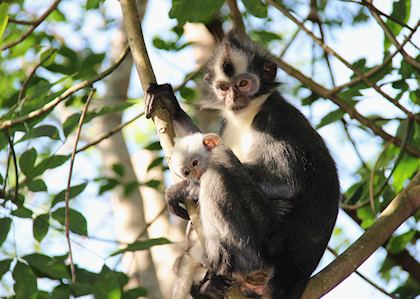
Visiting Indonesia in February
The sun is back out in northern Sumatra , where rainfall is at its lowest. However, the rest of Indonesia remains under rain clouds. Closer to the end of the month, the rains begin to subside and temperatures hover around the high 80°Fs.
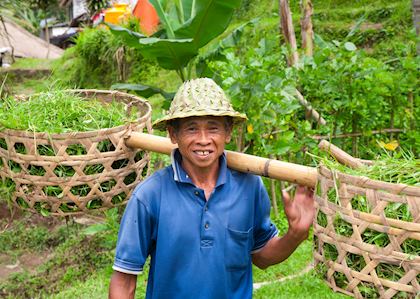
Visiting Indonesia in March
There is mixed weather throughout Indonesia as the sunshine is broken up by the occasional heavy downpour. That being said, you may be able to secure some low season bargains.
- Hari Raya Nyepi/Balinese Day of Silence (March): A Hindu celebration to mark the Saka New Year, it is a public holiday across the country as people fast and spend the day in silence and meditation.
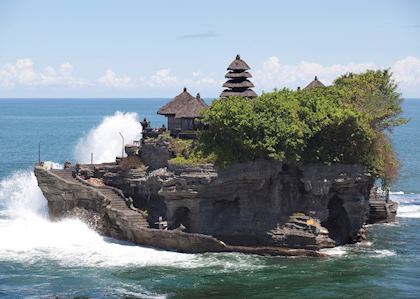
Visiting Indonesia in April
The sun returns to most of Indonesia, with Sumatra still seeing a little rain in the afternoons. Indonesia begins to get busy toward the end of the month so it's best to arrive early to avoid the crowds.
- Ramadan (exact dates vary): While the month of Ramadan may impact your daily routine as shops and restaurants close during the day, this is an exciting time to visit if you are fascinated by different cultures and religions.

Visiting Indonesia in May
Bali and Lombok receive some of their best weather for the year and beach goers flock to the area, making the most of the glorious sunshine and clear blue skies. The country continues to see hot and dry weather throughout, although the occasional shower is to be expected in some areas. This is a good time to spot orangutans as they come out to play in the forests, and you may be able to take advantage of shoulder season hotel promotions.
- Idul Fitri/Lebaran (May): A major two-day national holiday celebrated at the end of Ramadan as the breaking of the fast, also known as Eid al-Fitr in other Muslim countries. Families get together and enjoy a feast.

Visiting Indonesia in June
The beginning of June is quite possibly the best time to travel to Indonesia. If you go early enough you will miss the European school vacations, and you are almost guaranteed sunny weather throughout. Wildlife is also at its peak, making treks through the forests extremely rewarding.

Visiting Indonesia in July
This is peak season and the whole of Indonesia experiences hot, dry weather. With the school vacations in full swing and the sun nearly always shining, accommodations tend to get booked up far in advance and beach locations can feel a little crowded. Humidity in Kalimantan can make travel uncomfortable.
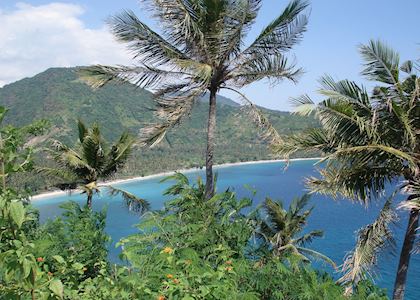
Visiting Indonesia in August
Peak season continues and August will see even more visitors than July; with the weather, wildlife and national parks all key attractions. Book early to avoid disappointment.
- Independence Day (August 17): A public holiday to celebrate the anniversary of Indonesia's independence, which was won from the Dutch in 1945. You can enjoy various festivities as the Indonesian flag flies high across the country.

Visiting Indonesia in September
September has the favorable weather conditions of August, but without the crowds and high season prices, making this a fantastic time to visit.
- Muharram 1/Islamic New Year (date varies): The Islamic New Year is celebrated throughout Indonesia with parades, festivals and prayer, making this an exciting but busy time to visit.
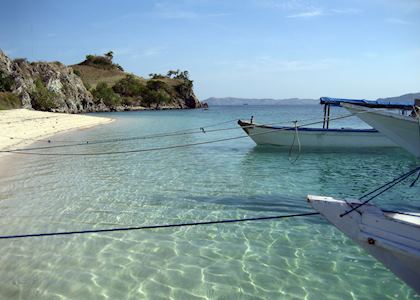
Visiting Indonesia in October
Enjoy the last of the sunshine before the wet season takes hold. Warm and sunny weather still dominates most of the region, although regular showers can be expected in some areas, worsening in intensity as the month draws on. Northern Sumatra , in particular, experiences one of its wettest months, which can affect roads. This can be a great time to grab a shoulder season bargain.

Visiting Indonesia in November
The rains return throughout Indonesia, but you may be lucky and experience the occasional burst of sunshine; particularly in Bali and northern Sulawesi . Temperatures still average around 86°F in most areas, but the rains mean that road conditions can be poor and the humidity can be stifling.
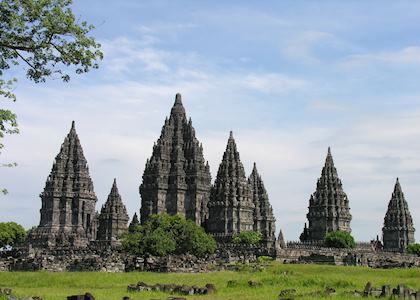
Visiting Indonesia in December
During December you are likely to experience rain and high humidity levels throughout Indonesia. With Christmas prices just around the corner, it may be best visiting early on in the month.
Indonesia Climate Guide
Why travel with audley.
- 100% tailor-made tours
- Fully protected travel
- Established for over 25 years
- 98% of our clients would recommend us

Travel advice
Practical tips for traveling to Indonesia, from social protocols to guidance on money matters, with a link to the latest US State Department travel advice.

Request our brochure
Covering all seven continents, The World Your Way shows you how you can see the world with us. It features trip ideas from our specialists alongside hand-picked stays and experiences, and introduces our approach to creating meaningful travel experiences.
Trip ideas and travel guides for exploring Indonesia

Bali uncovered
14 days from $3,200pp
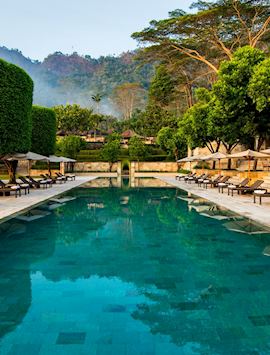
Luxury tour of Indonesia
16 days from $15,760pp
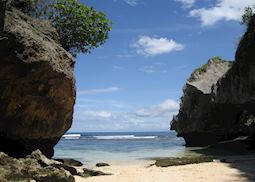
What to do in Bali: our highlights guide

Best beaches in Indonesia
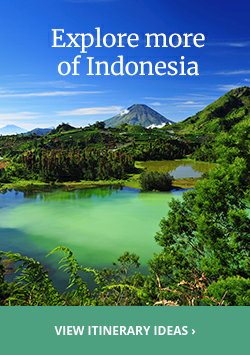
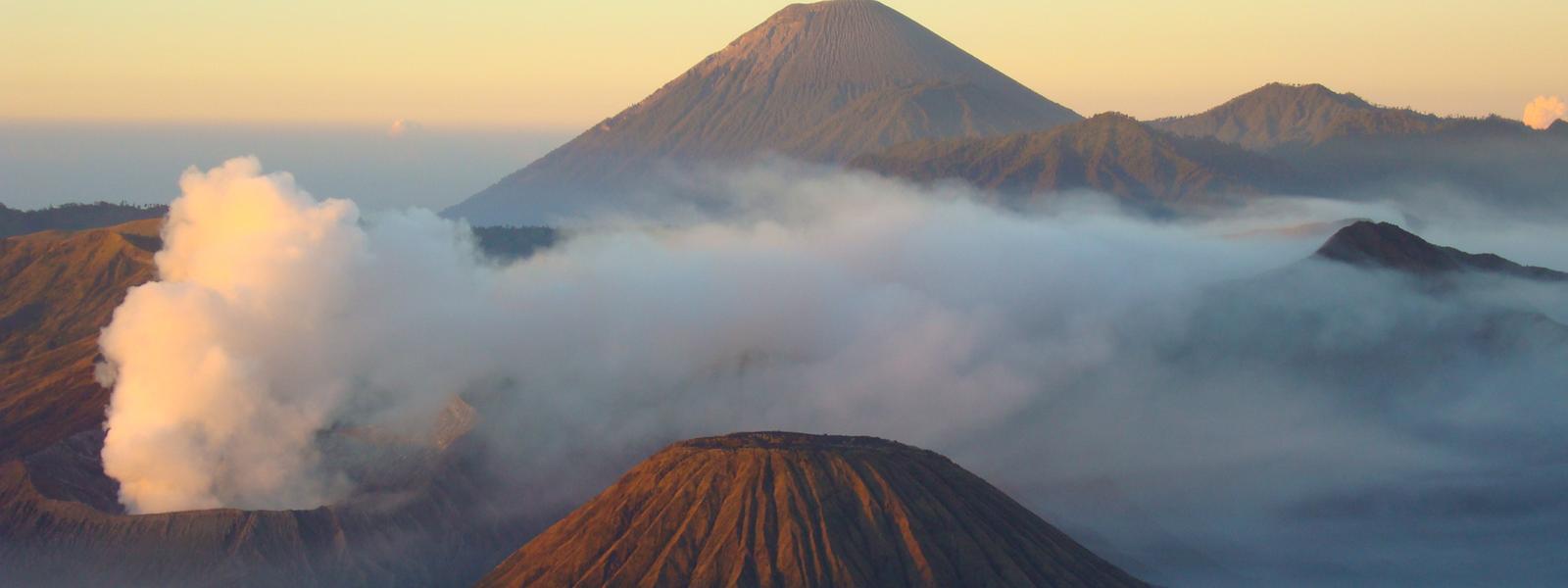
When to go to Indonesia
When is the best time to visit Indonesia?
With the westernmost point a full 3200 miles from the eastern most tip, so it should come as no surprise that summarising the weather in Indonesia is not straightforward. The tables below split the ‘country’ (made up of 17,508 islands) into two regions - the western & central islands and the eastern islands (that sit to the east of the Wallace Line), however we encourage you to read the more detailed summaries below as there can be significant variations in conditions between the islands within each group.
For the western and central Indonesian islands (such as Bali, Java, the Gilis, Lombok and Komodo), the best time to visit Indonesia is during dry season which spans from May to September and this is the most popular time to visit the country. The wet season is between October & April , with rainfall occurring in short, heavy bursts.
However, the eastern islands such as Sulawesi , West Papua, Raja Ampat and the Moluccas Islands drum to a different beat and mostly peak between March and May and again in October.
Temperatures remain fairly constant year round with averages of 28°C throughout the region.
Indonesia weather & when to go
Pick a month below, west and central islands, eastern islands.
Weather seasons are becoming less predictable but peak visitor months remain more certain.
Unfollow the herd - avoid the peak months to enjoy fewer crowds, better availability, often lusher countryside and help to spread the economic benefits of tourism.
Weather overview
Weather in Indonesia can be split into two seasons - wet and dry - with warm tropical temperatures averaging 28°C during the day, throughout the year. In most regions, the dry season spans from May to September, with the rains falling between October and April.
There are some regional exceptions. On Sumatra it rains from October to January in the north, and November to February in the south. Sulawesi , with its unusual shape, also experiences slightly different weather patterns and rainfall can be expected in the northern regions of the island during June and July.
Generally speaking, the best time of year to visit Indonesia is between May and September when the days are dry and sunny. However, during wet season temperatures remain high and rainfall comes in the form of intense tropical downpours that tend to last for a couple of hours and needn’t spoil your trip.
In some regions the difference between the two seasons is not extreme: Bali and Kalimantan , for example, are relatively unaffected by the season change, but the contrast typically grows as you travel further east into the Nusa Tenggara region (to the islands of Lombok, Flores and beyond) where there is a greater chance of flooding during the wet season and droughts in the dry.
It really depends on your travel plans: muddy back roads can be a problem during wet season if you intend to explore more off the beaten track locations and rough seas can render some islands inaccessible to smaller boats. The best months for diving off the coast of Bali , Lombok or the Komodo National Park are April to September , with rough seas particularly in January & February. If you plan to climb one of Indonesia's many volcanoes, such as Mt Bromo or Mt Rinjani, then dry season is recommended. Expect the temperature to cool as you climb, and pack some warmer layers.
Bali ’s dry season spans from April to September, with days characterised by blue skies and sunshine. The months of May, June and September are arguably the best time to visit, when the weather conditions are idyllic but visitor numbers are not at their highest, meaning the popular beach resorts of Jimbaran, Sanur and Seminyak are not too crowded.
Bali’s wet season falls between October and March, but we're talking brief tropical rainfall rather than days of monsoonal downpours. Temperatures in Bali are fairly consistent year round, ranging from 26°C - 29°C, although the central regions around Ubud and the mountains, such as Mt Batur, experience cooler temperatures and higher rainfall than the coastal regions.
The best time of year to visit the island of Java is during dry season which spans from May to September, when days are hot, dry and sunny. These months are also an ideal time to travel if you are planning on climbing the mountains of Bromo or Ijen.
Rainy season in Java runs from November to March, although East Java experiences less rainfall than the western regions. Days are characterised by regular, intense rain showers that tend to last for a couple of hours.
Temperatures are consistently warm year round, with average daily temperatures hovering around 28-30°C, although temperatures are cooler in the higher mountainous regions such as Mt Bromo, especially at night.
Nusa Tenggara
Lombok, flores, komodo national park, sumba.
The islands of Nusa Tenggara, including Lombok & the Gilis , Flores & Sumba , typically experience dry season between April and September with plenty of sunshine and blue skies. These months are an ideal time to travel if you are planning to climb Mt Rinjani or dive off the coast of Lombok, the Gili islands and in the Komodo National Park. Wet season falls between October and March, with November, December and January seeing the most rainfall.
Like the neighbouring island of Bali, the average temperature is fairly consistent year round across the Nusa Tenggara islands, ranging from 27-29°C.
Sumatra is a fairly large island, split by the equator and weather conditions vary slightly across the island. Medan and North Sumatra experiences a more tropical climate with the possibility of rain showers year round, especially in the jungle-clad areas such as Bukit Lawang. The heaviest rainfall in the north is typically between October and January. Palembang and South Sumatra experiences a more definite split between wet and dry season, with drier weather typically occurring between April and October and rainfall from November to March. Average temperatures hover around 27-28°C throughout the year, although highs of 33-34°C are not uncommon during the drier, summer months.
Kalimantan is a large island and weather conditions vary slightly across the island, with the southern regions being the driest and the rainforest-covered interior predictably the wettest.
The island experiences a light rainy season from March to May, with heavier rains falling between November and January. However, overall the rains on Kalimantan tend to be lower than neighbouring parts of Indonesia, such as the island of Java. Dry season spans from June until September, with August and September being the driest months of the year. Orang-utans can be spotted in the Tanjung Puting National Park throughout the year, although during rainy season they tend to be more elusive, preferring to shelter.
The temperature ranges from a warm 23°C at night to a hot 33°C during the day, with the hottest months typically May and August.
Sulawesi , with its peculiar shape, experiences different weather conditions depending on where you are on the island. In Toraja and the southern part of the island monsoon rains fall between November & April; whilst the city of Manado and the northern regions experience rainfall year round, with the driest months between July & October. Temperature-wise it can get very stuffy on the coast, with highs of 34°C, dropping to a positively brisk 24°C in the hills of central Sulawesi.
The Moluccas
Weather conditions across the central Molucca islands of Ambon and Seram differ from the rest of Indonesia. Between the months of June and September these islands experience rainfall and are best visited between the months of October and May. Weather patterns across the southern Molucca islands of Kei, Aru and Tanimbar, and the northern islands of Ternate, Tidore and Halmahera are similar to the majority of Indonesia. These islands are best visited between the months of May and September.
West Papua & Raja Ampat
West Papua and the islands of Raja Ampat can be visited year-round; there isn’t really an off-season. The region experiences reliably consistent daily temperatures. In Raja Ampat daily temperatures average between 30°C and 34°C throughout the year and rarely drop below 10°C at night. The ocean is warm year-round too. In the highlands of Wamena and the Baliem Valley, at an altitude of 2000m+ above sea level, temperatures are cooler and average between 20°C and 25°C throughout the year. A drop below 10°C at night in the Baliem Valley can be expected. Rainy season across the islands of Raja Ampat rather confusingly differs from the rest of Indonesia. Between the months of June and September there is a higher chance of rainfall and strong winds can be expected: not ideal conditions for boat journeys or diving. In the Baliem Valley, at altitude, showers can be expected year-round, with the wettest months of the year being May and June. However, rainfall in the region typically comes in the form of brief, heavy downpours as opposed to all-day monsoonal rain.
We think you may like this journey…
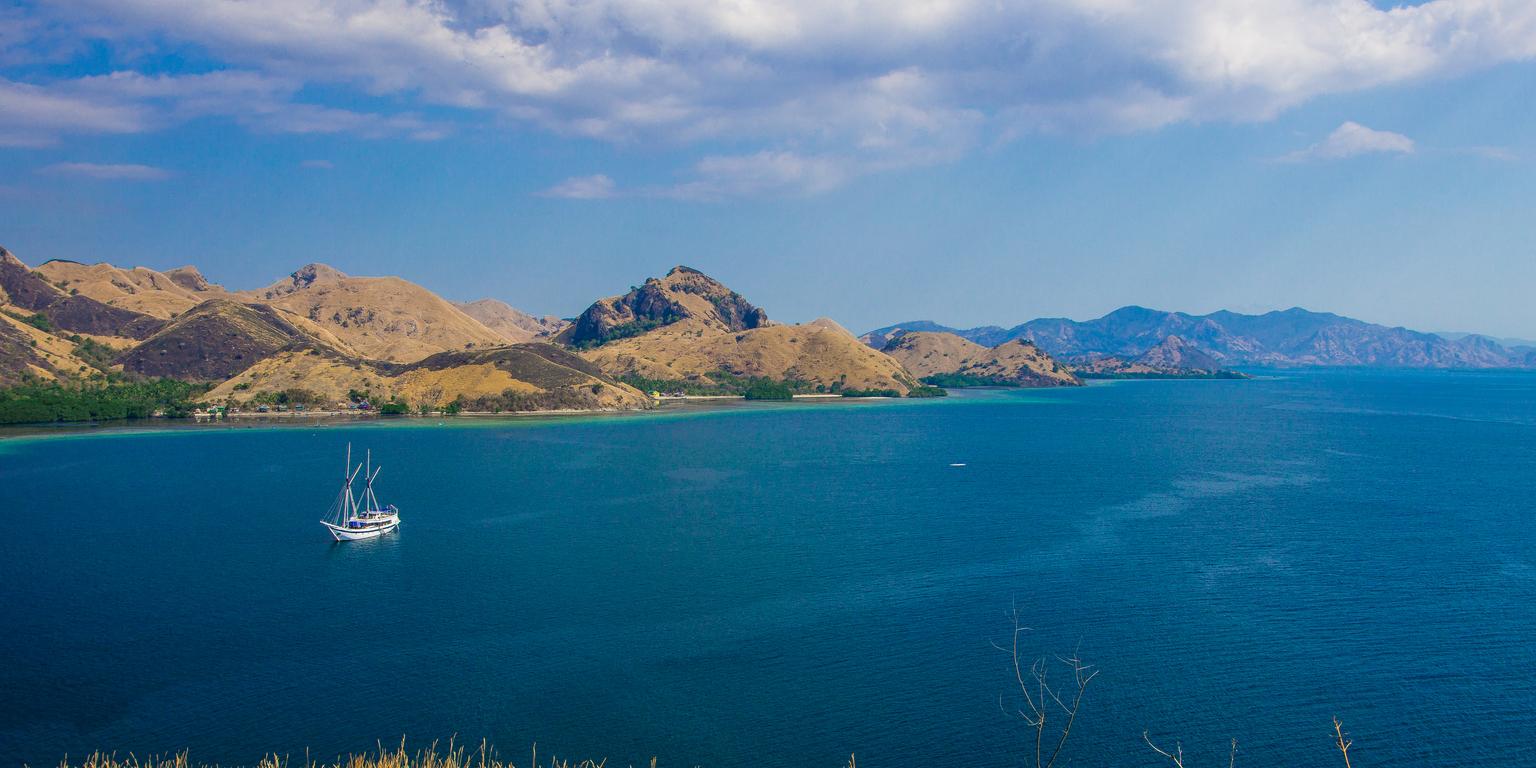
Indonesia Encompassed
From cruising the jungle waterways of Kalimantan’s rainforest and spotting orangutans, to soaking in the culture in Java to a few days relaxing on Bali and Komodo island - this is a trip full of beautiful contrasts in Java, Kalimantan, Bali and Komodo.
Looking for inspiration?
The Best Time to Visit Indonesia for Weather, Safety, & Tourism
The best times to visit Indonesia for ideal weather are
July 23rd to August 19th
September 3rd to october 7th.
based on average temperature and humidity from NOAA (the National Oceanic and Atmospheric Administration). Read below for more weather and travel details.
Indonesia Travel Guide
Temperature.
- Perceived Temperature
- Rain and snow
- Humidity and wind
- The busiest and least popular months
- Overall travel experience by time of year
Other Indonesia Travel Info
Weather in indonesia.
Average temperatures in Indonesia vary barely at all. Considering humidity, temperatures feel hot all year with a chance of rain throughout most of the year. The area is far less temperate than some — in the 3rd percentile for pleasant weather — compared to tourist destinations worldwide. Weeks with ideal weather are listed above . If you’re looking for the very warmest time to visit Indonesia, the hottest months are October, May, and then November. See average monthly temperatures below. The warmest time of year is generally mid October where highs are regularly around 89.8°F (32.1°C) with temperatures rarely dropping below 74.1°F (23.4°C) at night.
Indonesia Temperatures (Fahrenheit)
Indonesia temperatures (celsius), “feels-like” temperatures.
The way we experience weather isn’t all about temperature. Higher temperatures affect us much more at higher humidity, and colder temperatures feel piercing with high winds. Our perceived temperatures factor in humidity and wind chill to better represent how hot or cold the day feels to a person.
Indonesia Perceived Temperature (F)
Indonesia perceived temperature (c), average indonesia temperatures by month.
Daily highs (averaged for the month) usually give the best indication of the weather. A significantly lower mean and low generally just means it gets colder at night.
Show Fahrenheit
Show celsius, precipitation (rain or snow).
If dry weather is what you’re after, the months with the lowest chance of significant precipitation in Indonesia are September, August, and then July. Note that we define “significant precipitation” as .1 inches or more in this section. The lowest chance of rain or snow occurs around late September. For example, on the week of September 24th there is 1 day of precipitation on average. By contrast, it’s most likely to rain or snow in mid December with an average of 2 days of significant precipitation the week of December 17th.
Chance of Precipitation
The graph below shows the % chance of rainy and snowy days in Indonesia.
Snow on the Ground
The graph below shows the average snow on the ground in Indonesia (in).
Average Rain and Snow by Month
Show inches, show centimeters, humidity and wind.
Indonesia has some very humid months, and high humidity throughout the year. The least humid month is September (70.4% relative humidity), and the most humid month is December (78%).
Wind in Indonesia is usually extremely calm . The windiest month is August, followed by September and July. August’s average wind speed of around 4.5 knots (5.1 MPH or 8.3 KPH) is considered “a light breeze.” Maximum sustained winds (the highest speed for the day lasting more than a few moments) are at their highest in early August where average top sustained speeds reach 9.5 knots, which is considered a gentle breeze.
Relative Humidity (%)
The graph below shows the average % humidity by month in Indonesia.
The graph below shows wind speed (max and average) in knots.
Average Wind Speeds
Show wind speeds.
All wind speeds are in knots. 1 knot = 1.15 MPH or 1.85 KPH.
Show Relative Humidity by Month
Is it safe to travel to indonesia.
Our best data indicates this area is somewhat safe, but with extra warnings in a few regions. As of Dec 04, 2023 there are travel warnings and regional advisories for Indonesia; exercise a high degree of caution and avoid some areas. Check this page for any recent changes or regions to avoid: Travel Advice and Advisories . This advisory was last updated on Nov 14, 2023.
The Busiest and Least Crowded Months
The busiest month for tourism in Indonesia is May, followed by August and July. Prices for hotels and flights will be most expensive during these months, though you can save if you purchase well in advance. Tourists are unlikely to visit Indonesia in December. Those willing to visit at these times will likely find it the least expensive month.
Estimated Tourism by Month
Most popular months to visit, overall indonesia travel experience by season, fall (march through may).
Humidity and temperatures combine to make this season feel warm. Highs range from 88.9°F (31.6°C) and 87.9°F (31.1°C) with similar temperatures in the later months. Rain is somewhat common with 6 to 8 days of significant precipitation per month. Fall is the second busiest for tourism, which makes it a good time for those looking for things to do.
Winter (June through August)
The middle-year months have very comfortable weather with high temperatures that are quite warm. These months see the least precipitation with 4 to 6 days of precipitation per month. June – August is the busiest season for tourism in Indonesia, so lodging and other accommodations may cost more than usual.
Spring (September through November)
Spring daily highs range from 89.8°F (32.1°C) and 88.2°F (31.2°C), which will feel very nice given the humidity and wind. It rains or snows a significant amount: 4 to 8 days per month. Tourism is the slowest during these months due to the weather, so hotels may be affordably priced.
Summer (December through February)
Weather is perfect this time of year in Indonesia to be enjoyable for warm weather travelers. The average high during this season is between 88.3°F (31.3°C) and 87.2°F (30.7°C). On average, it rains or snows a fair amount: 8 to 10 times per month. These times of year are fairly slow with tourists.
Best Times to Travel › Indonesia
Similar Destinations
- Karimunjawa Islands, Indonesia
- Jepara, Indonesia
- Kudus, Indonesia
- Demak, Indonesia
- Pati, Indonesia
- Pekalongan, Indonesia
- Semarang, Indonesia
- Kedungwuni, Indonesia
- Pemalang, Indonesia
- Taman, Indonesia
Popular Destinations
- Orlando, FL, US
- Calpe, Spain
- Karon, Thailand
Best time to visit Indonesia

The best time to visit Indonesia is from May to September when the country experiences the dry season. However, if you’re looking to catch the best sets, the best time for surfing is the shoulder season from April to June before the peak season crowds arrive. Indonesia’s wet season falls from October to April, sometimes impacting travel plans as roads can flood with heavy rainfall.
Another thing to consider before planning your holiday is that there is a large Muslim population in Indonesia that celebrates Ramadan (dates vary every year). During this time, many services and activities may be closed, so the country may be quieter than at other times of the year.
Let's create an exclusive trip for your group.
The best time for a trip to Bali is typically from May to September. Just like the rest of Indonesia, Bali’s temperatures hover around the low 30s for most of the year, however, heavy rainfall will occur from November to April. For most people, Bali is the quintessential beach holiday, so it makes sense to visit for the least rainfall and the best visibility for snorkelling and diving. If you’re looking for crowded bars, brimming restaurants and lively beaches, the peak season between July and August will have high visitor numbers, especially from nearby Australia. However, if you’d prefer a quieter trip, the shoulder months between March to June and September to November will have fewer crowds due to the absence of school and Christmas holidayers.
The best time to visit Lombok is usually when the surfing is at its best which occurs from November to March, especially in Kuta. This is the area’s wet season so it may not be suitable for all other activities, however, this part of the country has gained recent popularity for its vast assortment of varied day and night activities. Those looking to explore the outdoors can trek, snorkel and dive, preferably when visibility is better and paths are drier during the dry months of June to August. However, those looking to party long into the night should look to the nearby Gili Islands which are lively at most times of the year (especially for Bintang drinking).
The best time to visit Jakarta is in the dry season, from June to September, when there's a smaller chance of being caught in the rain. Jakarta is the country’s hub for history and culture. You can find many great museums including the Maritime, Balai Seni Rupa (fine arts), Wayang (puppetry) and National Museums. With sunny weather, participate in walking tours through the Sunda Kelapa port and into Fatahillah Square to see the monuments and diverse cultures that blend together, creating this amazingly lively city.
Best for: fewer crowds, travels to West Papau and Maluku, Grebeg Sudiro (Chinese New Year)
Every Indonesian new year starts right in the middle of the country’s rainy season. While it won’t rain 24/7, intense rain will come and go in most regions, so bringing waterproof clothes is essential! Although the rainy season does impact most of the country, some regions in the East (the West Papua province and the Maluku Islands) won’t be as drenched. At this time the country will be much quieter, perfect for a relaxing Indonesian holiday .
Best for: a quieter atmosphere, Lailat al Miraj (Night of Ascension), Cap Go Meh (last day of Chinese New Year), Pasola
Indonesia might not be as picture-perfect during the rainy season, but it does come with the bonus of fewer contenders for beach space and smaller lines at hot spots. If you’re interested in a unique moment of Indonesian culture, why not visit Sumba for the ritual battles on horseback known as Pasola?
Best for: beach stays and day trips, Java Jazz Festival, Nyepi (Day of Silence)
Bali holds its annual Day of Silence in March. This day, known as Nyepi, will essentially shut down the entire island for a day of internal reflection and to ward off negative energy for the start of the new year. Any visitors to Bali will also be impacted by this tradition and should take note that the date changes every year. Outside Bali, the country has a vast range of offerings perfect for May. Why not visit Candi Borobudur (the largest Buddhist structure on earth) in Yogyakarta or learn about the coffee, cocoa and palm industries in Java ?
Best for: hiking, diving and wildlife excursions, yoga retreats, Kartini’s Day, Good Friday, Bali Spirit Festival
You know what they say about the shoulder season… it’s the best time to visit anywhere! April falls right at the last stages of the rainy season and before the mid-year tourism crowds. While rain is still likely to come on and off, the change in weather can mean better conditions for outdoor fun such as hiking the mountains, diving the reefs and visits to wildlife sanctuaries. April also hosts a celebration day of the women’s rights activist Raden Ayu Kartini and the Bali Spirit Festival which combines the joys of yoga, dancing and music.
Best for: snorkelling and diving, beach-going, National Awakening Day (celebrates Indonesian identity), Budda’s birthday, Ascension Day
Put away the umbrellas and pull out the sunhats, the dry season is here. With the reduced rainfall, temperatures will sit around the high 30s and improve visibility, especially while snorkelling or orangutan spotting . The dry season is recommended for most travellers due to the good weather, but if you'd prefer it slightly quieter, venture to the country in May before the school holiday crowds arrive. There are also some important dates in the Indonesian calendar this month, including National Awakening Day, Buddha’s birthday and Ascension Day.
Best for: rice paddy exploration, temple visiting and pool dipping, animal spotting, Eid al-Adha (Feast of Sacrifice)
Whether you want to calm your senses or up your pulse on a hike, June has exactly what you need. This time of year will be great for meandering through rice paddies in Ubud, reflecting at temples or alternatively, diving with the whale sharks off West Papua. But if the jungle is more your calling, look out for some of Indonesia's famous native flora including the Sumatran tiger, orangutan, sun bear and tree kangaroos. Maybe you'll spot the varied bird life and their impressive reptile species (see Komodo dragon) within the greenery or just hanging around the islands too.
Best for: beaches, monument sighting, market shopping, Solo Batik Carnival in Java, Islamic New Year, Festivals of Flower and Fruit
July is bustling in Indonesia. The lively roster of events, particularly the Festivals of Flower and Fruit, Solo Batik Carnival (Java) and Islamic New Year will fill the streets with celebrators, while the perfect weather invites international travellers to the beaches and landmark sites. Split your time between laying under the warm Indonesian sun and venturing out to lively traditional markets (open day and night), learning about local produce or ticking off stunning natural locations –such as the Munduk waterfall and Gili Islands – from your must-see list.
Best for: hiking, sunny beaches, boating outings, Galungan dan Kuningan, Independence Day, The Balinese holiday Galungan dan Kuningan
No matter if you prefer the jungle to the mountains or the city to the beach, the climate in August makes it a perfect time to travel to your style. Hiking trails are dry and the beaches are bustling, so if you’d prefer to stay out of the rain but don’t mind crowds, this month is your best bet for a good time. Hop on a boat tour for a different view of the islands or get up with the sun to see spectacular sights from the top of Mt Bromo . Bars are likely to be busy at this time of year and there's plenty on offer for family days out, too.
Best for: bike tours, surfing, Lake Toba Festival, Erau biennial cultural festival
Surf the days away in sunny September. Or, for those more land-based, why not bike through Bali or combine the two on an active adventure through three of Indonesia’s hot spots? This month’s weather is great for all things action, relaxation and exploration. You’ll also be able to watch the 5-day Lake Toba Festival in Northern Sumatra , which is a unique celebration of the year’s blessings complete with sport, dancing and art.
Best for: cultural activities, animal encounters, Batik Day, Ubud Writers & Readers Festival
October marks one of the last dry months in the calendar year. Often during this time, farmers around Sumatra and Kalimantan will begin burning fields which can cause air pollution due to the smoke and haze. The weather can also be a little touch-and-go due to the incoming wet season, so try to reach the orangutan and wildlife sanctuaries before the animals hide away from the rain. There are also some great festivities in October such as the Ubud Writers & Readers Festival or the celebration of batik, a traditional cloth originating in Java.
Best for: gallery hopping, museum visits, Jakarta Fashion Week
If crowds aren’t your style and you’re interested in both indoor and outdoor offerings of Indonesia, November may be the way to go. While the weather is perfect for exploring temples, museums and markets, you’ll still be able to lounge by the pool or beach – just maybe sit near an umbrella as it is very close to the rainy season. Jakarta also hosts their Fashion Week in November (the largest in Southeast Asia), so it's a great time for appreciating the artisans and creators of the country in the many galleries and museums.
Best for: holiday fun, cooking classes, yoga, spa days, Djakarta Warehouse Project
Okay, now the wet season has officially started. You can enjoy the peace of Indonesia with fewer visitors for most of the month. However, the country does see an influx of visitors for Christmas, New Year’s and the Djakarta Warehouse Project dance festival. While the wet season can put a damper on things (pun intended), the rain usually comes in sudden heavy showers, so it may not be the best time for hiking. If the weather doesn't allow outdoor expeditions, why not partake in a cooking class, yoga session or a wind-down at one of Indonesia’s many spas?
Best time to visit Indonesia
Weather in indonesia.

July-August (High Season)
May-june & september (shoulder season), october-april (low season).

Best Time to Go to Bali

Best Time to Travel to Java
Want to go, top indonesia travel destinations.
- Ambon Island
- Wayag Island
Indonesia Trips by Departure Date
- 2024 Indonesia trips (41)
- 2025 Indonesia trips (33)
- 2026 Indonesia trips (5)
- May 2024 (16)
- June 2024 (20)
- July 2024 (17)
- August 2024 (19)
- September 2024 (16)
- October 2024 (16)
- November 2024 (17)
- December 2024 (16)
- June 2025 (13)
Top Experiences in Indonesia
- Indonesia Cruises (38)
- Indonesia Beaches (13)
- Indonesia Cultural (13)
- Indonesia Land Tours (10)
- Indonesia Wildlife & Safari Exploration (4)
- Indonesia Most Popular (3)
- Indonesia Trekking (3)
Indonesia Trips by Duration
- 5 day trips (4)
- 8 day trips (5)
- 10 day trips (6)
- 12 day trips (8)
- 13 day trips (5)
- 14 day trips (3)
- 15 day trips (4)
- 19 day trips (3)
Indonesia Trips by Activity
- Indonesia snorkeling (40)
- Indonesia small ship cruises (35)
- Indonesia village visits (33)
- Indonesia wildlife viewing (29)
- Indonesia kayaking (12)
- Indonesia local market visits (10)
- Indonesia stand up paddle boarding (9)
- Indonesia hiking (8)
- Indonesia spa relaxation (4)
Why Travel With Adventure Life
Recognized by.

- Indonesia Tours
- Indonesia Travel Guide
- When to Visit Indonesia
Best Time to Visit Indonesia
- Jan Avg Daily: 30 ° C Avg Nightly: 26 ° C
- Feb Avg Daily: 30 ° C Avg Nightly: 26 ° C
- Mar Avg Daily: 31 ° C Avg Nightly: 26 ° C
- Apr Avg Daily: 32 ° C Avg Nightly: 26 ° C
- May Avg Daily: 32 ° C Avg Nightly: 26 ° C
- Jun Avg Daily: 32 ° C Avg Nightly: 26 ° C
- Jul Avg Daily: 31 ° C Avg Nightly: 26 ° C
- Aug Avg Daily: 32 ° C Avg Nightly: 26 ° C
- Sep Avg Daily: 32 ° C Avg Nightly: 26 ° C
- Oct Avg Daily: 33 ° C Avg Nightly: 27 ° C
- Nov Avg Daily: 32 ° C Avg Nightly: 26 ° C
- Dec Avg Daily: 31 ° C Avg Nightly: 26 ° C
- 1.11K views
- ~ mins read
With an almost entirely tropical climate, the best time to visit Indonesia is during its dry season, from April to October, when the temperatures are warm and the rainfall is minimal. The volcanoes, beaches, jungles, cultural treasures and a reputation for friendly hospitality make Indonesia one of the most popular places for tourists to visit in Asia, but make sure you go at the right time! With clear skies and low humidity, the dry season bathes the nation in sunshine, making it ideal for beachgoers, island hoppers and water sports enthusiasts. There are upsides to the wet season too though, so read on to find out!
For a detailed guide on the ideal time to tour Indonesia , keep reading!
- Marcella DePaola
Quick Facts
Seasonal overview.
Looking for a comprehensive guide on the best time to travel to Indonesia? Check out our seasonal breakdown.
Dry season in Indonesia: April to October

Indonesia's dry season spans from April to October and offers ideal weather for outdoorsy travelers. During these months, the country enjoys lower humidity and minimal rainfall, making it an excellent time for beach trips, adventure sports like trekking and white water rafting, exploring wildlife, or climbing mountains like Mount Bromo. With sunny skies and temperatures ranging from 27°C (80°F) to 32°C (90°F) on average, the dry season is the best time to visit Indonesia. However, this is also the peak season for most travelers, which means you will find higher rates and more crowds.
Highlights:
- Explore the world-famous pristine shores of the Gili Islands or take a beach trip to Flores Islands . Enjoy water sports like white water rafting, surfing, scuba diving, swimming and more.
- Tour volcanoes in Java and even climb iconic volcanoes such as Mount Rinjani for breathtaking sunrise views and a unique hiking experience.
- Discover the incredible underwater world in destinations like Raja Ampat, Komodo National Park, and Bunaken Marine Park.
- Head to Borneo to visit orangutan sanctuaries or see native wildlife in their natural habitat, or visit Bali Safari and Marine Park for a family-friendly wildlife encounter.
- Take advantage of the dry season. The best time to visit Bali for adventures like climbing Gunung Agung, hiking Mount Batur, or catching a wave in Kuta Beach.
Travel Tips:
- Dry season is the peak tourist season in Indonesia. Expect heavy crowds and higher rates. Book accommodation in advance.
- Keep your belongings safe and watch out for pickpockets.
- Indonesia’s sun can be quite strong. Don’t forget your sunscreen, hat and other coverings!
- Embrace the food and cultures of the region. Don’t be scared to taste local delicacies and street foods (with caution!).
In-depth seasonal guides: Indonesia in April Indonesia in May Indonesia in June Indonesia in July Indonesia in August Indonesia in September Indonesia in October Summer in Indonesia
Wet season: November to July

The wet season is equated with the low season in Indonesia for tourism. There is generally rain all around the country except in Papua and Maluku, where it is the summer season. It can be difficult for visitors to take the oceanic route between the different islands in this season, and the constant rain means that some interior roads might become inaccessible. Even though it is the low season, expect crowds around Christmas and New Year. Despite the chances of rain, the wet season is the best season to visit Indonesia to go sightseeing and take part in local festivals because the crowds are so minimal and the costs can be lower.
- Explore Indonesia’s rich cultural heritage by attending traditional ceremonies like Nyepi, dance performances, and festivals like the Bali Arts Festival and Waisak.
- Visit Tumpak Sewu in East Java or Sekumpul Waterfall in Bali, where the rains create stunning cascades.
- Indulge in rejuvenating spa treatments and yoga retreats, often at lower prices.
- Visit bustling local markets in Jakarta and savor Indonesian street food like siomay and batagor. Many markets are covered and the rain adds to the cultural experience.
- Immerse in quaint historical sightseeing as you explore Yogyakarta and its temples like Borobudur and Prambanan.
- Celebrate the Chinese New Year around January/February with a string of traditional festivals and parades—especially in Jakarta.
- Join “Hari Raya Nyepi”—a unique festival also known as Balinese Day of Silence. Celebrated in March, this holiday is celebrated by the entire country by spending the day in silence, with a lot of feasting.
- Enjoy lower crowds and cheaper travel fares as these months are low tourist season.
- Rain in Indonesia can be extreme. Carry raincoats, umbrellas or waterproof clothing.
- Don’t forget mosquito repellent.
- Take advantage of cheap accommodations, fewer crowds, and travel fares.
In-depth seasonal guides: Indonesia in November Indonesia in December Indonesia in January Indonesia in February Indonesia in March Winter in Indonesia
To learn more on the best season to visit Indonesia, read our comprehensive Indonesia travel guide for a month-to-month travel insight, things to do and how many days to spend in Indonesia . If you’re planning a trip, talk to our travel experts to create your customized trip to Indonesia .
AVERAGE ANNUAL TEMPERATURE OF POPULAR DESTINATIONS IN INDONESIA
Related articles.
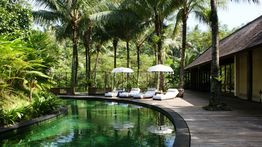
Indonesia in January: All You Need to Know
When considering a trip to Indonesia in Janua... read more

Indonesia in February: All You Need to Know
Indonesia is the largest island country stret... read more

Indonesia in March: Weather, Travel Tips & More
A trip to Indonesia in March starts seeing a ... read more

Indonesia in April: Must-know Tips for Travelers
Visit Indonesia in April and you will find a ... read more
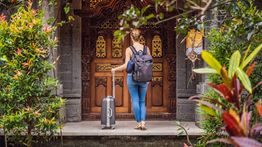
Indonesia in May: All You Need to Know
Good weather across Indonesia makes May one o... read more

Indonesia in June: What to Expect and Where to go!
A trip to Indonesia gears you up for the peak... read more
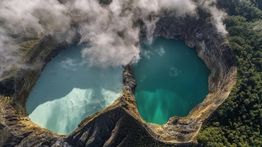
Indonesia in July: All You Need to Know
July in Indonesia is all about warm, dry weat... read more
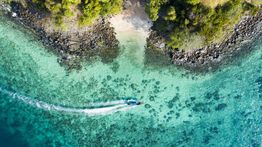
Indonesia in August: Weather, Tips and More
Set out on a tour of Indonesia when the weath... read more

Indonesia in September: All You Need to Know
Embark on an exhilarating trip to Indonesia i... read more
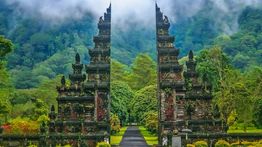
Indonesia in October: Getting Around Rainy Season Hassles
October marks the beginning of the monsoon se... read more
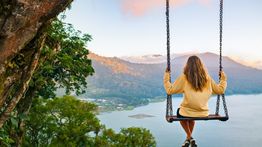
Indonesia in November: Warm Weather & Clear Beaches
Indonesia may be considered far from an ideal... read more

Indonesia in December: A Rainy Aesthetic
December marks the start of the rainy season ... read more
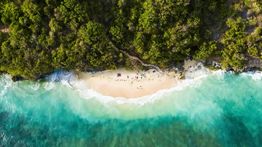
Summer in Indonesia: Tips for the Dry Season
Indonesia is home to a unique culture and bre... read more
Related Categories
- Bali Travel Tips
- How Long To Stay In Indonesia
- Indonesia Travel Advice
- Islands In Indonesia
- Treks And Hikes In Indonesia
- What To Do In Indonesia
- When To Visit Indonesia
- Where To Go To Indonesia

Popular Destinations
- Europe Tours
- Everest Base Camp Trek
- Italy Tours
- Spain Tours
- Argentina Tours
- Canada Tours
- Sri Lanka Tours
- Chile Tours
- Antarctica Tours
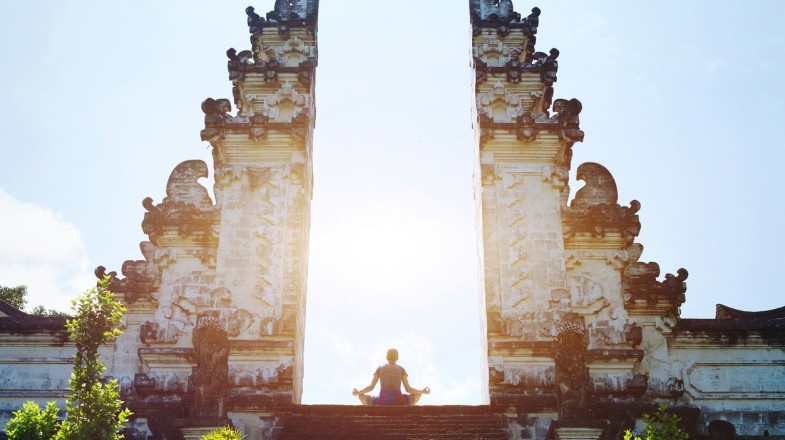
Best Time To Visit Indonesia
What is the best time to visit indonesia.
The best time to visit Indonesia is during its dry season from mid-April to September. The weather in this tropical country can be split into two seasons - dry and wet. Indonesia experiences its wet season in the remaining months from October to mid-April. The dry season has warm, sunny and dry days that offer the perfect conditions for trekking, sightseeing or other water-related activities. May, June and September are the ideal months to visit Indonesia if you wish to combine the excellent weather of the dry season with the lack of tourist crowds. In regions like Kalimantan and Bali, the difference between the dry and wet season is not as extreme. The central Molucca islands experience contrastingly different weather conditions and make for a suitable destination if planning a trip in January. Temperatures throughout Indonesia are relatively consistent and hover around 28 degrees Celsius, irrespective of the time of the year. A surge in tourists is witnessed from mid-June to mid-September, whereas the wet season sees a drastic drop in tourist activity.
Indonesia Travel Packages
Compare quotes from upto 3 travel agents for free
Bali Best Tour Packages with Kuta & Seminyak - Bali Swing
Bali honeymoon package for 7 days - gili trawangan.
Bali Indonesia Tour Package with Scuba Diving
Couples Paradise Bali Gili Honeymoon Package
Singapore bali tour package - 6 nights, bali honeymoon package with stay at private pool villa suite & aromatherapy spa, more about best time to travel to indonesia, seasons of indonesia, regions of indonesia, dry season in indonesia (mid-april to september).
- Bali Nyepi Day is celebrated as the Hindu New Year in March/April every year. The exact date depends on the Balinese calendar.
- Waisak is observed on a full moon day in either May or June. The enlightenment and death of Buddha are widely celebrated by thousands of pilgrims and monks.
- The Yogyakarta Festival takes place around June. The events include plenty of exhibitions and shows.
- The Bali Arts Festival occurs around June or July. Artists from all remote corners of the country gather here to take part in an evening of classical and contemporary dances.
- The Jalan Jaksa Festival takes place in Jakarta. It is celebrated around July and includes food stalls, street artists, craft workshops and musicians.
- The Bali Kite Festival is an annual event that takes place on Sanur Beach in Bali. Locals make traditional giant kites and fly them in an annual competition.
Wet Season in Indonesia (October to mid-April)
- The Bau Nyale festival is celebrated around February or March. It is a huge fishing festival and most locals rush to Lombok hoping to catch a glimpse of the first nyale.
- The Toraja Funeral Ceremony is an ancient funeral rite that aims to enable the passage of the spirit of the dead into the afterlife.
- The Baliem Valley Festival is unique to the locals of Papua. It is a mock war among all the local tribes.
- The Kesodo ceremony sees thousands of Tenggerese gathering at the popular Mount Bromo to pray for another year without any eruptions.
Best time to visit the top destinations in Indonesia

Best Time to Visit Bali
Best Time to Visit Yogyakarta
Best Time to Visit Gili Trawangan
Best Time to Visit Gili Air
Best Time to Visit Nusa Penida
Best Time to Visit Komodo Island
Tourist Places to Visit In Indonesia

Gili Trawangan

Nusa Penida

Komodo Island
Browse Package Collections
Indonesia package collections.
Indonesia Honeymoon Packages
Top Destinations for Packages
Nusa Lembongan
Nearby Countries for Packages
Philippines
Top Listed Packages
Wonderful Adventure Bali Package Deal - 6 Nights 7 Days
Budget Bali Indonesia Tour Package from India
Stunning All Inclusive Bali Package - 5 Nights
Nearby Countries

Get the best offers on Travel Packages
Compare package quotes from top travel agents
Compare upto 3 quotes for free
- India (+91)
*Final prices will be shared by our partner agents based on your requirements.
Log in to your account
Welcome to holidify.
Forget Password?
Share this page

- Travel Style

- Family Trips

- Couples & Friends

- Expeditions & Off Beaten Trips

- Adventure & Sport

- Shared Trips & Join Our Groups

- Offers & Last Minutes Deals

- Interest & Activities

- Photography

- TOUR SEARCH
- POPULAR TOURS
- RECOMMENDED TOURS
- BOOK FLIGHTS, FAST BOATS, TRANSFERS
- TAILOR-MADE TOUR
- TRAVEL BLOG
- INDONESIA TRAVEL GUIDE
- MICE TOURISM

- LARGE GROUPS & SPECIAL EVENTS

- TRAVEL AGENCIES - B2B

- Tour Search
- Tailor-Made Tour
- Large groups & Special events
- Travel Agencies – b2b

When to travel to Indonesia by destinations and months: The weather, the best time, high season
Planning to travel to Indonesia in the Summer or Christmas? Looking for the best time with less crowds? If you are planning your trip to Indonesia, but still not sure when is the best time to travel to Indonesia, in this post we help you solve all your doubts.
When is the best time to travel to Indonesia?
Although Indonesia is an excellent travel destination all year round, offering memorable experiences for all types of traveler, you could roughly say that the best time to travel to Indonesia is between April and October.
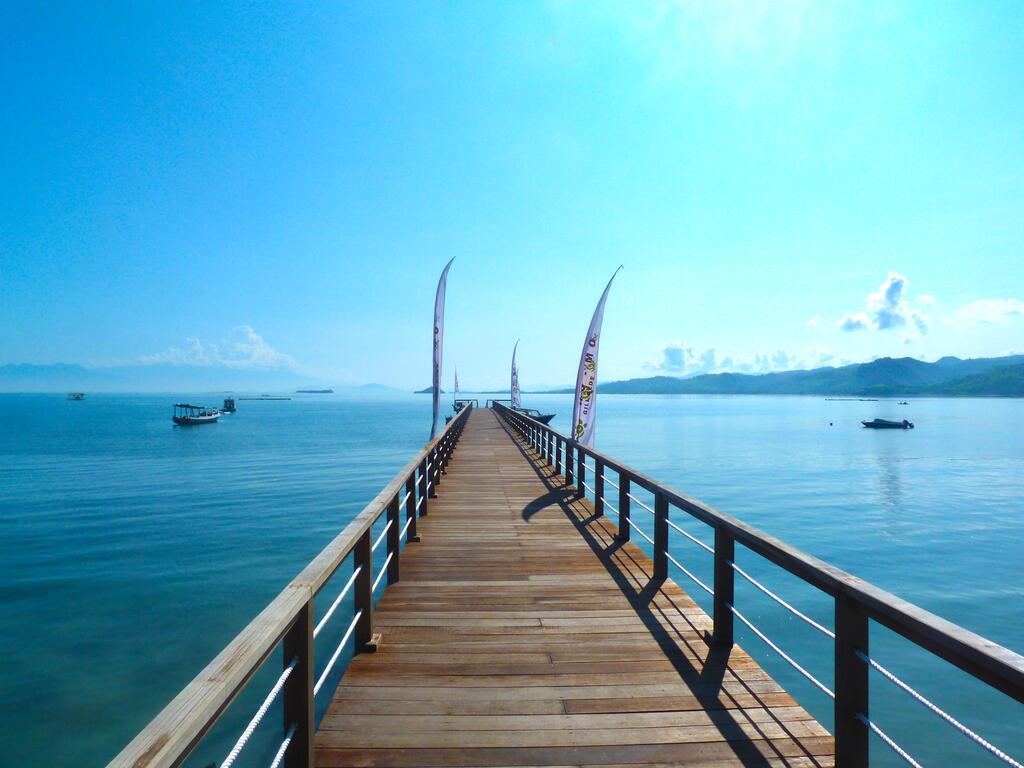
“ The best time to travel to Indonesia is between April and October”
In terms of tourist seasons, the best time to travel to Indonesia is during the shoulder season, which includes the months of May, June and September. During these months, the temperature is very pleasant and the tourist areas are less crowded.
The off-season in Indonesia, that extends from October to April, is also the rainy season. During these months, you can find some accommodation deals, and you can make the most of the diving season in Papua and the Moluccas Islands. If you are not afraid of rain, the downpour tends to happen during the afternoons, so you can spend the rest of the day visiting the country without an umbrella.
During the high season of Indonesia, particularly the months of July and August, the country receives the largest wave of tourists. For this reason, prices can increase considerably. Plus, you’ll need to be prepared to deal with crowds when visiting some of the most popular tourist sites.
If you are looking to travel to Indonesia in a more relaxed way and with less influx of tourists, the months of April to June and september to October are ideal and prices are a little lower.
If you have to travel in “high season” but want to avoid the crowd of tourists, don’t worry, there are many less crowded places in Indonesia waiting for you to explore ! 🙌

What is the weather like in Indonesia?
Indonesia is found in the tropics and considered equatorial, temperatures are fairly stable throughout the year. The average temperature in Indonesia is around 25-30 degrees Celsius, and somewhat humid.
Indonesia only has 2 seasons: dry and wet, from April to October normally drier than from November to March, which tends to be wetter. However, because the size of Indonesia is very large, the rain does not apply at the same time throughout the country, nor will it rain throughout the period. In some areas, the rainy season means 2-3 hours of rain in the morning or afternoon.
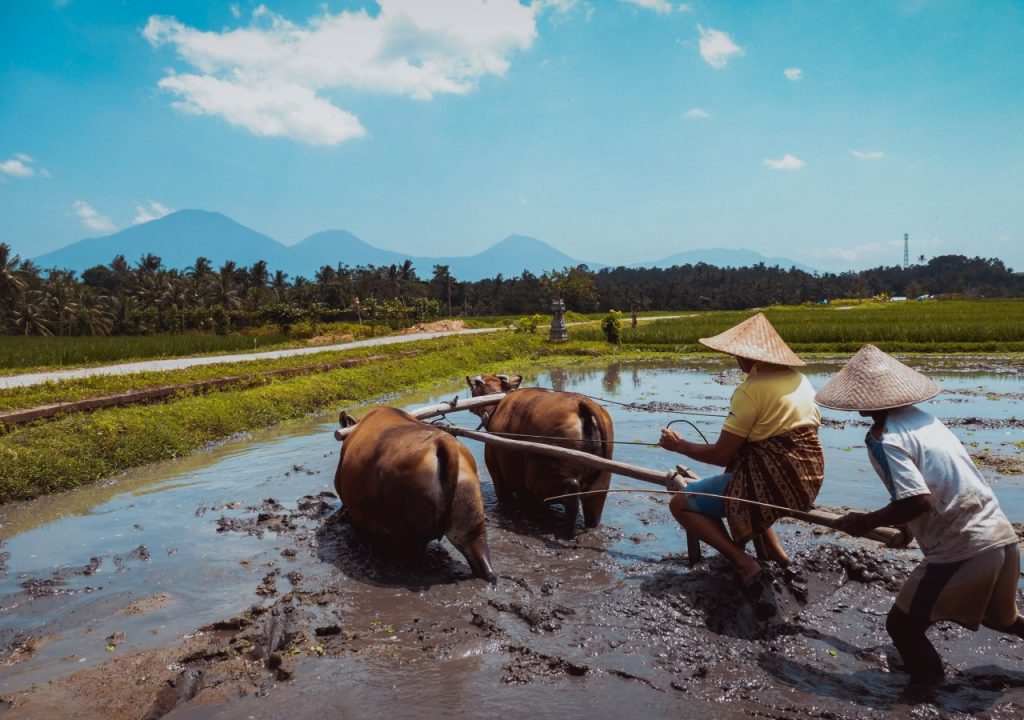
Climate in Indonesia: Dry season and wet season
The climate in Indonesia can be divided into two seasons, the wet season and the dry season, with warm tropical temperatures averaging 28C all year round during the day.
Climate in Indonesia: Dry season ☀️
In most regions, the dry season extends from May to September.
The months of the dry season are the most popular time to visit Indonesia.
Climate in Indonesia: Wet season 🌦️
The wet season is between October and April, with precipitation in the form of short and heavy downpours.
There are some regional exceptions and northern Sulawesi experiences some rain in June and July. Temperatures remain fairly constant throughout the year with averages of 28C throughout the region.
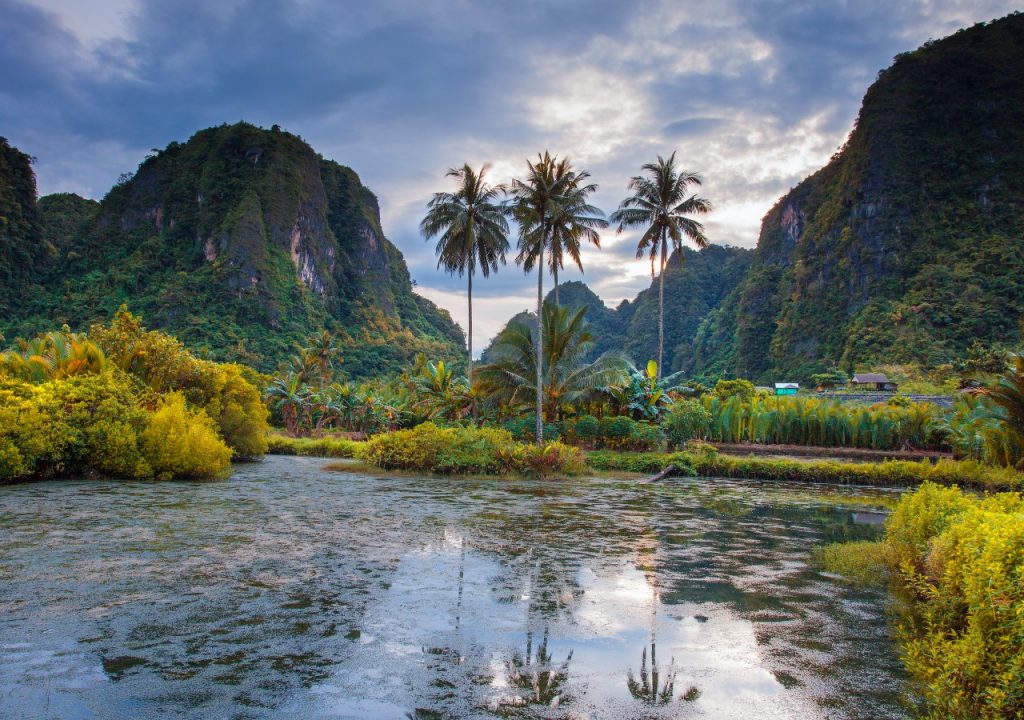
Best time to travel to Indonesia by months 📆
Being at the equator and due to its large size, the climate in Indonesia can never be accurately predicted. During the different months of the year in Indonesia, there will always be somewhere in the country where it is dry season and other places where it can rain more intensely.
On the following Indonesian precipitation maps, you can compare the climate in the different areas of the country during the months of January, April, August and October. In areas where the green color is more intense, it means it’s rainier, and on the contrary, the redder and darker, the drier.
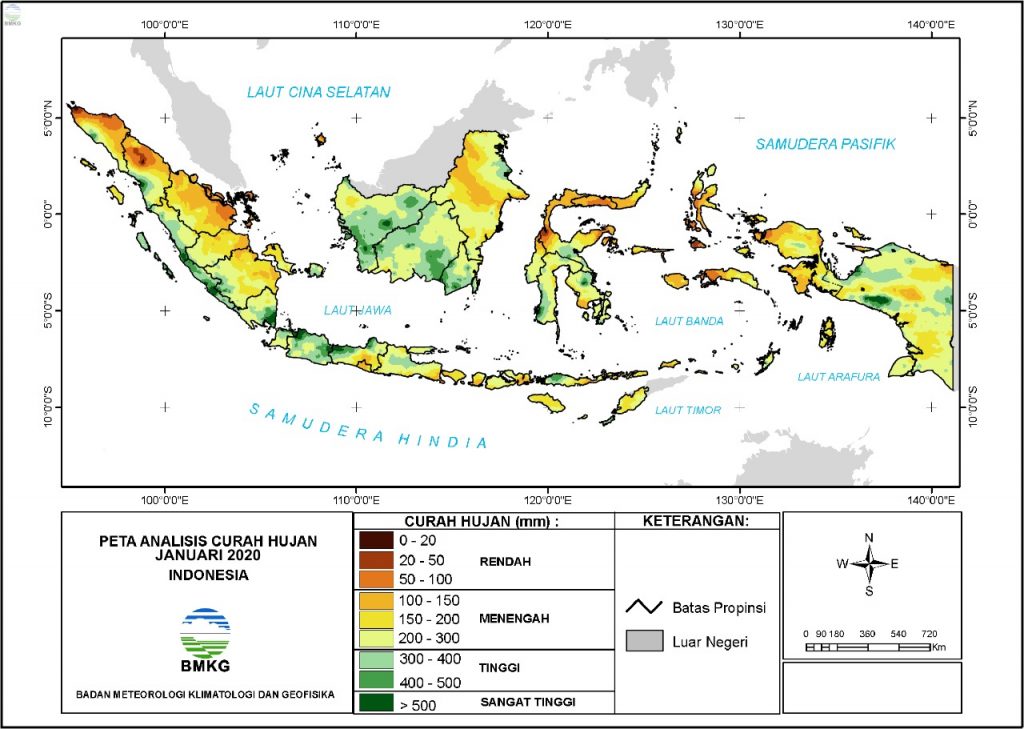
To give you a better idea of the best time to travel to Indonesia, here’s what Indonesia’s average climate is usually depending on the month of the year we’re in.
Travelling to Indonesia in January
During January, rains often spread throughout Indonesia, and while it’s hard to find some sun, you can still get lucky at this time of year. As I mentioned above, the rains are very intermittent, and usually last only several hours a day. To ensure sunlight, it is best to head towards the areas further north of Indonesia .
Travelling to Indonesia in February
The sun rises again in the north of Sumatra, where the rain begins to become less constant. However, the rest of Indonesia remains under rain clouds. Closer to the end of the month, the rains begin to decrease and temperatures hover around 30C.
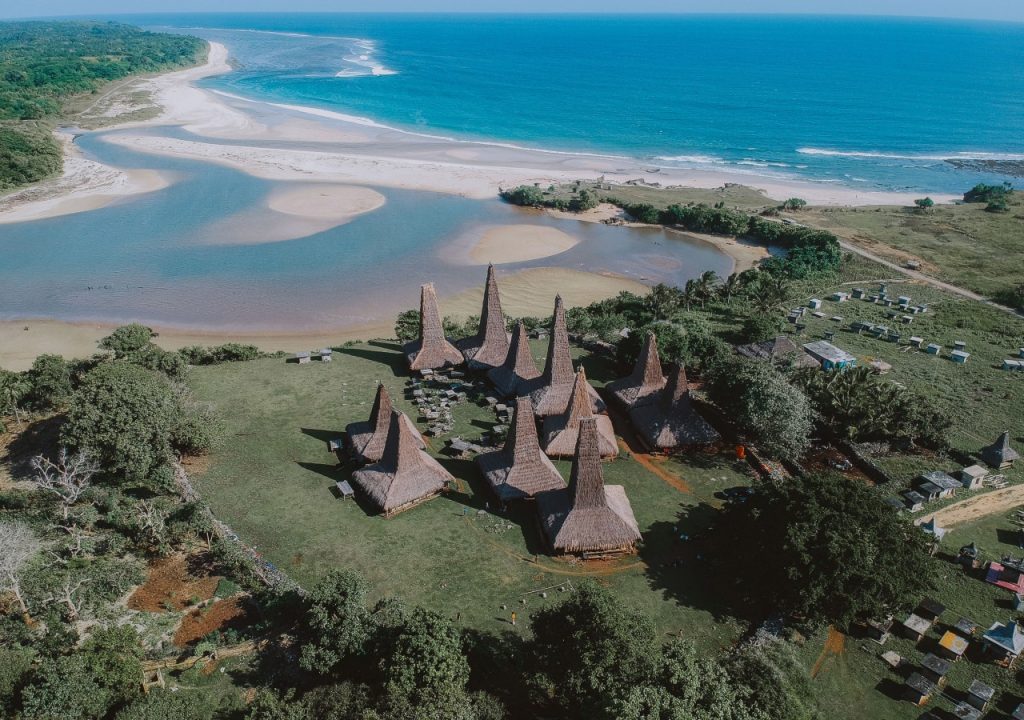
Travelling to Indonesia in March
During the month of March, there is a mixed climate throughout Indonesia, as the sun stops shining at times due to occasional rainfall. That said, you may still be able to get some low-season deals.
Travelling to Indonesia in April
The sun returns to most of Indonesia, and Sumatra still sees it rain a little in the afternoons. Towards the end of the month, the influx of tourists in Indonesia began to increase considerably.

Travelling to Indonesia in May
Bali and Lombok enjoy some of their best days of the year, and beach lovers flock to their shores, making the most of splendid sun and blue skies. The rest of Indonesia continues to see a warm and dry weather at all times, although it is to be expected some storm from time to time in some areas.
This is a good time to see the orangutans when they go out to play in the woods, and you may be able to take advantage of some of the seasonal promotions.
Travelling to Indonesia in June
Possibly, early June is one of the best times of the year to travel to Indonesia. Traveling on these dates, you will avoid matching European school holidays and enjoy good weather most of the time.
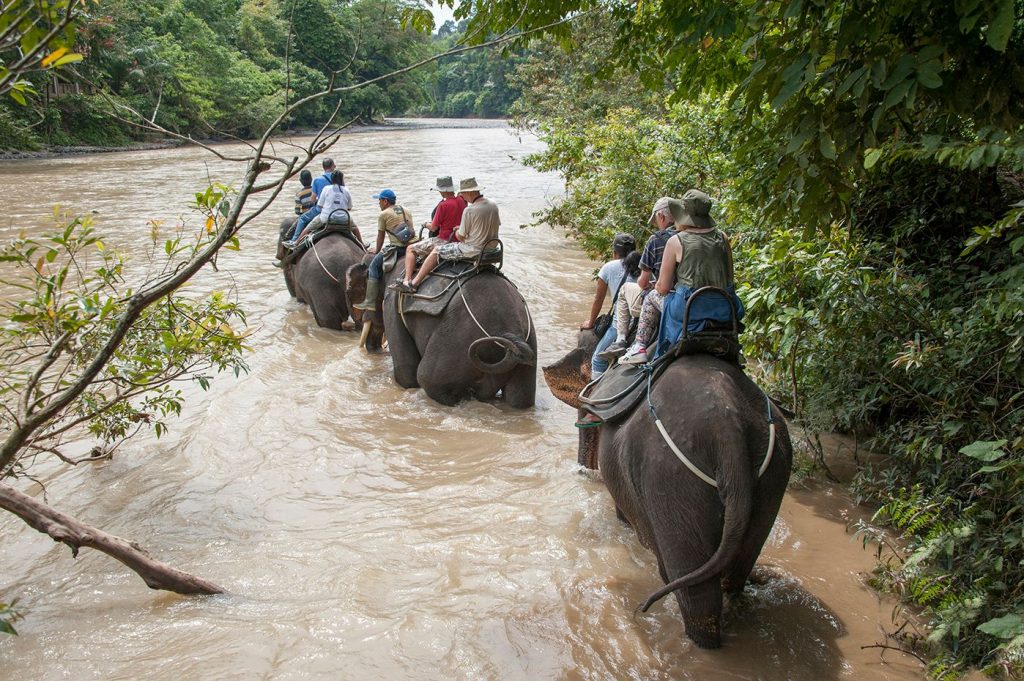
Travelling to Indonesia in July
It is full of high season and all of Indonesia experiences a warm and dry climate.
With school holidays in full swing and the sun shining consistently, accommodation tends to be booked well in advance and the most popular beaches can get a little crowded at peak times. Humidity is usually quite strong in areas like Kalimantan.
Travelling to Indonesia in August
The high season continues in Indonesia and during the month of August there are even more tourists than in July; with good weather, full wildlife and highly demanded national parks and tourist attractions… don’t forget to book ahead to avoid disappointment!

Travelling to Indonesia in September
The month of September has the same favorable weather conditions as August, but with less the crowds and high season prices, so it’s a fantastic time to travel to Indonesia.
Travelling to Indonesia in October
During the month of October you will enjoy the last rays of sunshine before the rainy season begins in Indonesia.
Warm, sunny weather still dominates most of the region, although regular rains can be expected in some areas, worsening in intensity as the month progresses.
North Sumatra, in particular, experiences one of its wettest months, which can affect roads.
This can be a good time to get a seasonal deals.
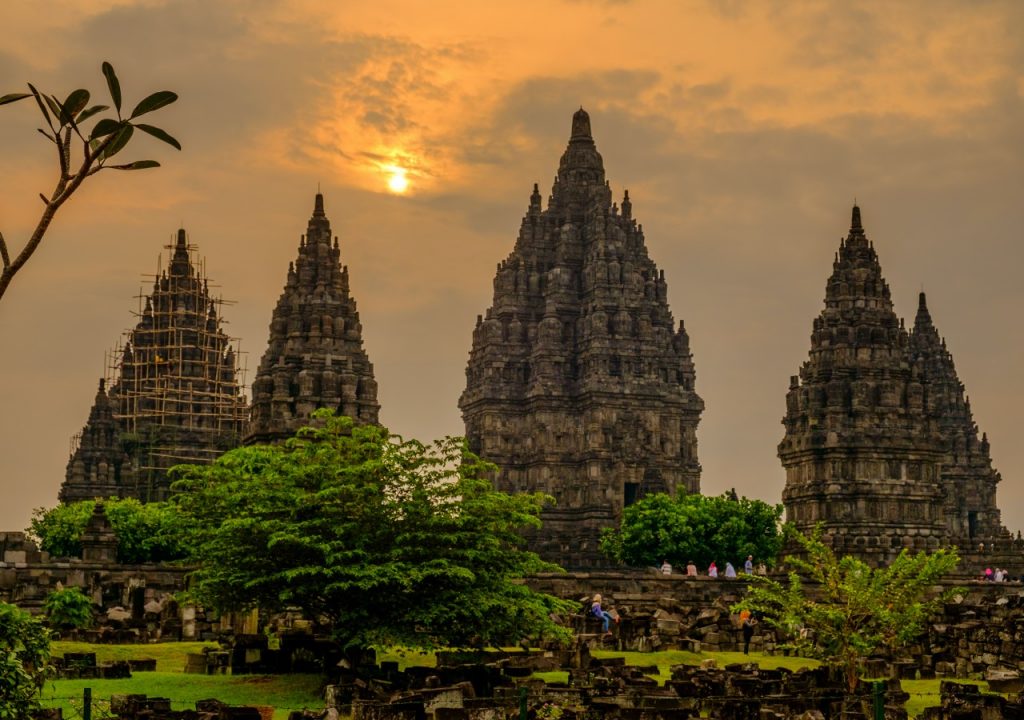
Travelling to Indonesia in November
The rains return constantly to most of Indonesia, but as always, you may enjoy some occasional sun rays; particularly in Bali and northern Sulawesi.
Temperatures still average around 30C in most areas. Rains can cause road conditions to be affected and moisture can become sweltering.
Travelling to Indonesia in December
During the month of December, you are likely to experience rain and high humidity levels throughout Indonesia. With Christmas prices just around the corner, it may be better to visit Indoonesia at the beginning of the month.

When to travel to Indonesia by destinations 📍
With more than 17,000 islands, one unique cultural diversity in the world, thousands of miles of jungles full of wildlife, innumerable paradise beaches and majestic volcanoes; Indonesia is one of the best vacation and adventure travel destinations in the world. So, if you’re planning your trip to Indonesia, it is important to know the best time to visit each of its different islands.
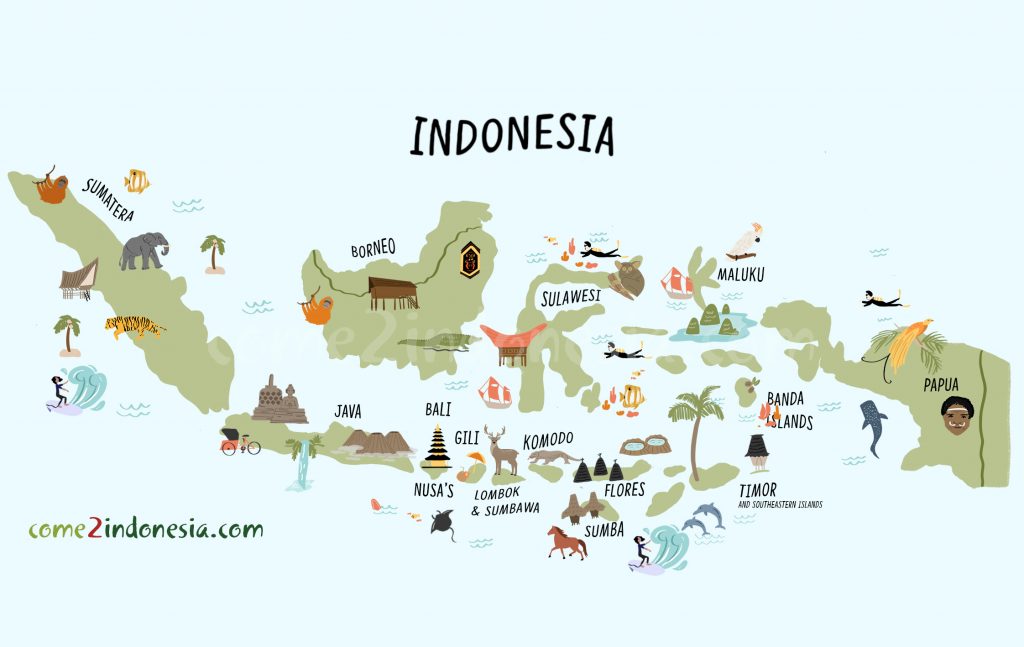
When to travel to Java
The best time of year to visit the island of Java is during the dry season, which extends from May to September, when the days are hot, dry and sunny. These months are also an ideal time to travel if you plan to visit the volcanic mountains of Bromo or Ijen.
The rainy season on the island of Java takes place from November to March, although East Java experiences less rainfall than western regions. During this season, the days are characterized by regular and intense rains that tend to last a couple of hours.
Temperatures are consistently warm throughout the year, with average daily temperatures hovering around 28-30C, although temperatures are cooler in higher mountainous regions such as Mount Bromo, especially at night.

When to travel to Sulawesi
Sulawesi has a somewhat peculiar climate, as it experiences different weather conditions depending on the area of the island you are on.
In Toraja and the southern part of the island, the rainy season takes place between November and April. In contrast, cities such as Manado and the northern regions experience rains all year round, with the driest months between July and October.
As for the temperature, it can become very sweltering on the coast, with maximum temperatures of 34C, going down to 24C in the hills of central Sulawesi.

When to travel to Borneo – Kalimantan
Due to the large size of the island of Borneo (the third largest island in the world), Kalimantan’s climatic conditions vary slightly in different areas of the territory. The southern regions are the driest, and the rainforest-filled inland areas are predictably the wettest.
Kalimantan has a light rainy season from March to May, with stronger rains falling between November and January. However, in general, rainfall in Borneo tends to be milder than on other neighboring Indonesian islands, such as the island of Java.
The dry season extends from June to September, with August and September being the driest months of the year. Orangutans they can be seen in Tanjung Puting National Park all year round, although during the rainy season they tend to be more elated, preferring to take refuge.
The temperature in Borneo ranges from the warm 23C at night to 33C during the day, and the hottest months are usually May and August.

When to travel to Sumatra
Sumatra is the 6th largest island in the world and the largest island in Indonesia. It is divided by the equator, so weather conditions vary slightly throughout the island.
Medan and North Sumatra have a more tropical climate with the possibility of rains throughout the year, especially in jungle-covered areas such as Bukit Lawang. The largest rainfall in the north is usually between the months of October and January.
Palembang and South Sumatra have a much more defined wet and dry season. With a drier climate during the months between April and October and precipitation from November to March.
The average temperatures hover around 27-28C throughout the year, although the maximum temperatures of 33-34C are quite common during the driest summer months.

When to travel to Nusa Tenggara: Lombok, Flores, Komodo National Park and Sumba
The islands of Nusa Tenggara, including Lombok , the Gili Islands , Flores and Sumba, usually have the dry season during the months between April and September, with plenty of sun and blue skies. These months are an ideal time to travel if you plan to climb Mount Rinjani or dive on the Lombok coast, Gili Islands and Komodo National Park.
The wet season is usually between October and March, being November, December and January are the ones that record the most rainfall.
Like the neighboring island of Bali, the average temperature is quite constant throughout the year in the Nusa Tenggara Islands, ranging from 27 to 29C.
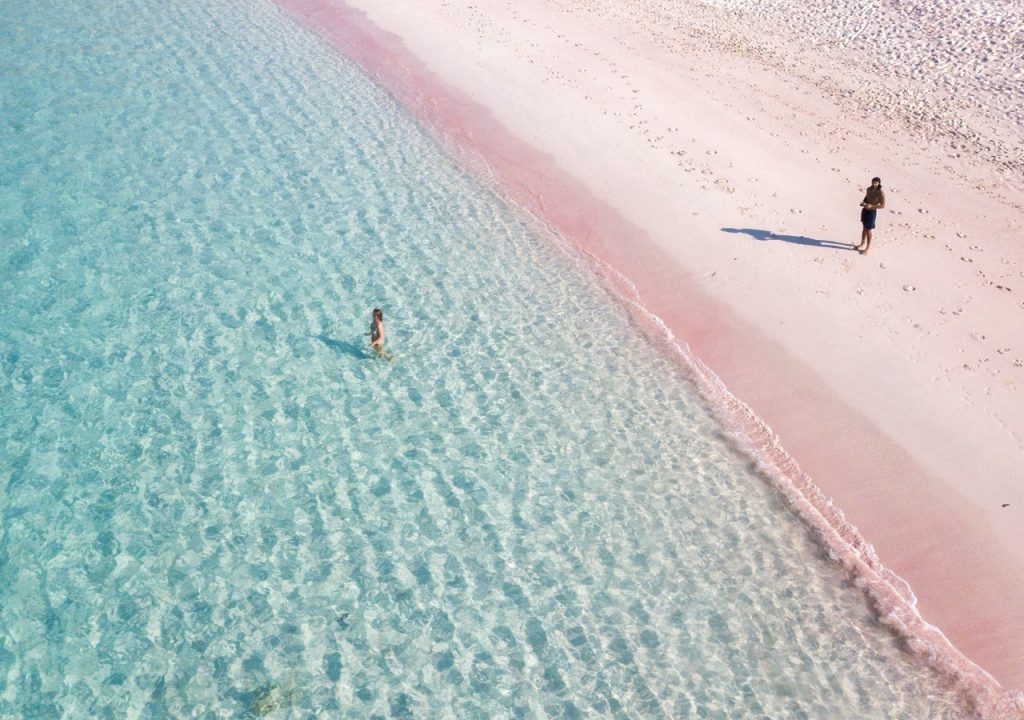
When to travel to West Papua and Raja Ampat
The islands of Raja Ampat and West Papua can be visited all year round, as there is really no low season.
In Raja Ampat, daily temperatures range from 30C to 34C throughout the year and rarely fall below 10C at night. The ocean is also warm all year round.
In the Wamena highlands and the Baliem Valley, at an altitude of 2000m+ above sea level, temperatures are cooler and average between 20C and 25C throughout the year. You can expect a drop below 10C at night in Baliem Valley.
The rainy season on the islands of Raja Ampat differs quite confusingly from the rest of Indonesia. Between the months of June and September there is a higher chance of rain and strong winds can be expected; conditions not ideal for boat trips or diving.
In Baliem Valley, at high altitude, you can expect rains all year round, being the wettest months of the year May and June. However, rain in the region usually occurs in the form of short, strong rainfall rather than showers throughout the day.

When to travel to the Moluccas Islands
The weather conditions on the central islands of Moluccas, Ambon and Seram differ from the rest of Indonesia.
Between the months of June and September, these islands experience rains, so it is better to visit them between October and May. Weather patterns on the southern islands of the Kei, Aru and Tanimbar, and the northern islands of Ternate, Tidore and Halmahera are similar to most of Indonesia. These islands are best visited between the months of May and September.

When to travel to Bal i
Bali’s dry season takes place during the months of April to September. At this time the island enjoys sunny days with blue skies.
The months of May, June and September are arguably the best time to travel to Bali. During these months the weather conditions are ideal, but the number of tourists is not at its highest peak, so the most popular areas of the island are not too crowded.
Bali’s wet season takes place between October and March. Tropical rains result in occasional showers for several hours a day.
The temperatures in Bali are quite constant throughout the year, ranging from 26C to 29C, although the central regions around Ubud and the mountains, such as Mount Batur, experience cooler temperatures and more rain than coastal regions.

Don’t forget to visit our comprehensive Indonesia Travel Guide , where you will find all the information you need to travel to Indonesia!
Remember that you can also write to [email protected] if you need help planning your trip to Indonesia.
RECENT ARTICLES
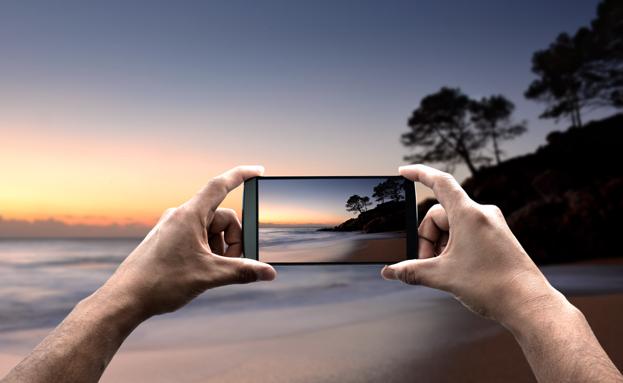
How to Register Your Mobile Phone IMEI Number in Indonesia (Update 2024)

All About Bornean Orangutans and Jungle Boat Trips
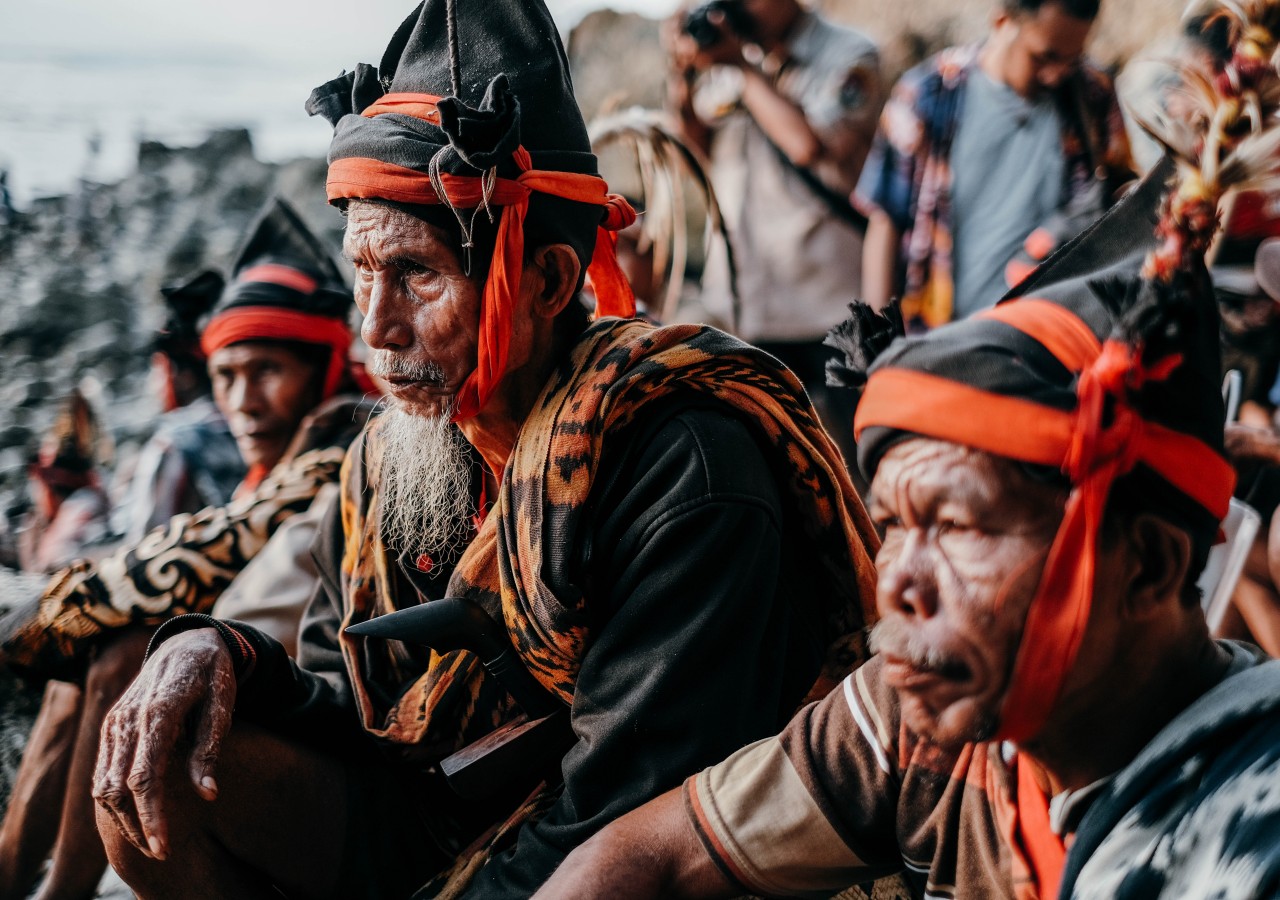
Discover SUMBA ISLAND & its incredible PASOLA FESTIVAL

Learn Bahasa Indonesia: LESSON 1 – INTRODUCTION
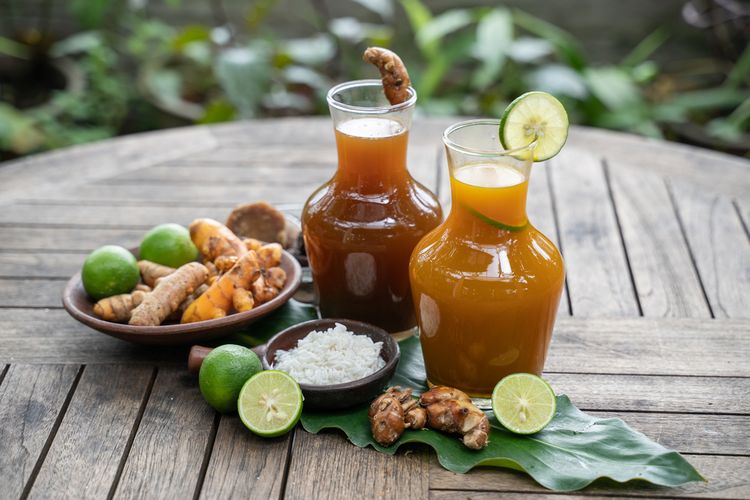
Traditional Indonesian drink: JAMU
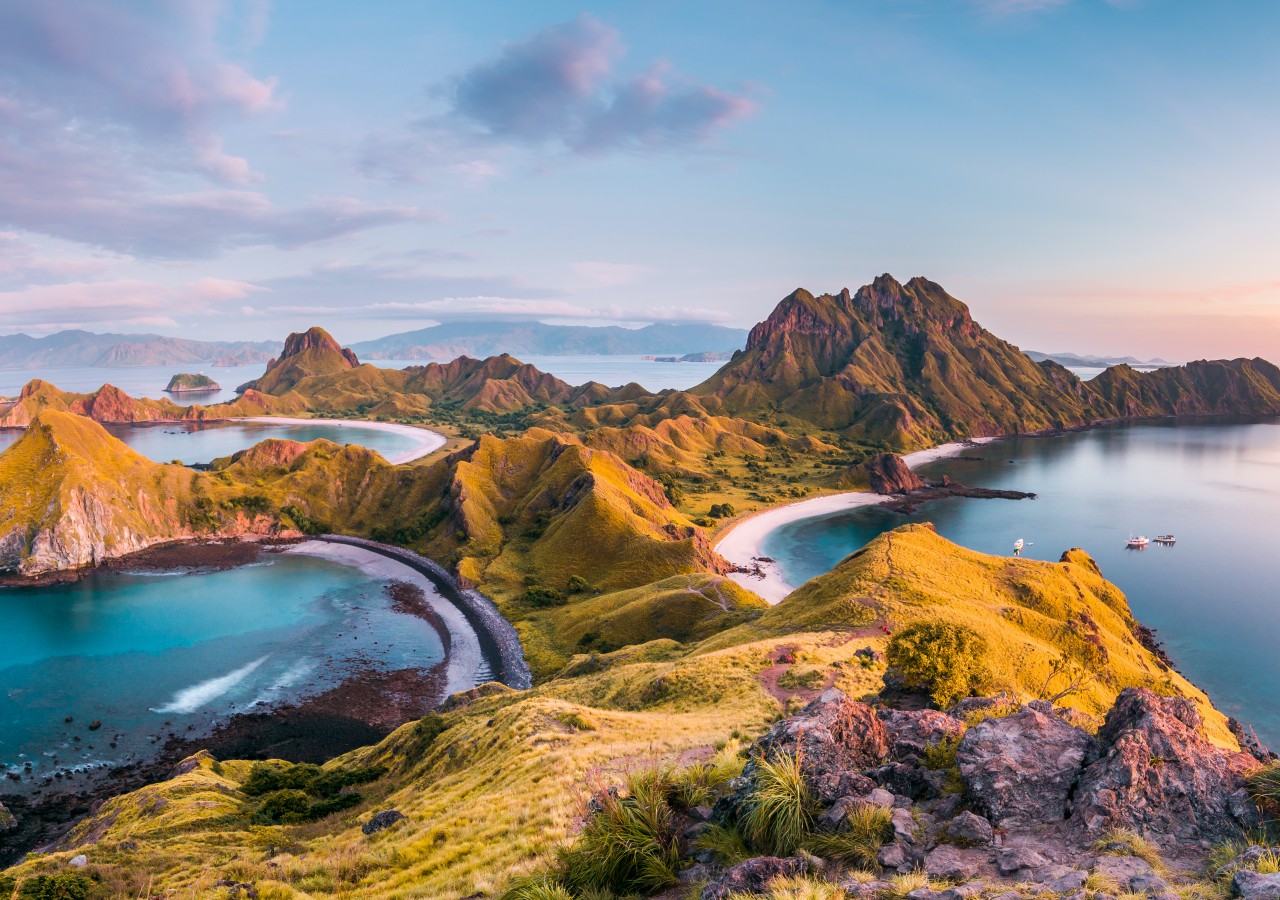
Indonesia Travel Guide: All the information you would like to know before travel to Indonesia
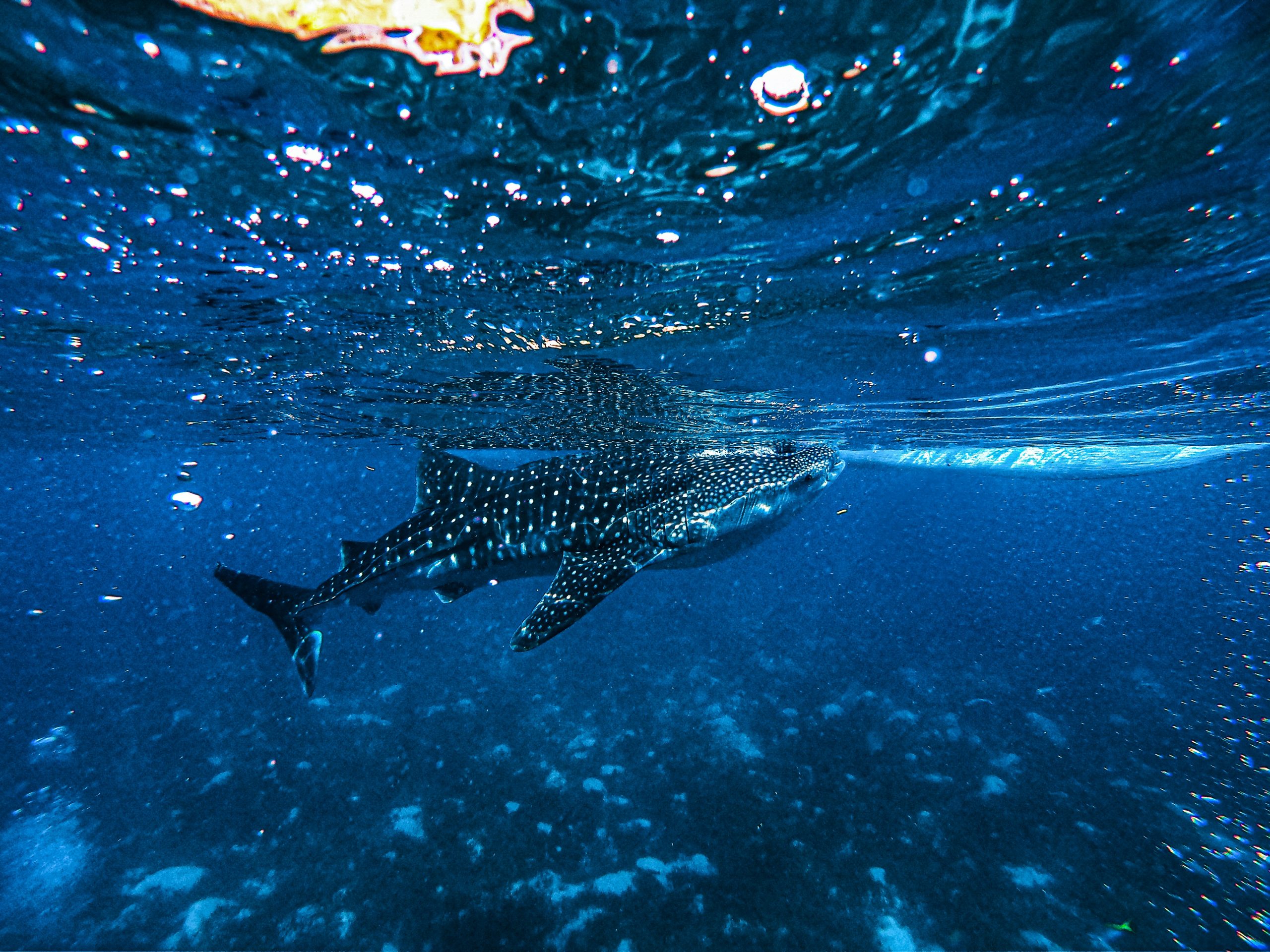
Swimming with Whale Sharks: Where to find these Giants in Indonesia

A Guide to the Best Restaurants, Bars, and Beach Clubs in Bali
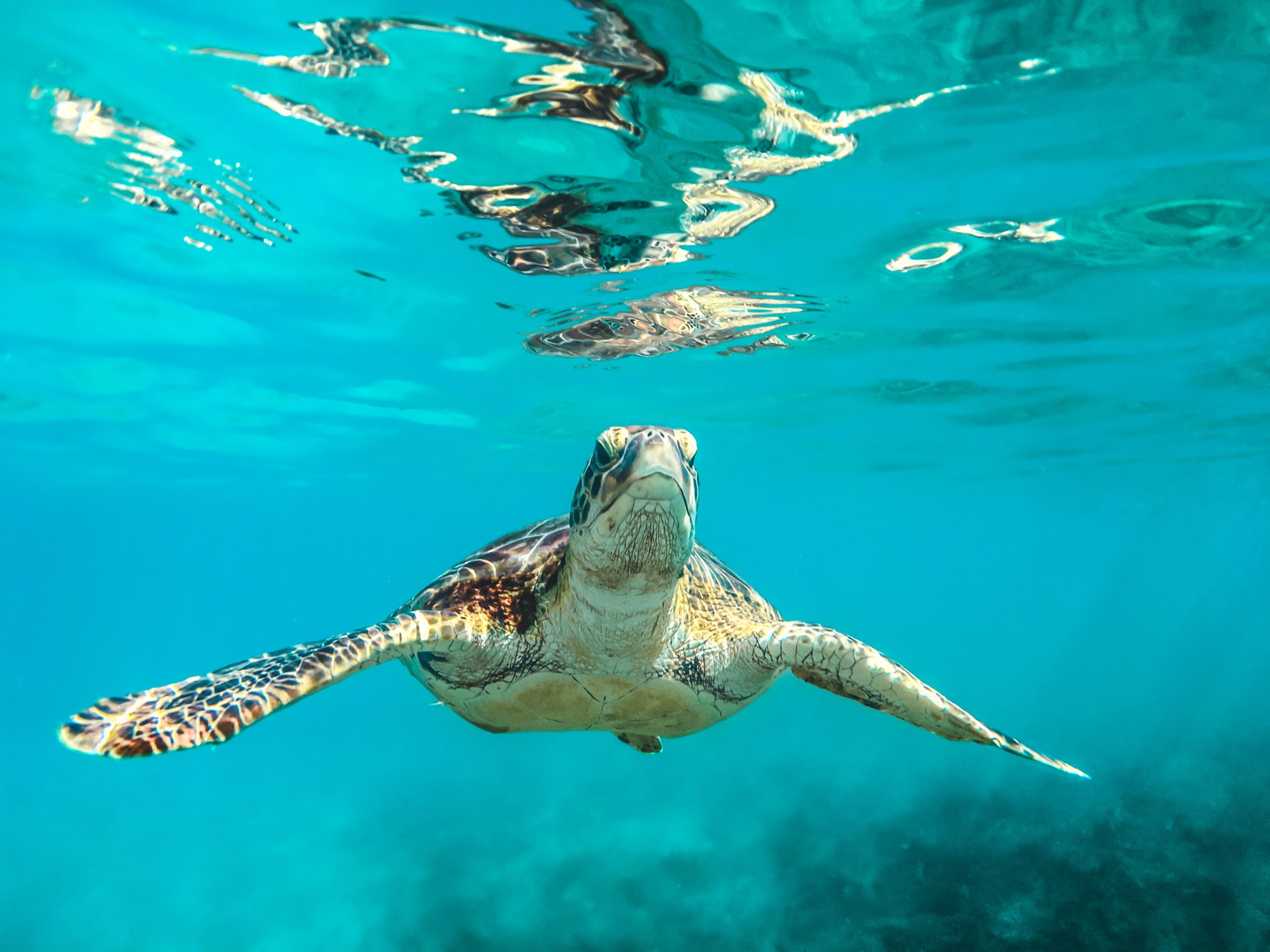
Gili Islands Travel Guide: Discover the charms of Gili Trawangan, Gili Air, and Gili Meno
Recommended trips.

Bali Fantastic Route – Tanah Lot Temple
Taman Ayun Temple Jatiluwih Rice Fields Ulun Danu Temple Tanah Lot Temple West Bali
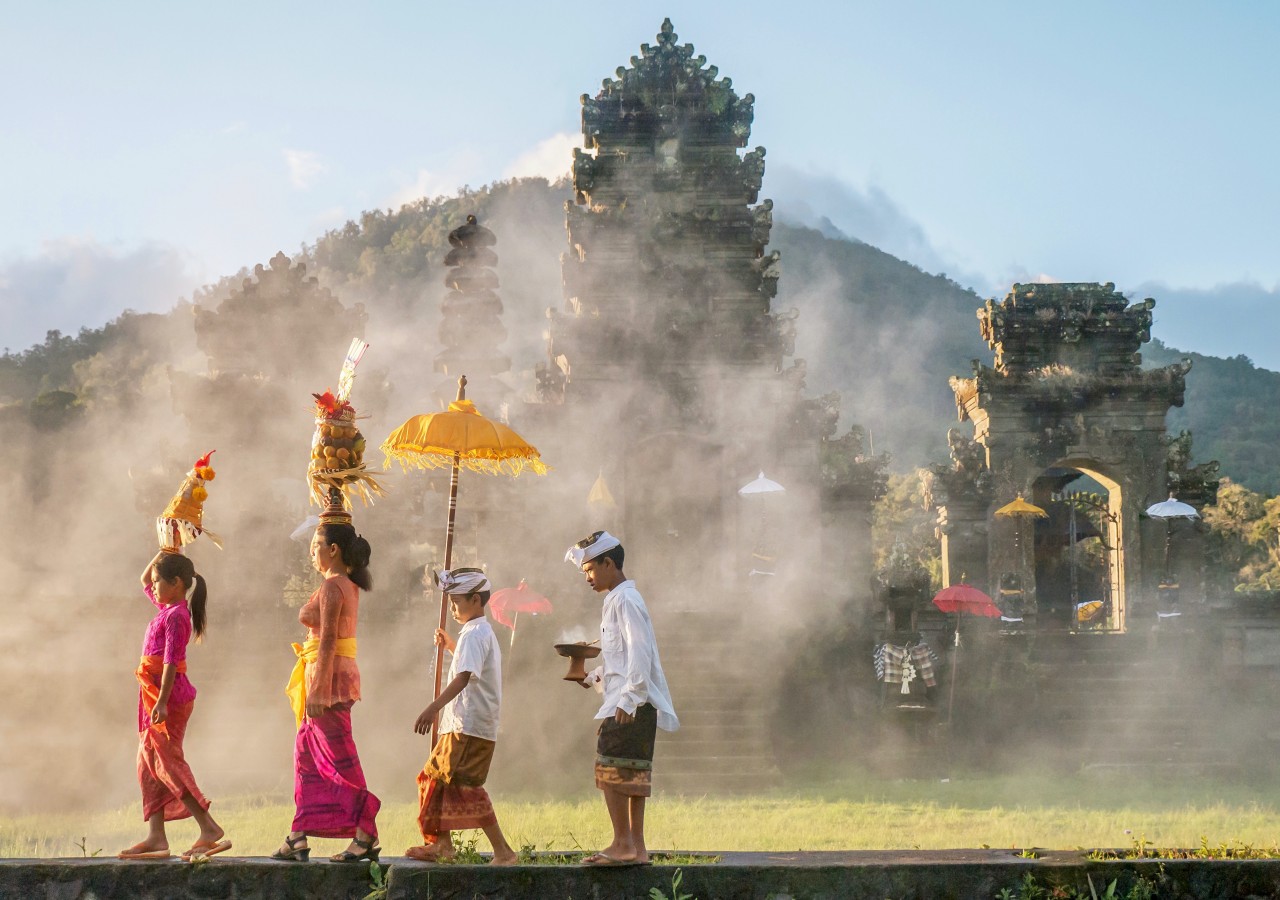
The Mother Temple Besakih & Surrounding
Kusamba Beach Temple Goa Lawah Kertagosa Palace Balinese Hinduism Bali, Island of Gods

Borneo Orangutan Deluxe Houseboating Tour (3D/2N)
Sustainable tour Deluxe Boat Tanjung Puting National Park Local specialized crew Night treking included
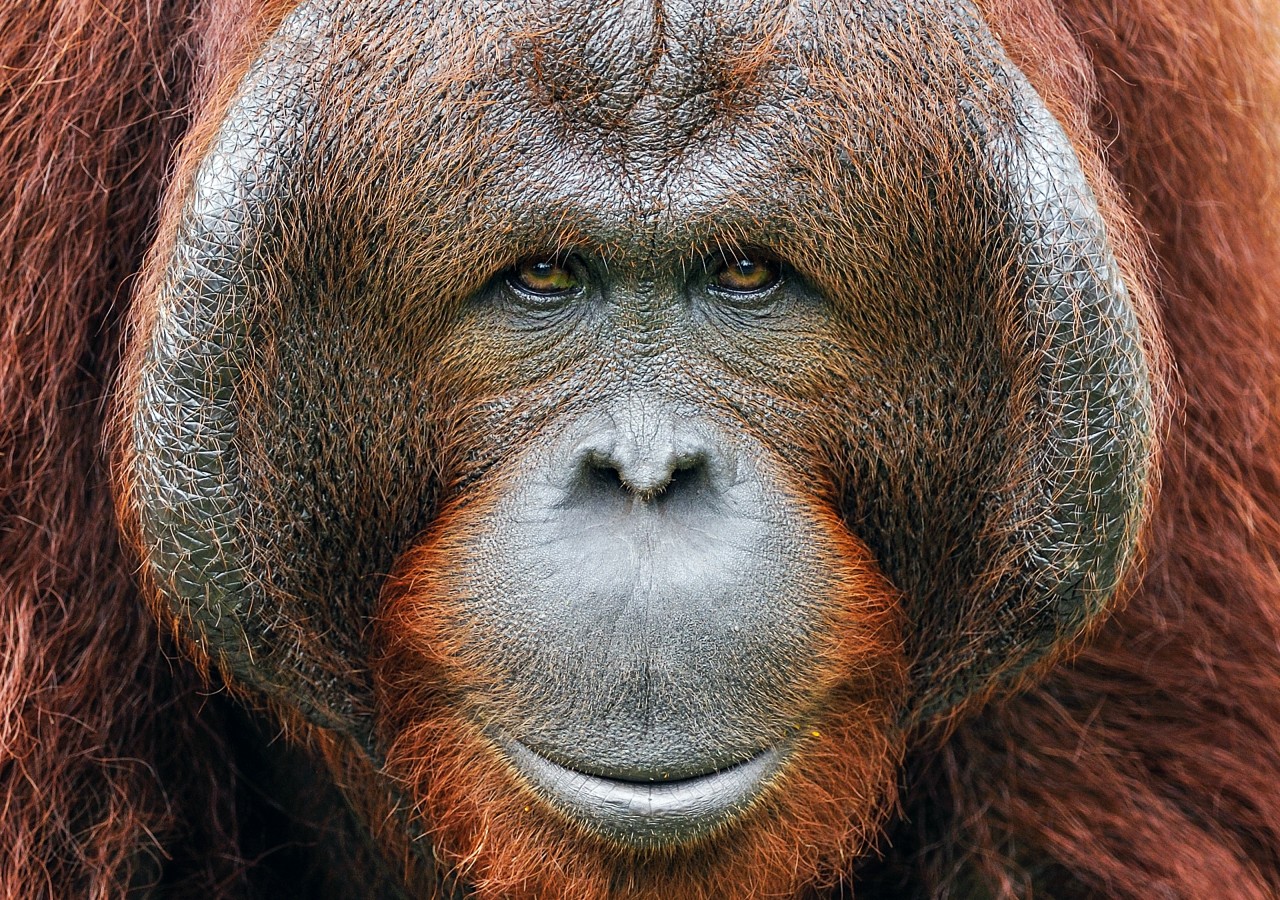
Best Borneo Orangutan Tour (3D/2N)
Sustainable tour Our own boats Tanjung Puting National Park Local specialized crew Night treking included
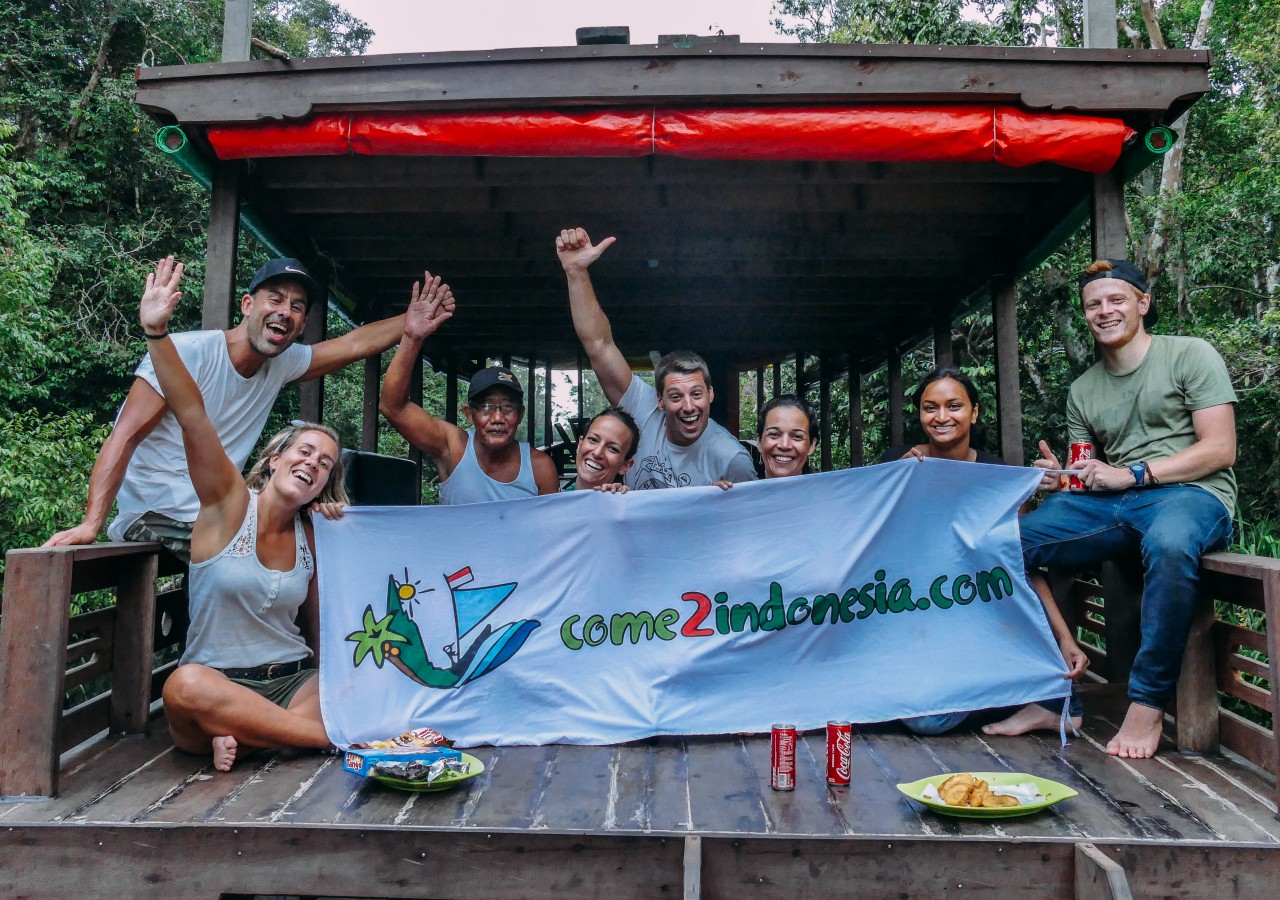
Shared Borneo Orangutan Tour (3D/2N)
Sostenible Tour Our own boats Tanjung Puting National Parl Local specialized crew Nice atmosphere
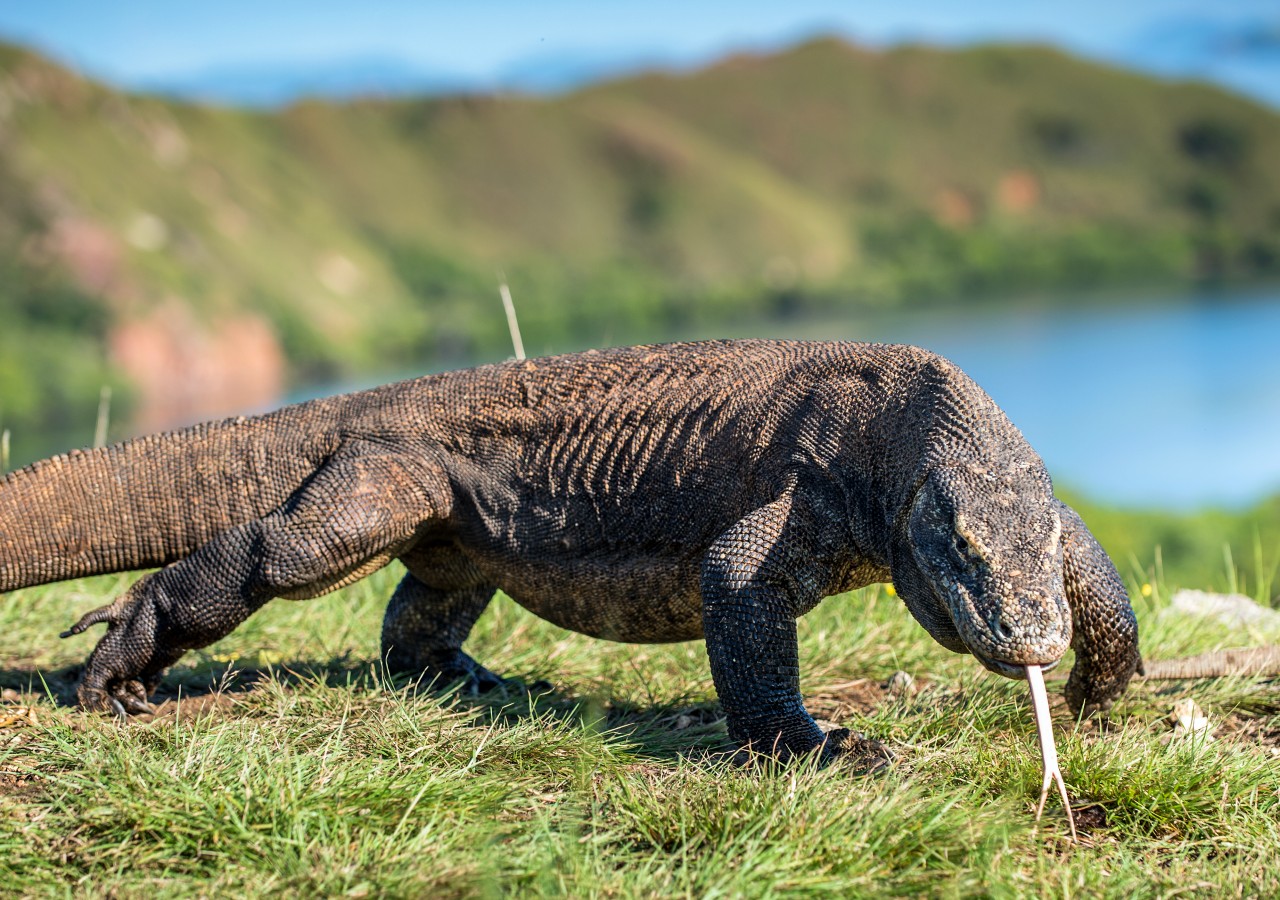
Rinca & Komodo Jurassic Adventure (3D/2N)
Komodo dragons Short and easy trekking Snorkeling trip One-night hotel stay Full-board accommodation on boat
Destinations
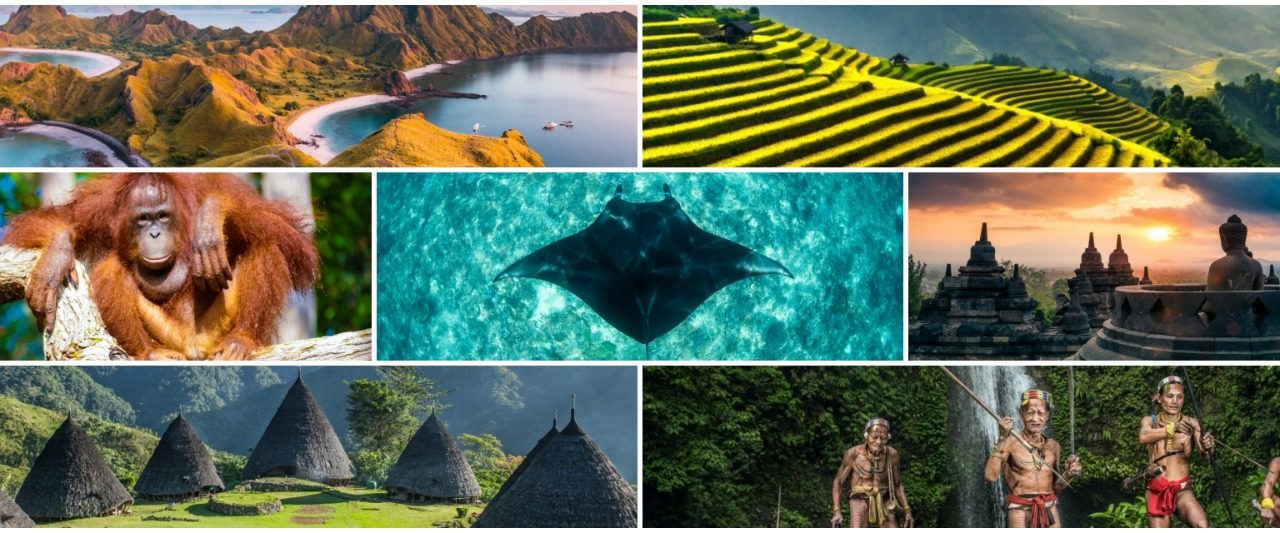
Email address:
Article author
Born in Valencia (Spain), his professional career has always revolved around the tourism sector. He studied tourism degree and later specialized in digital tourism marketing.
After working in various travel agencies. In 2018, he was a beneficiary of an Indonesian government scholarship to study at one of the most prestigious universities in the country. After specializing in the destination and having traveled and lived in various areas of Indonesia, he joined our team in early 2020.
Fernando is passionate about surfing and extreme sports. He’s the first to sign up for a trip, always looking for new adventures!

SHARE THE POST WITH FRIENDS

Leave a Reply Cancel Reply
Save my name, email, and website in this browser for the next time I comment.
¡Darme de alta en la newsletter!
- Search Please fill out this field.
- Manage Your Subscription
- Give a Gift Subscription
- Newsletters
- Sweepstakes
- Island Vacations
The Best Time to Visit Bali for Every Activity
Bali seasons, explained — these are the best times to visit the island, whether you're coming for the beaches, hiking, or festivals.
:max_bytes(150000):strip_icc():format(webp)/maya-kachroo-levine-author-pic-1-2000-1209fcfd315444719a7906644a920183.jpg)
Bali is a magical destination with so much to offer, from the jungle surrounding Ubud (largely considered Bali's cultural center) to the beaches lining its southern shore.
You can make your Bali vacation whatever you want it to be — a tour of the island's many temples, a spiritual journey to learn more about Hinduism, a yoga retreat, a luxury hotel immersion, a hiking adventure, or a stop on a longer trip around Indonesia. You might even want to visit Bali specifically for one of the many festivals or spiritual celebrations hosted each year.
Bali has a tropical climate with average temperatures hovering between around 75 and 80 degrees Fahrenheit year-round. Its two seasons are defined as dry (April to October) and wet (November to March). Here's a general breakdown of Bali's tourist seasons:
- High Seasons: June to August and November to December
- Shoulder Seasons: April to May and September to October
- Low Season: January to March
Below, we've mapped out the best times to go to Bali, depending on how you want to spend your vacation.
Michela Buttignol/Travel+Leisure
Best Times to Visit Bali for Smaller Crowds
January to March is Bali's true off-season. These months can be humid and rainy, which means you won't find crowds in search of perfect beach weather and diving conditions. And because you'll also be avoiding the biggest holiday months (November and December), you'll find the island to be calm and populated by locals and expats.
While the rain brings mosquitos and may take activities like diving and surfing off the table, it's not a deal-breaker if you're in Bali to tour temples, practice yoga, and find pure relaxation. In fact, you might find that the peaceful rain in the Ubud forest adds to the overall serenity of your experience. The jungle and rice paddies thrive in this season — and the magnificent green color and sprouting vegetation are worth seeing.
Best Times to Visit Bali for Good Weather
Sunseekers should time their trip with Bali's dry season, which runs from April to October. During this period, humidity and rain decrease, creating ideal conditions for visiting beaches, surfing, scuba diving, and snorkeling. It still rains during these months, especially in April, May, and October, but showers are usually short and followed by clear skies. May is one of the hottest months, with an average high of 82 degrees Fahrenheit.
For the best weather, visit during July and August, the peak of the dry season. With less humidity, these months feel cooler, with an average temperature of 80 degrees Fahrenheit, so they're perfect for enjoying a mix of active adventures and beach time. Those coming to Bali to catch some legendary waves should also aim to visit during the dry season, with June to August bringing larger swells to the main surf spots along the southwest coast.
Daniel Gorostieta/Travel + Leisure
Best Times to Visit Bali for Lower Prices
The busiest and most expensive time in Bali is during the dry season, with hotel prices peaking between June and September. Tourism also sees a boost during the holidays, so you can expect higher hotel prices in November and December.
The most affordable time to visit Bali is from January through March, the rainy-season months that fall outside of the festive season. Hotel prices during this time tend to be lower due to the lack of demand, making it possible to score ocean-view rooms or multi-bedroom villas for a fraction of the price you would pay during the dry season. You may also find deals during the quiet shoulder season months, April and October.
Best Months for Hiking in Bali
If you're traveling to Bali specifically to hike, visiting between April and October is ideal, as the rainy season can cause trails to be muddy and slippery. For those planning to do some waterfall hikes, the best time to visit Bali is in April, May, and June, when the cascades are strong following the wet season, and the days are more likely to be sunny. Hikers who rent motorbikes will also have an easier time zipping around the island during the dry season since the roads can become treacherous in the rain.
Best Time to Hike Mount Batur
Mount Batur is perhaps the most iconic Bali hike. Typically, you'll book through a tour company that will pick you up from your hotel at about 2 a.m. for the 1,717-meter (5,633-foot) trek. You'll summit the active volcano as the sun rises, and depending on your guide, you may even be treated to eggs boiled in the volcanic steam at the top of Mount Batur. The two-hour hike to the summit is best done between May and September to ensure dry weather and clear views.
Best Times to Visit Bali for Festivals
One of the most iconic annual events in Bali is the Bali Arts Festival, which occurs in June and July. Indonesian Independence Day (or Hari Merdeka) falls on August 17 and is commemorated with parades and outdoor celebrations. Keep in mind that if you're traveling for a Hindu celebration, Balinese Hindus often celebrate different holidays than Hindus in India. Galungan, for example, is an important 10-day celebration of the triumph of good over evil (dharma over adharma) that occurs every 210 days according to the Balinese Pawukon calendar. Nyepi, a day of silence, fasting, and meditation before the New Year, typically takes place in March.
Best Months to Visit the Beach in Bali
May to September is the best time to visit Bali for a classic beach vacation. Days tend to be hot, sunny, and dry, creating ideal conditions for snorkeling, diving, and other water sports. However, the drawback of visiting Bali during this period is that most of these months fall within the peak season. The temples, beaches, hotels, and yoga classes will be crowded, so it's likely you won't have as many opportunities to soak up that sweet Balinese serenity you're treated to in the low season.
Worst Times to Visit Bali
Of course, those looking for a quintessential Bali vacation with plenty of sunshine and outdoor activities will want to avoid the rainy season (especially during the wettest months, December and January). At this time of year, it's common to experience choppy seas, muddy trails, and afternoon storms, which can quite literally put a damper on your plans. However, travelers looking to spend their days practicing yoga, visiting temples, or enjoying cultural experiences indoors may prefer the quieter atmosphere.
Due to higher levels of precipitation, mosquitos can be particularly prolific in the rainy season and the risk of mosquito-borne illnesses (like dengue fever) increases accordingly. If you do plan to visit during the wet season, bug repellant is a must-have on your pack list — especially when hiking in the jungle. Some locals also drink lemongrass tea, which is believed to be a natural insect repellent.
Related Articles
- € EUR
When is the Best Time to Visit Indonesia?

Published on: August 15th, 2017
Last modified: July 27th, 2023
Indonesia is a country where beach-meets-jungle. This chain of more than 17,000 islands in Southeast Asia serves unspoiled beaches and crystal-clear waters that are best explored on luxury yacht expeditions , particularly across the idyllic archipelago of Raja Ampat. Add in a collection of UNESCO Heritage Sites in Java and legendary dragons in Komodo National Park and there are more than enough reasons to visit.
The best time to visit Indonesia is between May and September. Little rainfall, clear skies and average temperatures of 30°C (86°F) are perfect conditions for exploring the islands. Indonesia’s tropical rainy season falls between November and February. Showers typically pass quickly and with less crowds, travel at this time has its benefits.
If you’re thinking of visiting Bali in particular, the best time to go is the shoulder season; April, May and September. There’s glorious sunshine, little rain and temperatures of 31°C (87.8°F). You can enjoy the great weather, without the crowds of the high season; July, August and December.
Best Time to Visit Indonesia by Season

May to October is Indonesia’s dry season. Temperatures average 30°C (86°F) with almost no rain - a great time for island hopping. Opt for April, May and September (shoulder season) when visiting Bali and Lombok which get crowded during the peak months of July and August.
The dry season is a good time to visit Java for epic volcano hikes as the pathways are dry and easier to traverse, although it’s best to avoid the hot midday sun. Those looking for a challenge can try sunrise hikes of Mount Ijen and Merapi.
May to October is also a great time to take exclusive yacht charters around the Komodo National Park for some of the best snorkelling and diving in the world, in calm and clear waters. You also have the chance of meeting a Komodo dragon, in their UNESCO protected habitat, during your excursions on land.

Indonesia’s rainy season lasts from November to February. Temperatures are warm with some high humidity, averaging 31°C (87.8°F). The wet season can still be a good time to travel to Indonesia. Heavy showers tend to fall in the afternoon and evening, breaking the humidity and leaving mornings clear.
Exploring Indonesia during the tropical rainy season has its advantages, it’s much quieter on popular Bali and Lombok. It's still possible to visit remote and rugged Sumba. A stunning island rich in cultural heritage where you can watch displays from the skilled Pasola horsemen or learn to weave traditional Sumbanese ikats.
The best time to visit Raja Ampat, which follows a different seasonality, for spectacular diving and luxurious yacht cruises is between October to April. This stunning archipelago, just off the coast of West Papua experiences calm seas at this time, the perfect conditions for exploring the magical underwater world.
What is the hottest month in Indonesia?
The hottest months in Indonesia are May, October and November where temperatures regularly reach 32°C (90°F). From October onwards, expect high humidity too. Bali is hottest in May, but the humidity should be starting to subside. In Jakarta, be prepared for typical daily temperatures of 33°C (93.5°F) from May to November.
The Best Months to Visit Indonesia
Indonesia in january - march.
January is one of the best months to visit Raja Ampat for an exclusive yacht exploration, with little rain and balmy average temperatures of 31°C (87.8°F). Calm conditions and low winds are perfect for water activities, both below and above the surface.
On the lunar new year (between January and February) the festival of Imlek is celebrated throughout the country. There’s a national holiday and a series of exciting street parades and firework displays.
Visit Bali in March to see the island glistening green after the rainy season, temperatures average 31°C (88°F) and the rain is starting to dry up. It’s an important month for Balinese Hindus as Nyepi, the Day of Silence and Bali’s new years day is celebrated. The entire island comes to a standstill with airports, shops and businesses closing to allow complete peace for a day of self-introspection. Hotels and resorts do typically operate as usual and while this is an important day, it’s mainly observed by Balinese residents.
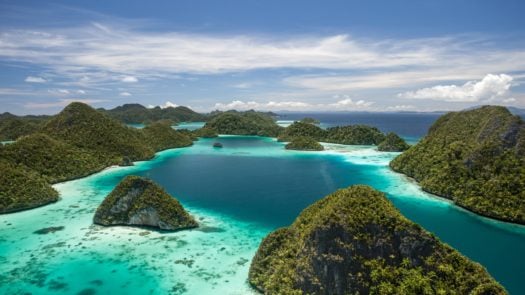
Indonesia in May - June
May and June are wonderful months to visit Java , Bali and Lombok . A perfect combination of good weather and fewer crowds means the islands’ beauty, culture and activities can be fully appreciated. The temperatures at this time stay warm at around 31°C (87.8°F) and there’s very little rainfall. Conditions are now great for hiking in Java as the pathways have recovered from the earlier rains.
Depending on the ancient lunar cycle (but always in May or June), Buddhists celebrate the Wesak Day Festival, the day of Buddha’s birth, death and enlightenment. A spiritual and significant day, with some of the most elaborate festivities, including the lighting of thousands of lanterns, taking place at the enormous, ornate Borobudur temple in central Java .
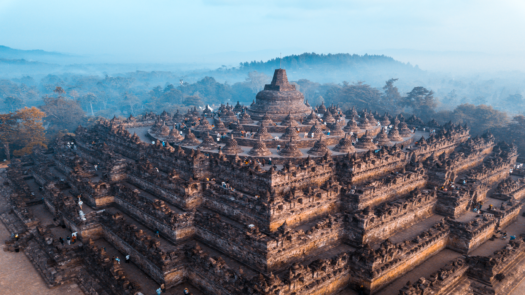
Indonesia in July - August
July and August see gorgeous weather; very little rain at all and uninterrupted sunshine. There’s not as much humidity at this time and temperatures are pleasant at 30°C (86°F). Although these are great months to experience the beaches, waters and interiors of the islands, it can get very busy. In Bali and Lombok, in August there can be lots of crowds and we recommend booking well in advance if you plan to travel at this time.
For a slice of Indonesian history, it’s worth braving the crowds and visiting during August, to witness Indonesia Independence Day celebrations. Previously a Dutch colony, independence was declared in 1945. Across the country there’s parades, games and festivals to mark the day.
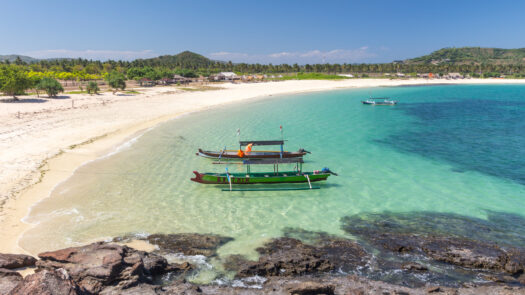
Indonesia in September - December
September and October are Indonesia’s shoulder seasons. September, much like May, has the glorious weather of the high season, temperatures of 31°C (87.8°F), without the crowds – making September one of the best times to visit Indonesia for a laidback, sunny atmosphere.
The humidity and rain starts to creep in and by October and November temperatures will increase to 32°C (89.6°F). In Bali, the rain showers tend to be short lived and there’s still spells of sunshine to be enjoyed.
Despite December being the start of the more persistent rainy season, the crowds still flock to the islands to celebrate the holidays and the New Year in places like Uluwatu – unsurprisingly, it’s necessary to book well in advance if you want to travel at this time of year.
In Java in November the islamic festival of Sekaten celebrates Maulid (the birthday of the Islamic prophet Muhammad). It’s an intricate and religious event which includes a royal procession through the streets, parties and the creation of an enormous model mountain made from sticky rice, sweets, fruits and vegetables.
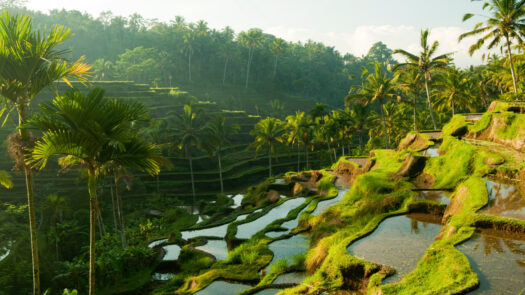
Our Top Example Trips
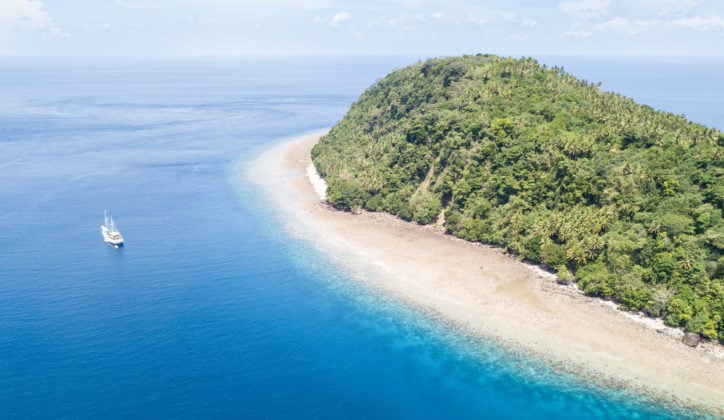
Whatever you want from your trip to Indonesia, our team of expert travel designers are ready to help.
- Deutschland
Best Time To Visit Indonesia
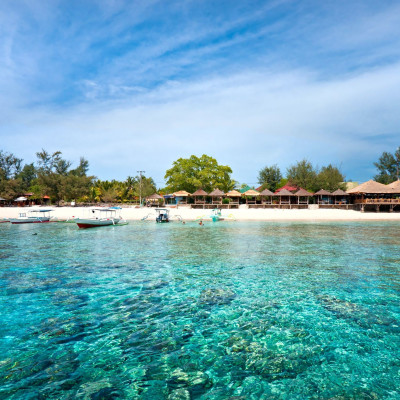
It’s always a good time to travel to Indonesia
The climate of Indonesia is unlike other Asian countries. Most of the islands have an equatorial climate. Indonesia is characterized by two seasons, the dry season and the rainy season, however, this varies on each of the 17,000 islands, which means you can travel to Indonesia almost all the year-round! Indonesia has a consistently warm, tropical climate with an average temperature of 86°F.
Throughout the year, you can expect some showers, however, these are often followed with bright sunshine during the dry season. In the months after the monsoon (April to June), the humidity is particularly low, and both temperatures and humidity rise from July onward. If you do not mind high humidity, then it is fine to travel during the rainy season in Indonesia. Usually, it does not rain all day – you can generally expect around five hours of sunshine each day, although this may be less within the highlands and volcano ascents.
Best Time To Visit
We recommend.
- If you plan to be in Bali around this time, take a cooking class in Ubud. Learn how to make the famous peanut sauce for satay, which has put Indonesian cuisine on the global map!
- If you want to learn about the island culture of Java, visit the The Sultan’s Palace of Yogyakarta, the residence of the Sultan and a museum
- Take in a jungle safari on wooden riverboats and try and spot wild orangutans in the Tanjung-Puting National Park in Borneo, one of Asia’s last remaining tropical rainforests
- Experience a sunrise at Borobodur Temple, the largest Buddhist temple in the world
- Visit the relaxed coastal town of Candidasa, an ideal starting point for hiking in the surrounding mountains
- Explore Samosir, the world’s largest island within an island, created by an ancient volcanic eruption in the midst of Lake Toba, linked to the Sumatran mainland by a narrow isthmus
- Opt for a trekking tour in the picturesque mountain village of Munduk, with its lush green landscape, coffee, cocoa and spice plantations and many waterfalls
- Immerse yourself in the colorful underwater world of the island paradise of Gili Meno island, with its corals, squid and turtles
- Explore the magical landscape of Igen in Java, Indonesia’s largest volcanic crater, which just so happens to have a magical blue fire!
- Take a long hike through the tobacco and rice fields and cocoa plantations of Lombok
- The beautiful island of Bunaken awaits with its unusually rich marine life, expansive beaches and fabulous diving spots
- Seminyak is the hedonist hotspot of Bali – don’t miss its stunning sunsets, fabulous surf and a feast of restaurants, nightclubs and hotels
- Explore the largely untouched city of Banyuwangi with its nature reserves, a protected jungle, volcanic landscapes, beautiful beaches and bountiful marine life
- Escape the hustle and bustle with a trip to Pemuteran in Bali, a hidden jewel with its dark lava sand and stylish beachfront hotels and restaurants
- Plan a trip to Bira, a lovely beach town with miles of virgin white sand beaches, hiking trails, spectacular caves with freshwater pools and great diving opportunities
- Explore the wild tropical forests fringing the charming tropical village of Bukit Lawang, home to the Sumatran orangutan
- Relax in Jimbaran, a seaside resort town on the southwestern coast of Bali, with its crescent-shaped white sandy beach, tropical palms and luxury hotels and villas
- Spend time in the former royal town of Solo – considered to be one of the most important cultural centers of Java with its many music and dance academies
- Marvel at Berastagi’s two active volcanoes Mount Sinabung and Mount Sibayak and its hot springs. You could also use the town as a base for exploring the Karo Highlands before the rains arrive
- Visit Canggu, a picturesque resort town on Bali’s southwestern coast with its terraced paddies, volcanic black sand shores and dramatic rocky outcrops
- Soak in history, walk into swanky shopping malls, experience the vibrant nightlife and sample delicious cuisine in the vibrant heart of Indonesia – Jakarta!
- Despite the rains, Bali is buzzing around the holidays! Visit Denpasar, its bustling capital – a heady mix of urbanization, centuries-old traditions and architecture and the beautiful Sanur beach
- Head to Ubud, the cultural heart of Bali, with its terraced paddy fields and majestic rainforests. Home to the country’s royal family, Ubud is the center of Balinese art, craft and traditional dance
Best Time to Visit Indonesia by Season
- Dry season: April to October
- Rainy season: November to March – This is true for Central and East Java, the Lesser Sunda Islands (Bali, Lombok, Gili islands, Komodo, Flores, Timor), the Aru Islands, and South Sulawesi.
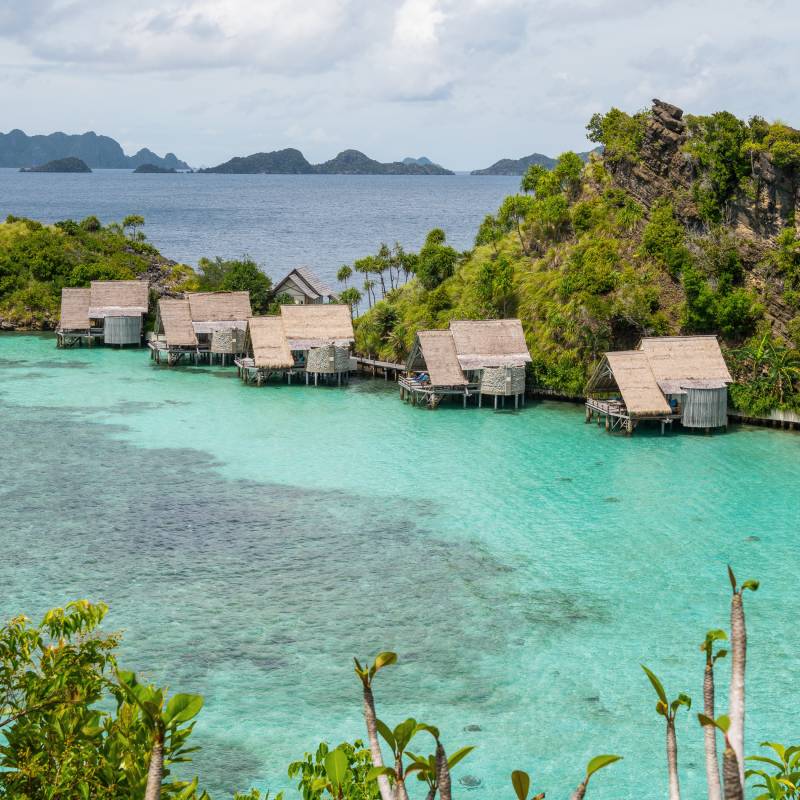
What to Pack for Indonesia
You can expect uniformly warm weather in most parts of Indonesia. Therefore, it is advisable to carry lightweight summer clothing, e.g. cotton. Wear long-sleeved tops and shirts, shades and a hat. to protect yourself from the sun during your tours. During the monsoons, it is best to carry a rain jacket or umbrella.
As a rule of thumb, visitors should know many Southeast Asians are conservative in their clothing. Western clothing is acceptable and is worn by many, but in modest fashion. While visiting shrines and religious places, visitors are recommended not to wear shorts, mini-skirts, vests, tanks, etc. Your knees and shoulders must be covered. Please avoid clothing with images of Buddha, as this is considered highly disrespectful.
The best footwear includes sandals, flip-flops and comfy walking shoes that can be taken off easily. Although it is acceptable to wear shoes when walking in the compound of the temple, you would be required to take them off before you enter the chapel where the main Buddha image is placed, as well as in pagodas and people’s homes.
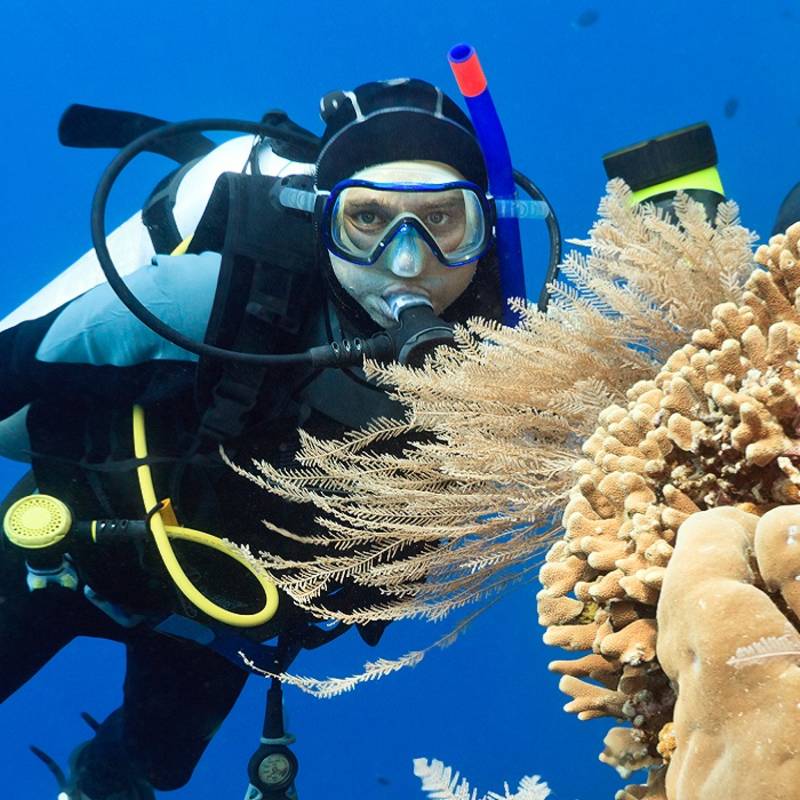
Popular Trips to Indonesia

Indonesia: Classic Sumatra
Discover the essence of Sumatra as you explore its history, culture and food. Marvel at landmarks such as the Tjong A Fie Mansion, Maimoon Palace and the Grand Mosque at Medan before heading into the Bukit Lawang region. Savor the local cuisine on a guided tour and keep an eye out for wild orangutans in…
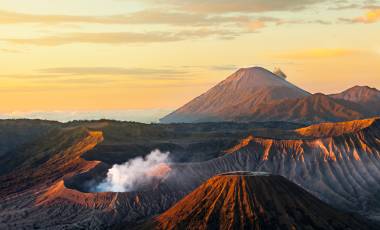
Java, Indonesian Borneo & Bali Islands: Culture, Wildlife & Nature
Embark on an enthralling journey through Java, Indonesian Borneo, and Bali, where culture, wildlife, and nature unite harmoniously. Discover Yogyakarta’s historic temples, Borobudur and Prambanan, and experience the vibrant nightlife with a personalized tour. Venture to Tanjung Puting National Park to spot wild orangutans on a traditional riverboat. Witness the dramatic landscapes of Mount Bromo,…

Indonesia: Highlights of Bali & Flores
Unwind and relax at some of the most stunning beaches at Bali and Flores in Indonesia on this 13-day tour. Ubud, the cultural heart of Bali, beckons with its temples and museums. At the charming mountain settlement of Munduk, discover cascading waterfalls, lush forests and verdant paddy fields. Experience the thrill of spotting a komodo…
Best Places To Visit
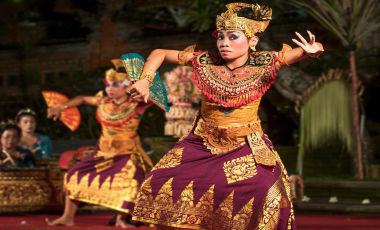
Ubud is the cultural heart of Bali. Home to the country’s royal family, the town is rich in art and at the center of Balinese craft and traditional dance.
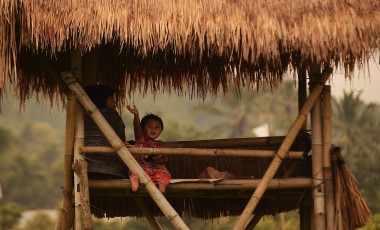
Munduk in Bali is undoubtedly one of the most charming mountain villages of Indonesia. With its lush hills that are dotted with jungles, paddy fields, fruit trees and other island plants, it is the ideal location to unwind within the harmony of nature.
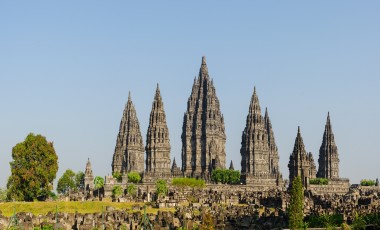
Yogyakarta in Java is a unique place for the appreciation of contrasts. Yogyakarta is best known for its two historic temples: Borobudur Temple, a 9th century Buddhist monument and UNESCO World Heritage site, and Prambanan Temple, dedicated to the divine Hindu Trimurti (trinity).
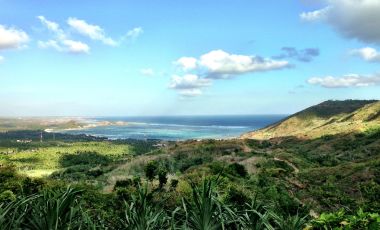
Despite being the same size as Bali, Lombok has managed to retain its privacy. If you seek authenticity, then venture to its black and white sandy beaches, lush forests, and fascinating trails through tobacco and paddy fields.
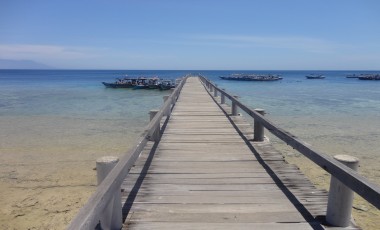
Pemuteran in Bali is the ultimate beach oasis! This hidden jewel is located on the northwestern tip of Bali and is only known to visitors who have been vacationing in Indonesia for years and prefer a quieter beach.
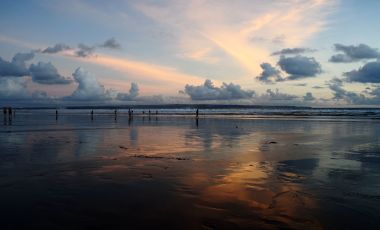
Seminyak is the hedonist hotspot of Bali! Located north of the airport, Seminyak boasts a marvellous beach along a stretch of coastline that has made Bali world-famous.
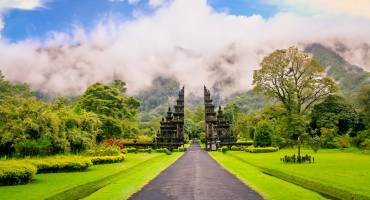
Indonesia Travel Guide
Things to do.
Fiery volcanoes, magnificent temples and beautiful beaches – Indonesia is full of treasures. Follow this link to discover the top highlights, activities and attractions.
Indonesia is considered a safe travel destination. Bali especially is extremely safe as a popular holiday destination. Here are some safety tips to ensure a stress-free vacation.
From the Blog
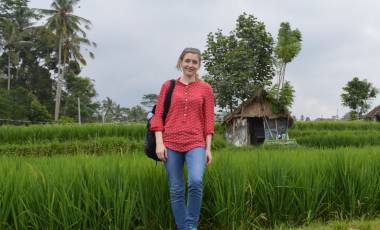
Top Indonesia Travel Tips from Enchanting Travels
Discover more about Indonesia from our Travel Consultant, Kathrin Mayr, who shares her top Indonesia travel tips after experiencing the nooks and crannies of the wonderful island nation! Indonesia – the name alone conjures up images of an exotic paradise with powdery white beaches, smoldering volcanoes, mystical cultures and above all, adventure!
What Our Guests Say

The Enchanting Difference
Authentic & unique.
Our award-winning, licensed local guides provide incredible insights and exclusive experiences for you.
Personalized & Private
Our experts completely customize your private tour to match your interests and preferences.
High-Quality Experiences
All our accommodations and services are personally tested by our team.
Fully Supported Travel
You’ll have a personal and dedicated trip coordinator, backed by 24/7 support in case of emergencies while you’re traveling.
Financial Protection & Flexibility
Your booking is flexible and completely secure with us.
Safe & Secure
Your safety and well-being are our top priorities.
Do you have a vacation in mind? Personalize your itinerary with our Trip Builder.

- 2 Weeks for Couple
- 2 Weeks for Family
- Thailand Lantern Festival
- Indonesia(Bali)
- South Korea
- China (HK, Taiwan)
- Itinerary Ideas
- Asia Highlights Travel Reviews
- Thailand Travel Reviews
- Vietnam Travel Reviews
- Cambodia Travel Reviews
- Japan Travel Reviews
- Myanmar Travel Reviews
- China Travel Reviews

Best & Worst Times to Visit Bali 2024 (First-Timer Guide)
The best times to visit Bali are May, June, September, and October during its dry season. During these months, there are fewer tourists, allowing you to relish the sunny beaches, clear skies, and pristine islands to the fullest.
With a tropical climate, Bali experiences a consistently warm climate throughout the year. Its daytime temperatures are around 30°C (86°F). There are mainly two seasons there: the dry season ((April to October) and the rainy season (November to March). see below some key facts on Bali weather/climate:
- Dry season : April to October
- Rainy season : November to March
- Hottest month : May
- High season : May to September
When Are the Best Months to Go to Bali?
Undoubtedly, the best time to visit Bali is April to October for a sun-soaked vacation. During this period, we've thoughtfully singled out the best months for popular activities and travel themes.
- For a romantic getaway in Bali : the best times to visit Bali are late April to mid-June and late August to early October for fewer peak season crowds.
- For family trips: the island's best weather time (April to October) lines up perfectly with kids' spring break and summer vacations. To avoid local holidaymakers, you're suggested to take your family trip in April, June, or August.
- For water fun : If you seek minimal rainfall and calm seas for water fun, you're suggested to travel to Bali between June and September.
Insider tips: As Bali experiences its peak season during these times, you're suggested to make your bookings at least 3 months in advance, particularly for hotels with great views or family rooms.
Feeling overwhelmed by planning logistics? Just share your interests and we'll customize a hassle-free Bali trip for you in 24 hours!
Check our itineraries of Bali for 10 days .
The Worst Time to Visit Bali
The rainy season (November to March) seems to be the worst time to visit , particularly the rainiest month, January. So for sun seekers with flexible schedules, avoid this period or go to sunbathing island destinations, like Thailand , Vietnam , and the Philippines.
Rainfalls are occurring every 2 or 3 days during these months. The sky may be overcast. It is very humid on the beaches.
However, if your travel date is fixed, traveling in the rainy season still brings benefits: the lowest costs along with the smallest crowds .
Tips to Make "Worst Time" a Better Experience
- Consider late March and early November : They are perfect for enjoying a balance of good weather, fewer crowds, and lower costs.
- Staying on the east coast : consider places like Nusa Dua and Uluwatu, is helpful to get drier experiences too.
- Indulge in indoor activities : such as yoga classes, cooking classes, and hands-on experiences in local workshops.
- Travel with a flexible private Bali tou r ( which we provide ): You can maximize the sunny intervals and easily adapt to short-lived afternoon downpours with minimal hassle.
Temperature and Rainfall in Bali
Click the sign of each month to check the travel guide information.
Bali in January: Wettest Month, The Most Affordable Month
- Average temperature range : 24°C to 33°C (75°F to 91°F)
- Weather : warm/hot, humid, stormy, averaging 27 rainy days, very high rainfall
- Recommended 2024 festival : Gulungan, Bali's most important Hindu festival celebrates ancestral spirits visiting in a great cultural event every 210 days.
January weather conditions may be the worst of the year, but Bali is still warm/hot, and the rain can even offer respite from the heat when it comes as afternoon downpours.
This is the month for finding the best deals on hotels and flights . You'll find uncrowded temples and plenty of space on the beaches. The exception is January 1st to 6th when there are New Year vacationers.
It is not the time for diving, snorkeling, etc. or island hopping, but if you are content to grab some rays when you can on the beach and bring waterproofs/umbrellas for any time in the jungle or on the rice terraces, you could make Bali in January an enjoyable and economical trip.
Bali in February: Wet, Low Prices
- Weather : some downpours, humid, averaging 22 rainy days, high rainfall
Though better than January, February is still an off-season month, featuring regular heavy rain, but low prices and low visitor numbers at top sights...
You could enjoy a peaceful holiday in this month , with some dry hours on the beach on most days , if you're prepared to take it easy, dodge the rain, and spend more time indoors.
Avoid diving and other ocean activities due to poor visibility underwater and strong currents . Rough seas mean ferry crossings aren't recommended. Visibility on Mount Batur is often poor and long hikes are not recommended.
Read more about How to Plan a Trip to Bali >>>
Bali in March: Great Deals and Feww Crowds
- Average temperature range : 24°C to 34°C (75°F to 93°F)
- Weather : some downpours, humid, averaging 20 rainy days, high rainfall
March is still a wet month in Bali, especially in the first half of the month. It starts to get a little warmer and the showers start to peter out at the end of March.
Enjoy low prices and longer gaps between rain . Diving's still out, and hiking's still not recommended. Taking (morning) opportunities to see the scenery and enjoy the beaches, reserving temple visits and other indoor activities for when the rain comes is advised.
Bali in April: Outdoor Adventures Firmly Back
- Average temperature range : 25°C to 34°C (77°F to 93°F)
- Weather : hottest month, but less humid, 9 rainy days, low rainfall
April is the hottest month in Bali . It is not unusual for temperatures to exceed 30°C (95°F) all day, and nights often stay in the high 20s Celsius (the 80s Fahrenheit)!
For beach lovers, hikers, divers… you are almost guaranteed some blue sky days and clear seas , but there will still be some rain on about 1 day in 3.
Bali is busy around Easter , but the rest of the month is a shoulder season time. Staying in a lovely beach resort with air-con in the April shoulder season offers a compromise between economy and the absolute best weather.
Get inspired in Private Bali Tours and make your booking at least three months in advance for affordable price.
Bali in May: Good for Island Hopping
- Weather : hot/warm, pleasant, averaging 8 rainy days, low rainfall
May offers good conditions for Bali's activities, from island hopping to jungle swinging, with minimal chance of disruption.
In May, the shoulder season continues. It's a little cooler and drier than April, so better weather with similar prices.
Bali in June: Fine Weather
- Average temperature range : 24°C to 31°C (75°F to 88°F)
- Weather : warm, clear skies/ocean, averaging 6 rainy days, low rainfall
- Recommended yearly festival : Bali Arts Festival (always mid-June–mid-July) in Denpasar offers a colorful journey into the world of Bali art.
June has lots of sunshine and balmy temperatures. It does not feel humid. This is an ideal month for all the island's outdoor activities .
June is the end of the shoulder season and the peak tourism season will arrive at the end of June. Be prepared for full hotels and full prices. Booking early is recommended.
Bali in July: Great Island Conditions
- Average temperature range : 23°C to 31°C (73°F to 88°F)
- Weather : warm, clear skies/waters, just 4 rainy days, low rainfall
- Recommended yearly festivals : Bali Arts Festival (always mid-June–mid-July) in Denpasar is a great opportunity to see local costumes, dances, and displays. Bali Kite Festival is also held through July at Sanur Beach, south Bali.
Enjoy great conditions for tropical relaxation and adventure. You could even plan to climb Mount Batur , Bali's iconic volcano with a lake, with only a slim chance of any significant rain. Sunrise treks with high visibility are a highlight of Bali's dry season .
Tourism comes to a peak in July and prices for accommodation reach their highest. It is best to book accommodation early (at least three months in advance) to avoid extra cost or hotels being fully booked.
Check how to plan a trip to Singapore and Bali >>>
Bali in August: Best Month Weatherwise
- Average temperature range : 23°C to 30°C (73°F to 86°F)
- Weather : warm, clear skies/waters, just 4 rainy days, very low rainfall
- Recommended festival : Indonesian Independence Day on August 17 has parades and other outdoor festivities.
August is the peak month for traveling to Bali. Virtually no rain means travel plans can be made with certainty and the best of snorkeling etc. conditions can be enjoyed.
Get your rooms and tours booked early, whether you're looking for a romantic getaway, a tropical family vacation, or a well-earned treat to boost your wellness for the rest of the year.
Read more about Bali Honeymoon Trip Plan: Sample Itinerary, Romantic Experiences >>>
Bali in September: More Balmy Weather
- Weather : warm, clear skies/waters, 8 rainy days, low rainfall
Tourism starts to drop off a bit after August, and September is considered a shoulder month (mainly as it's the back-to-school month for many nations).
Though there is a little more rain, it's still not significant. If you can visit in September, it should be good conditions for less money.
Bali in October: End of the Dry Season
- Weather : heat/humidity builds, showers more often, ~12 rainy days, low rainfall
Bali experiences increasing rainfall towards the end of October, making it another month where deals can be had, as hotels try to fill rooms as demand drops.
In general, October is good value for money. It is your last chance to enjoy diving in Bali before the rainy season sets in and the ocean clouds up.
Bali in November: Off Season Starts
- Weather : hot/humid, a few downpours, averaging 16 rainy days, moderate rainfall
The sea in Bali is noticeably rougher during November, which is not good for water activities , though rainfall doesn't reach high amounts yet, so you might still get a day's hiking in carrying waterproofs.
November is definitely in the off season, but there are still plenty of things that you can do.
Bali in December: Rainy Season in Full Swing
- Weather : hot/warm, some downpours, averaging 22 rainy days, high rainfall
Although the wet season means some things like diving and mountain hikes are off the cards, you could still dodge the rain for sunny spells on the beach and yoga in the jungle. Enjoy delicious Balinese food indoors and its cultural attractions while you wait for the rain to stop.
Further north in SE Asia, the weather is much better. See The Best Times to Visit Southeast Asia .
Though low season, some tourists still come to Bali, particularly in late December as there are Christmas and southern hemisphere summer holidays, bringing up prices a little.
Plan Your Bali Vacation with Us
Discover Bali through our unique tours, with award-winning guides and with 1:1 help from a dedicated Bali expert every step of the way.
Tell us your interests and needs , and we will create a wonderful trip for you. We are ready to show you the authentic and blissful highlights of Bali, whatever time you visit.
Here are some itineraries you might like to start from:
- 7-Day Private Bali Natural & Cultural Immersion
- 12-Day Romantic Bali & Java Honeymoon
- 13-Day Private Singapore and Bali Journey of Discovery
Why Asia Highlights (10,000+ reviews & 98.8% 5-star rating)
- Save Your Time:
- Less research, more enjoyment!
- Real-time 1V1 expert planning
- Maximize Your Flexibility:
- Personal local guide and ride
- Explore at your own pace
- Celebrate Your Journeys:
- Specially-crafted family adventures
- Celebrate milestones with style!
- 10-Day Family Fun Trip to Bali
- 12-Day Thailand, Singapore, and Bali Tour
- 20-Day Vietnam, Thailand, Cambodia, and Bali Tour
- How to Plan a Trip to Bali
- How to Plan a 1–2-Week Itinerary to Bali
- How to Plan a Trip to Singapore and Bali 2024/2025
- How to Plan a Trip to Thailand, Singapore and Bali 2024
- Bali Weather in January: Temperature and Best Places to Go
- Bali Weather February: Best Places to Visit
- Bali Weather in March: Best Places to Visit and Travel Tips
- Bali Weather in April 2024: Best Places to Go & Travel Tips
- Bali Weather in May 2024
- Bali Weather in June 2024: Best Places to Go & Travel Tips
- Bali Weather in July 2024: Best Places to Go & Travel Tips
- Bali Weather in August 2024: Best Places to Go & Travel Tips
- Bali Weather in September 2024: Temperature and Best Places to Go
- Bali Weather in October 2024
- Bali Weather in November 2024: Temperature and Best Places to Go
- Bali Weather in December 2024: Best Places to Go & Travel Tips
Get Inspired with Some Popular Itineraries
At Asia Highlights, we create your kind of journey — your dates, your destinations, at your pace. You can have any trip tailor made for your travel.
More Travel Ideas and Inspiration
Sign up to our newsletter.
Be the first to receive exciting updates, exclusive promotions, and valuable travel tips from our team of experts.
Why Asia Highlights
Where can we take you today.
- Middle East
- African Safari
- Travel Agents
- Loyalty Program
- Our Differences
- Privacy Policy
Address: Building 6, Chuangyi Business Park, 70 Qilidian Road, Guilin, Guangxi, 541004, China
Bali Travel Guide

Best Times To Visit Bali
The best time to visit Bali is between April and October, during the dry season, when you can expect warm, sunny days and low humidity. The offseason (from November to March) can be a great time to travel if you want to escape the crowds; downpours are often heavy but short-lived. Thanks to Bali's location close to the equator, in the southern hemisphere, daytime temperatures hover around the low 80s year-round, with only humidity and precipitation patterns changing. The lack of rain during the summer season makes Bali more comfortable for beachgoers.
Weather in Bali
Data sourced from the National Climatic Data Center
Find Flight and Hotel Deals
Navigate forward to interact with the calendar and select a date. Press the question mark key to get the keyboard shortcuts for changing dates.
Navigate backward to interact with the calendar and select a date. Press the question mark key to get the keyboard shortcuts for changing dates.
Popular Times to Visit Bali
Tourism volume is estimated based on in-market destination search query interest from Google and on travel.usnews.com in 2015-2016. Hotel prices are sourced from a sample of U.S. News Best Hotels rates through 2015-2016.
Explore More of Bali

Things To Do

Best Hotels

You might also like

# 1 in Best Places to Visit in Asia

# 1 in Best Beaches in the World for 2024

# 1 in Best Places to Visit in Australia and The Pacific in 2023
If you make a purchase from our site, we may earn a commission. This does not affect the quality or independence of our editorial content.
Recommended
The 28 Best Water Parks in the U.S. for 2024
Holly Johnson|Timothy J. Forster May 8, 2024

The 18 Best Napa Valley Wineries to Visit in 2024
Lyn Mettler|Sharael Kolberg April 23, 2024

The 25 Best Beaches on the East Coast for 2024
Timothy J. Forster|Sharael Kolberg April 19, 2024

The 50 Best Hotels in the USA 2024
Christina Maggitas February 6, 2024

The 32 Most Famous Landmarks in the World
Gwen Pratesi|Timothy J. Forster February 1, 2024

9 Top All-Inclusive Resorts in Florida for 2024
Gwen Pratesi|Amanda Norcross January 5, 2024

24 Top All-Inclusive Resorts in the U.S. for 2024
Erin Evans January 4, 2024

26 Top Adults-Only All-Inclusive Resorts for 2024
Zach Watson December 28, 2023

Solo Vacations: The 36 Best Places to Travel Alone in 2024
Lyn Mettler|Erin Vasta December 22, 2023

26 Cheap Beach Vacations for Travelers on a Budget
Kyle McCarthy|Sharael Kolberg December 4, 2023


Best Time to Visit Bali: Month by Month Breakdown
Bali is one of the most popular islands in Southeast Asia, and deciding the best time to visit Bali is going to affect not only the weather you experience but also how many other tourists are there with you.
Like most of tropical Indonesia, Bali only really has two seasons throughout the year, the dry season and the wet season.
All year-round, it’s hot, and for many, Bali can be visited any time of the year, but between November and March, you can expect downpours most days during the wet season.
April to October is the dry season and you can expect larger crowds and higher prices but the weather will be perfect.
Often, the best time to visit Bali is a trade-off between the weather and the number of visitors.
To help you to plan your trip, here’s our guide on the best time to visit Bali.
Don’t leave home without: Lonely Planet Indonesia (Country Guide)
Table of Contents
Bali Dry Season

The dry season is the best time to visit Bali when it comes to the weather because for half of the year you can expect beautiful clear skies and almost no rainfall.
The dry season in Bali runs from May to October, although this can vary each year. The peak months are the height of the Balinese winter, which is June, July, and August.
May in Bali
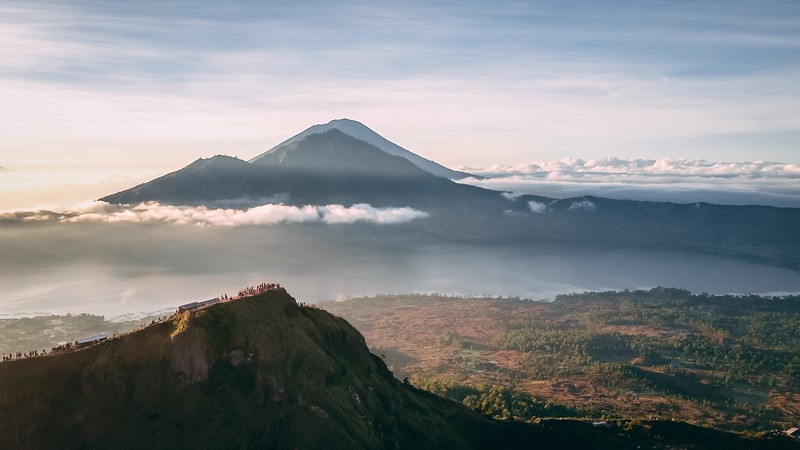
May is the start of the official dry season in Bali, but you can still expect a mixed bag when it comes to the weather.
One year it could be raining all through May but the next it can be dry from as early as April.
If it does rain in May though it’s guaranteed to just be a few light showers, and this is the best time to visit before you hit the high season from June to August.
Prices will be lower in May and with the better weather, it’s a good time to start diving and snorkeling, as the water visibility clears up.
It’s getting cooler too and less humid, so a hike to the summit of Bali’s mysterious volcano, Mount Batur, can be a great activity in May, as you’ll miss the crowds and enjoy better conditions for hiking.
June in Bali

June is the start of the high season in Bali, although it’s not quite as busy a month as July and August. The weather is likely to be perfect with temperatures averaging in the mid-twenties and humidity low.
You’ll have to be really unlucky to see even a light rain shower, so it’s a great time to hit up the beaches and make the most of the clear skies and sunshine.
Prices start to climb in June, but you’ll miss the worst of the high season which picks up towards the end of the month when the European summer holidays begin in earnest.
In June you should visit the more touristy attractions such as the famous temples in the south – Uluwatu for instance – or the increasingly popular Nusa Islands before the summer crowds make their appearance.
July in Bali

July is usually the busiest month to visit Bali, but for good reason, and that’s because you’ll be enjoying the best weather of the year.
But as well as enjoying sunny, clear skies and zero rain, you’ll be sharing the beaches and resorts with hundreds of thousands of holidaymakers. People flock here from Europe, America and more than anywhere else, from Australia.
Prices will be higher for flights and hotels, but if you do want to escape the crowds then head north.
This is a great time to experience a side of Bali that most miss, and by exploring the black sand beaches of Amed or the coast and jungle of Bali Barat National Park, you’ll see how the south of Bali was a few decades previously.
August in Bali

Much like July, August is always super busy in Bali. The weather is again beautiful, with clear skies and sunny days, and it’s a great time for lounging on beaches and drinking cold Bintang Beers.
If you want to escape the holiday crowds though then plan a trip north, and visit the beautiful coastline in more rustic destinations such as Lovina or Amed, where tourism has only recently begun to develop.
There are great snorkeling and diving up north too, including some famous shipwrecks, and as it’s the height of the dry season the water will be beautifully clear.
September in Bali
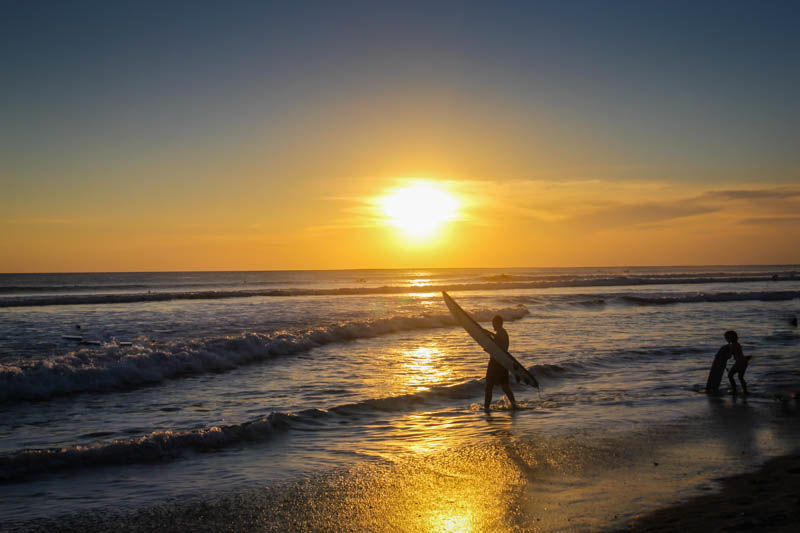
September can be the best time to visit Bali if you want a great mix of good weather and smaller crowds.
Things will still be busy and flights will be more expensive than the later shoulder season months. But you’ll save money compared to the true high season and have fewer people around when you explore touristy destinations such as Ubud, Kuta or the Nusa Islands.
October in Bali
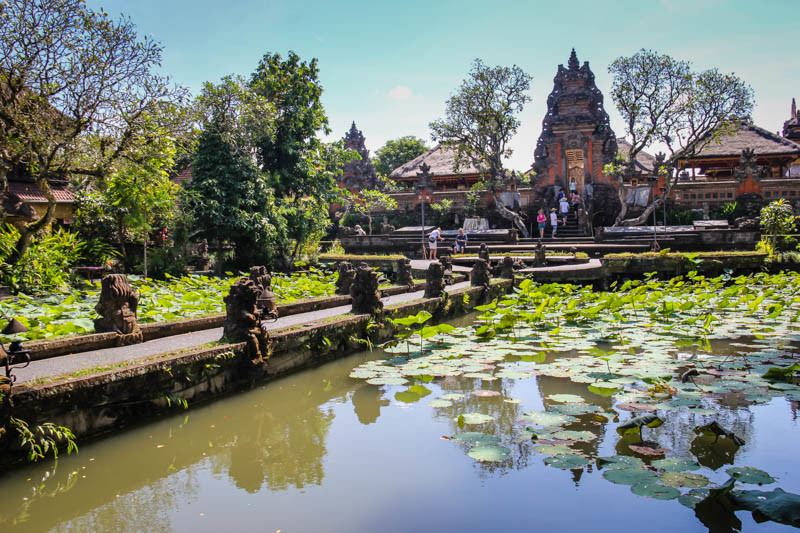
October is a great shoulder season month, but the dry weather is coming to a close. There are more and more rainy days, but these can be unpredictable.
If you’re in Bali for two weeks, you’ll most likely have enough dry days to make the most of your visit.
Enjoy the south and the more traditional beach areas, get cultural in Ubud or escape to the north to see a wilder side of the island.
Bali Wet Season

The wet season in Bali runs from November through to April, corresponding with the southern hemisphere summer and fall.
It’s tropical, and that means that while it does rain hard when it rains, showers and storms are brief but fierce.
The rainy season can be a great time to miss the crowds but give December and January a miss because these two months are still incredibly popular despite the wet weather.
November in Bali

November is when the rainy season starts in Bali, but just how much rain there will be, can vary.
You’ll have good odds of having lovely sunny days still, and it’s a great time to visit because you’ll miss the Christmas crowds who are just around the corner.
You can get wonderful deals on flights and hotels through November, and you’ll still be able to snorkel and dive before the water gets too cloudy from the rains.
It’s getting hotter, but take a trip to the summit of Mount Batur and you’ll be able to cool down after a challenging hike to the top of Bali’s iconic volcano.
December in Bali

December is usually the rainiest month of the year, and weather-wise, this really is not the best time to visit Bali.
The tourist crowds would beg to differ though because while you might get soaked, it’s also incredibly warm still.
That draws over the Christmas crowds seeking winter sun from Europe and North America , and it still brings over the Aussie crowds looking for a cheap getaway.
It’s a lively time to be in Bali, and it’s not a bad place at all to spend Christmas and New Year, but be prepared for high prices and lots of other travelers and tourists.
January in Bali

January can be just as busy as December and unfortunately, just as rainy. This is the height of the wet season, but again, it doesn’t put off the crowds.
If you do visit, then the southern beaches and classic resort areas are best avoided. Head north instead, and find a bit more peace and quiet in the lesser-visited parts of Bali.
February in Bali

In February, the weather starts to cool down slightly and the rainy days begin to disappear, but it’s still very much the wet season.
It’s a great shoulder season month, right after the Christmas crowds go home, and you can enjoy many of Bali’s best sights with fewer people around.
Head to the waterfalls, as they will be in their element, and the jungle will be lush and green from all the rainfall over the last few months.
March in Bali

March can be a wet month or it can be a dry month, the weather gods in Bali are unpredictable this time of the year.
It will be a quiet month on the tourism front though and that makes it the best time to visit Bali if you’re a fan of shoulder season travel.
The Christmas and New Year crowds are long gone, and the dry season tourists are a few months away.
You can get great deals on flights and resorts if you book in advance, and you’ll find that lots of beach areas in the south such as Kuta, Seminyak or Canggu are quieter.
This is Bali though, so if you’re here for the social aspects then there are always other travelers around to hang out with.
April in Bali

April is a great shoulder month, but be careful of the Easter Holidays in Australia or Europe, as Bali becomes a popular holiday break destination during this time of the year.
You could enjoy almost all sunny days or conversely it could also rain a lot, but that’s the gamble in April as the rainy season draws to a close.
It’s the tail end of the wet season though and Bali will be blooming, making this a great month to visit the waterfalls and the rice paddies before they start to dry out again.
Visit Ubud for cultural festivals and then hike through the rice terraces nearby.
Top Recommended Tours:
- Wellness Bali with G Adventures – 9 days
- Classic Bali with G Adventures – 8 days
- Active Bali & Java with G Adventures – 12 days
- Bali: Beaches & Boat Rides with G Adventures – 9 days
- Classic Bali & Sailing Adventure with G Adventures – 14 days
More on Indonesia:
- 17 Epic Things to do in Lombok, Indonesia
- Paradise Found in the Raja Ampat Islands, Papua Indonesia
- 11 UNREAL Places to Visit in Indonesia
- Top Things To Do in Indonesia
- 15 Unmissable Things to Do in Ubud, Bali
- 21 EPIC Things to Do in Bali
- 5 Reasons Why Bali Is Not the Paradise You Think It Is
- Photographing the Kuta Sunset in Bali
- What to wear in Bali: The Ultimate Packing List
- 15 Photos and Facts About Visiting Gili Trawangan
Did you like this story? Share it!
Travel planning resources, about david stock.
I have always been an outdoorsman so becoming an adventure traveler was just the next natural step. I love nature, I love to get off the beaten path and I like to explore. I enjoy scuba diving and cars. And yes, Lina and I have a naked dog.
Leave a Comment Cancel reply

UK Edition Change
- UK Politics
- News Videos
- Paris 2024 Olympics
- Rugby Union
- Sport Videos
- John Rentoul
- Mary Dejevsky
- Andrew Grice
- Sean O’Grady
- Photography
- Theatre & Dance
- Culture Videos
- Fitness & Wellbeing
- Food & Drink
- Health & Families
- Royal Family
- Electric Vehicles
- Car Insurance Deals
- Lifestyle Videos
- UK Hotel Reviews
- News & Advice
- Simon Calder
- Australia & New Zealand
- South America
- C. America & Caribbean
- Middle East
- Politics Explained
- News Analysis
- Today’s Edition
- Home & Garden
- Broadband deals
- Fashion & Beauty
- Travel & Outdoors
- Sports & Fitness
- Sustainable Living
- Climate Videos
- Solar Panels
- Behind The Headlines
- On The Ground
- Decomplicated
- You Ask The Questions
- Binge Watch
- Travel Smart
- Watch on your TV
- Crosswords & Puzzles
- Most Commented
- Newsletters
- Ask Me Anything
- Virtual Events
- Betting Sites
- Online Casinos
- Wine Offers
Thank you for registering
Please refresh the page or navigate to another page on the site to be automatically logged in Please refresh your browser to be logged in
The Independent's journalism is supported by our readers. When you purchase through links on our site, we may earn commission.
The best countries to travel to in Southeast Asia
From indonesia to malaysia, the must-visit destinations on this corner of the continent, article bookmarked.
Find your bookmarks in your Independent Premium section, under my profile
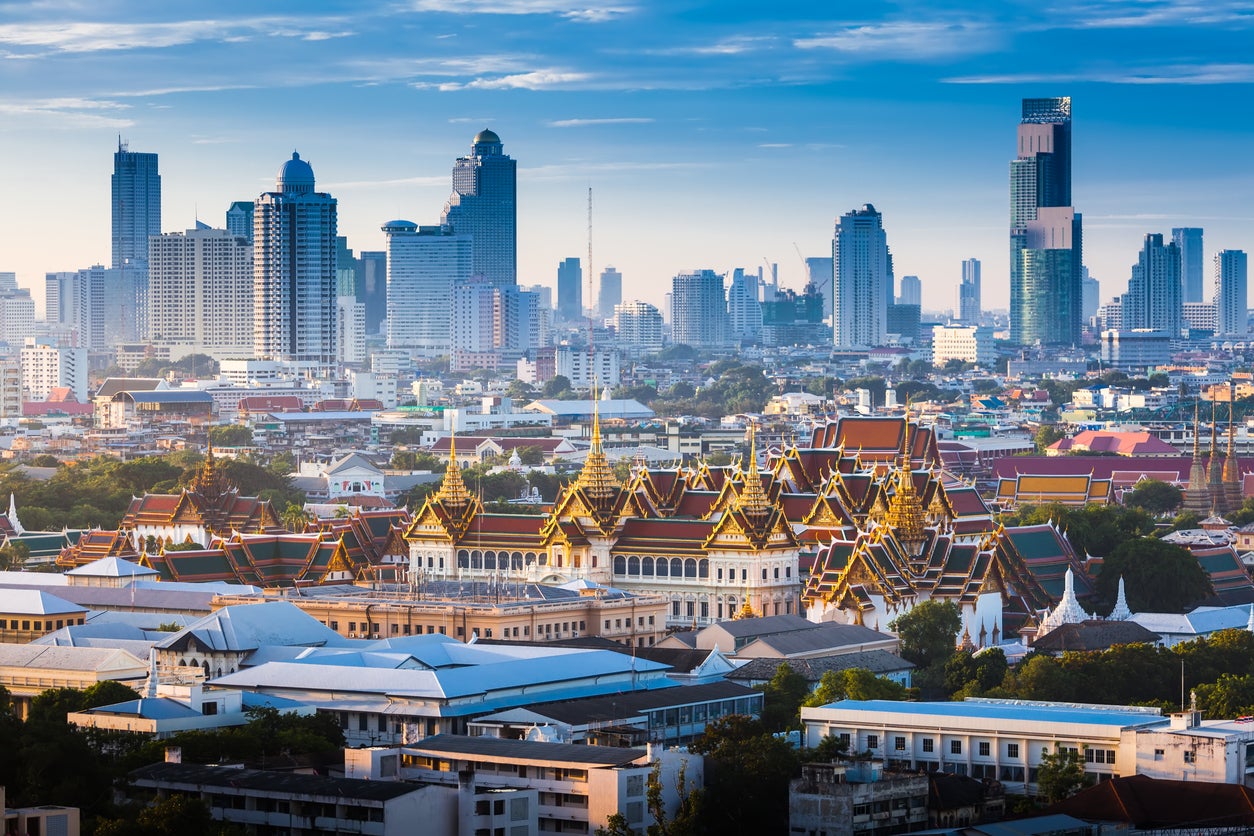
Sign up to Simon Calder’s free travel email for expert advice and money-saving discounts
Get simon calder’s travel email, thanks for signing up to the simon calder’s travel email.
Southeast Asia is a blend of fascinating traditions and cultures, with some of the most incredible temples, palaces and natural sites on the planet.
This region is home to famed attractions, from Angkor Wat to Ha Long Bay, as well as a selection of sprawling cities – including Bangkok , Kuala Lumpur and Singapore – and miles of pristine coastlines around Indonesia and the Philippines.
And though places such as Bangkok and Singapore have seen high numbers of British tourists for decades, other destinations are starting to attract more people, from lesser-known Laos to the neighbouring backpacker favourite of Cambodia .
Whether you’re looking to throw yourself into exploring a city or hop around a handful of serene tropical islands, your options are pentiful in this corner of the world.
Below are Independent Travel’s picks for the region’s best countries to visit on holiday; read on to start planning your next long-haul getaway.
Thailand has long been a tourist favourite for Brits, whether for travelling youngsters or business people. Its capital, Bangkok (known locally as Krung Thep) was the most visited city in the world for several years in a row before Covid and is just a short journey away from the ancient city of Ayutthaya .
With dozens of famous white-sand beaches around the country (such as Railay and Ko Phi Phi ), as well as several areas of natural beauty (one of the most unique being Khao Sok National Park) and dozens of temples and palaces, Thailand offers anyone visiting the country a diverse mix of sightseeing, city experiences and relaxation – not to mention the nation’s delicious cuisine.
Best time to visit Thailand
With a rainy season falling between July and October, the best time to visit is between November and April, when temperatures are higher (with average highs in the early 30s). May is usually a quieter time to visit, but the sunshine may be interrupted by short rain periods.
Vietnam’s various areas of natural beauty are among the most notable in the region. Ha Long Bay is the country’s most famous natural area, while the beaches of Phu Quoc and the Cham Islands offer equal beauty in different settings. Other natural attractions include the caves of Phong Nha and Hang Son Doong, the Marble Mountains and the sand dunes at Mui Ne.
As for cities, Ho Chi Minh City , Hanoi and Da Nang are the best destinations for those who want to experience Vietnamese ‘hustle and bustle’ (Da Nang also has beach areas), while Hoi An is sometimes referred to as the ‘Venice of Vietnam’ due to its canals and the well-preserved Ancient Town comprised of wooden Chinese shophouses and French colonial buildings.
Best time to visit Vietnam
April and September fall just before and after the high season in Vietnam and also offer less humidity and lower temperatures than at the peak of summer. With weather that can vary quite drastically across the country in different months, these should give the best weather across the board too.
Read more on Asia travel :
- Why you should visit Koh Samui now
- Can Cambodia become Southeast Asia’s sustainable travel capital?
- Celebrating Thailand’s Songkran festival in Chiang Mai
Singapore is a popular destination for British expats, with an estimated 50,000 living there. It’s a country that is almost unlike any other; its urban planning strategy has created a metropolis and enabled almost six million people to live in an area roughly half the size of London.
Despite its diminutive size, the country offers numerous attractions , from its Botanic Gardens (a Unesco world heritage site) and historical and art museums to the Gardens by the Bay , a nature park spanning 101 hectares, and a Universal Studios theme park. It also hosts a Formula 1 race, which takes place in September on the Marina Bay Street Circuit.
Best time to visit Singapore
Singapore has significant rainfall all year, although the country’s dry season falls between February and April, when humidity levels are also at their lowest. Specifically, February and September offer the lowest rainfall and humidity, with average highs of around 31C. September also falls in low season.
By far the largest country in Southeast Asia, Indonesia lies at the southern end of the region and consists of roughly 17,500 islands, including Sumatra and Bali. With so many islands, it’s no surprise that the archipelago contains some of the region’s most attractive areas. Bali in particular is a tourism hotspot, while many of the islands offer tropical rainforests, rugged terrain and even volcanoes (the country sits within the Pacific Ring of Fire and is prone to both eruptions and earthquakes).
Jakarta is the capital and largest city in the country and is located – along with the popular tourist town of Yogyakarta– on the island of Java. Idyllic locations include Lombok and the Raja Ampat islands; Bromo Tengger Semeru and Komodo National Parks offer unreal nature and wildlife-spotting opportunities.
Best time to visit Indonesia
The dry season usually runs from April to October, which is also when the country welcomes the most tourists. If you want to avoid crowds, May and June offer average highs of roughly 31C and over eight hours of sunshine per day.
Malaysia’s culture is an eclectic mix of European, Chinese, Indian and Malay influences, while the country itself is famous for its rainforest, beaches and the capital city of Kuala Lumpur , with the iconic Petronas Twin Towers being one of the country’s most iconic symbols.
Away from the capital, many tourists decide to visit the Malaysian part of Borneo – in the north of the island – where rainforest treks, wildlife viewing and relaxing on the beach are all possible. The Perhentian Islands and Sipadan are two other popular destinations, while nature-lovers flock to the Batu Caves, Mount Kinabalu and the Cameron Highlands.
Best time to visit Malaysia
You can expect fewer crowds from March to June; these months have average temperatures of around 28C, while June is the driest month of the year (though bear in mind you can still expect showers every month).
Philippines
Another archipelago, the Philippines consists of more than 7,000 islands. Under Spanish rule for over 300 years, it is one of the only predominantly Roman Catholic countries in the whole continent and has been widely influenced by Western culture and traditions. For those keen to see its cities, Manila is the capital while Quezon is the largest.
Tropical white-sand beaches are plentiful on the nation’s thousands of isles, while the volcanoes of Mayon and Tail offer dramatic scenery overlooking the water. Other sites include Sigma Lagoon, Pagsanjan Falls and the Batad rice terraces.
Best time to visit the Philippines
The Philippines dry season falls right in the middle of the low season for tourism. The driest months are between January and March, where there is little rainfall and humidity falls to much more tolerable levels. Expect temperatures of up to 24C – and lows of 15C – every day.
Cambodia welcomes visitors eager to learn about its complicated history and experience its mix of Asian and French culture. A largely rural country, only three of its cities are home to over 100,000 people despite the country’s 16 million-strong population. Phnom Penh is the capital and largest city, while Siem Reap is another metropolitan centre that also acts as the gate to Angkor Wat, an ancient temple which today is the largest religious structure in the world.
The country’s islands, such as Koh Rong and Koh Rong Samloem, contain pristine white beaches, sandy coves and coral reefs , and are popular spots for partying too. The Cardamom mountain range stretches over 4.4 million hectares of rainforest through the Southeast and into eastern Thailand, and is home to a vast range of wildlife, including sun bears, elephants and Siamese crocodiles. Tonle Sap lake is the largest in Southeast Asia, with its waters and floodplain home to over three million people and hundreds of different animal species.
Best time to visit Cambodia
Temperatures are at their lowest in the dry season between November and February, but you’ll still see average highs of 30C.
Laos is one of the continent’s smaller countries, and its shared borders – with Vietnam to the east, Thailand to the west and Cambodia to the south – give you an indication of the geography that you’ll find here. Whether you want to go through dense jungle on a cruise along the winding Mekong River, trek through the jagged karst around Vang Vieng or simply relax in the laid-back capital of Vientiane, there’s something to appeal.
Laos’ most important landmark is the Pha That Luang, a golden Buddhist stupa in Vientiane, while the capital’s other highlights include temples like Wat Si Saket and the old quarter. If you have time, visit the peaceful Song River and the town of Vang Vieng, before exploring the Unesco city of Luang Prabang and surrounding nature, including waterfalls, plunge pools and the banks of the Mekong.
Best time to visit Laos
The weather is Laos is best between October and April, when conditions are dry and not too warm. For river cruises, November through to January is best for high water levels, while August is both the wettest and most humid month.
Join our commenting forum
Join thought-provoking conversations, follow other Independent readers and see their replies
Subscribe to Independent Premium to bookmark this article
Want to bookmark your favourite articles and stories to read or reference later? Start your Independent Premium subscription today.
New to The Independent?
Or if you would prefer:
Want an ad-free experience?
Hi {{indy.fullName}}
- My Independent Premium
- Account details
- Help centre
Nomadic Matt's Travel Site
Travel Better, Cheaper, Longer
Southeast Asia Travel Guide
Last Updated: November 27, 2023

Backpackers have been traveling through Southeast Asia since the late 1960s and early 1970s, leaving a well-worn trail around the region.
Starting in beautiful Thailand, the trail makes its way to up-and-coming Laos, through Vietnam, and to the temples of Angkor Wat. It then winds back into Thailand, where people head south to party in the Thai islands before moving down to Malaysia and Singapore.
There are a few variations to the trail, but this is what it mostly covers.
I’ve been visiting this region since 2004 and spent years living in Thailand . I love backpacking Southeast Asia and have written extensively about it as I know it like the back of my hand.
It’s an especially great region for new travelers because it’s easy to travel around, it’s safe, and there are lots of other travelers you can meet. But it’s also perfect for veteran travelers too as there are tons of off-the-beaten-path destinations that the standard backpacker trail doesn’t cover.
In short, Southeast Asia has something for every traveler — and every budget.
This Southeast Asia travel guide will help you travel the region like a pro, ensuring you save money and make the most of your time in this fun, gorgeous, and lively corner of the world.
Table of Contents
- Things to See and Do
- Typical Costs
- Suggested Budget
- Money-Saving Tips
- Where to Stay
- How to Get Around
- How to Stay Safe
- Best Places to Book Your Trip
- Related Blogs on Southeast Asia
Click Here for Country Guides
Top 5 things to see and do in southeast asia.
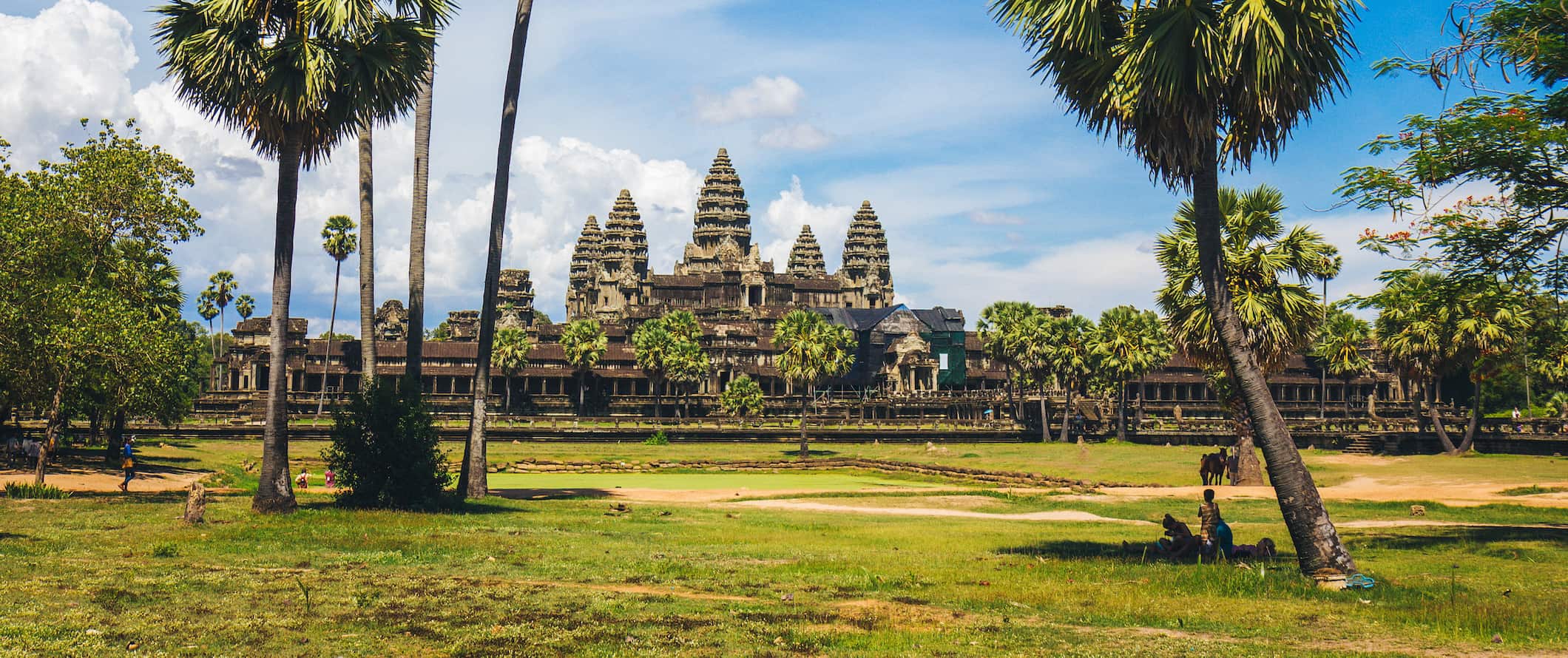
1. Admire Angkor Wat
One of the greatest human creations in history, the Angkor Wat temple complex is best explored over the course of a few days. The area is a UNESCO World Heritage Site created by the Khmer Empire and absolutely enormous. Temples to visit include Angkor Wat, Bayon Temple which has 216 gigantic stone face carvings, and Ta Prohm. I spent three days here and that simply wasn’t enough. A one-day pass is $37 USD, while a 1-week pass is $72 USD. If you’re here for multiple days, be sure to hire a driver and see some of the more out of the way ruins away from the main temple complex (and the crowds).
2. Explore Bangkok
Bangkok is the hub of travel activity in Southeast Asia. You can get anywhere you want from here. Though I hated it at first, the more I’ve spent time here the more I love it. Bangkok is like an onion whose many layers need to be peeled back. Some things not to miss include the spectacular Bangkok Grand Palace, Wat Pho, Chatuchak Market and Asiatique, and a canal trip on the Chao Phraya River. This is a city for foodies and wild nightlife.
3. Relax on some tropical islands
No visit to Southeast Asia would be complete without a visit to at least one of the thousands of tropical islands in the region. My top five include the Perhentian Islands (Malaysia), Rabbit Island (Cambodia), Ko Lanta (Thailand), and Boracay (Philippines). Lombok Island (Indonesia) has a chill vibe with unspoiled, perfect “desert island” beaches. There’s so many islands to visit. Be sure to add at least one to your trip. The country guides will have more information for you.
4. See Ha Long Bay
Sailing trips to this island-filled bay with stunning emerald waters, limestone formations, and marine life give you an appreciation for the natural beauty in Vietnam. Tours from Hanoi start at around $110 USD for two-day trips and increase from there. I love the colorful grottoes, hanging stalactites, and stalagmites of Surprise Cave (Sung Sot), Fairy Cave (Tien Ong), and Heaven Palace (Thien Cung). Make sure you go with a reputable company though as some of the cheaper boats are less than ideal. If you’d rather just visit for one day, day trips from Hanoi cost $55 USD.
5. Wander Kuala Lumpur
Other things to see and do in southeast asia, 1. go jungle trekking.
This region of the world is covered in amazing jungles with diverse wildlife, plentiful camping opportunities, and cool waterfalls. The best jungle treks are found in northern Thailand, Western Laos, and Malaysian Borneo (the latter are also the hardest and most intense). Some of my favorites include Danum Valley (Borneo) for its incredible wildlife; Ratanakiri (Cambodia) for its pristine wilderness and thousand-year-old trees; and Pu Luong Nature Reserve (Vietnam). Costs vary but jungle trekking generally costs $30-50 USD per day.
2. Attend the Full Moon Party
The biggest one-night party in the world welcomes up to 30,000 people with a party that stretches until dawn. Cover yourself in glow paint, grab a bucket of booze, and dance the night away with new friends on the island of Ko Phangan in Thailand. As the name would suggest, the party is on the night of the full moon. If you miss it, there’s always the half-moon party, quarter-moon party, and black-moon party. Really, every night is a party on Ko Phangan . Just avoid the flaming jump rope that occurs — I’ve seen people get burned badly!
3. Learn to dive
There are many great dive sites around the region for those interested in underwater exploration. You can learn to dive here at a fraction of what it would cost back home too. Some of the best places are Ko Tao (Thailand), Sipadan (Malaysia), as well as Gili Islands (Indonesia) and Coron, Palawan (The Philippines). A typical diving course is completed in three days. A PADI course typically runs $275 USD in Thailand, including three nights’ accommodation, though at smaller schools you can often negotiate down to $250 USD. Day trips for certified divers start at $165 USD. For information on Ko Tao, check out this blog post .
4. Eat street food in Singapore
Singapore is a foodie’s heaven. Try the hawker stalls of Singapore as well as Little India and Chinatown for some of the best and cheapest food in Asia. If you’re looking for a nice place to sit down and eat, eat at Singapore’s famed restaurants during lunch when restaurants offer discounts, making them a great deal. You’ll also find the most affordable Michelin-starred restaurants here (Tian Tian Hainanese Chicken Rice and Hawker Chan), offering world-class meals for just a couple of bucks!
5. Overload on temples
You can’t turn a corner without seeing a Buddhist temple in this part of the world. You’ll get temple overload at some point but visit as many as you can as each is unique to the country and region of the temple. There are so many places with high concentrations of ornate and beautiful temples. Check out Chiang Mai’s Wat Doi Suthep Temple and hike up the 300 steps to the golden Chedi that’s 600 years old!; Bagan’s Shwesandaw Pagoda from the 11th century with its stunning golden dome; Angkor Wat’s Ta Prohm is covered in iconic vines and enveloped in ancient jungle roots; Hue’s colorful Thien Mu Pagoda is perched atop a lush green embankment; Hoi An’s Quan Cong Temple with incredible Chinese architecture with hand-carved beauty and skill, and Luang Prabang’s Vat Xieng Thong with its golden, canopied roof. Most are free to enter, however, dress codes are enforced (you need to have your shoulders and legs covered).
6. Dive Sipadan
Located off Malaysian Borneo, Sipadan is one of the best dive sites in the world. If you have your dive certificate, make sure you venture out here. I absolutely love this area because it’s teeming with live turtles, diverse cave systems, sharks, dolphins, colorful coral, bright fish, and everything in between. Not a lot of people make it to this part of Malaysia, but it’s worth it to go the extra mile and make your way off the tourist trail a bit. Don’t miss Barracuda Point and The Drop-Off. Keep in mind that only 176 permits to dive at the island are issued each day, costing 140 MYR per person. The resorts on the neighboring islands each get a specific number of permits per day and require divers to stay with them for a few days. So you’ll need to stay at those resorts and dive into the surrounding areas before they can get you a Sipadan permit.
7. Fall in love with Bali
Bali is the most popular destination in Indonesia, and its famous Kuta beach is known for its wild parties and surfing ( though I think it’s overrated ). However, there is much more to Bali than just wild nights and sun-soaked days. If you’re a thrill seeker, hike up to the top of Mount Batur, an active volcano, for a breathtaking sunrise. Paragliding and white water rafting are also super popular here, as is surfing (it’s an affordable place to learn if you’ve never done it). There are also lots of hot springs to enjoy, the Ubud Monkey Forest (a popular temple and nature reserve home to hundreds of monkeys), and numerous places to scuba dive, including the Liberty wreck and Manta Point.
8. Take in Ho Chi Minh City
Frantic, chaotic, and crazy, Ho Chi Minh City in Vietnam is the embodiment of the controlled chaos that rules Southeast Asia. You can’t quite figure out how this teeming mass of people and cars work together, but it does. Highlights here include touring the tunnels used by the Viet Cong in the 1960s, taking in the view from the Saigon Skydeck, eating your way through the street food scene, and seeing the city’s numerous temples.
9. Admire the sunrise over an Indonesian Volcano
One of the most popular tourist attractions on Java is Mount Bromo and its National Park. Don’t miss out on getting a photo of the smoldering Bromo volcano as it lies surrounded by the almost lunar landscape of the Sea of Sand. Get up early to catch one of the most memorable sunrises of your life. If you’re there in mid-August, you’ll be just in time to see Upacara Kasada, the traditional Hindu ritual of the Tenggerese, a Javanese tribe of the region.
10. Hike in Khao Sok National Park
Located in southern Thailand, Khao Sok National Park is constantly rated as one of the best parks in Thailand, with incredible trekking, camping, limestone karsts, cooling rivers, and a glistening lake. Visit for semi-challenging hikes, tons of wildlife, walking paths, and breathtaking sunsets. Park entrance costs around $6 USD while full-day guided tours are $95 USD. I highly recommend spending at least one night here to get the full experience.
11. Visit Kampot
Most people come to Kampot to enjoy the scenic riverside views, as well as the rolling hills that surround the city. Since you can explore easily enough on foot or by bicycle, Kampot is a great place to slow down and relax. There’s not much to do here but have lazy days by the river, chill, and eat (don’t miss the famous Rusty Keyhole for BBQ!). Don’t miss the pepper farms, as this region of Cambodia is filled with pepper farms where you can learn about the history of the spice, see how it is grown, and pick up what is considered some of the finest pepper in the world. Tours are usually free.
12. Take a cooking class
Food from this region is as varied as the countries themselves and learning how to cook a few dishes is a great souvenir of your time here. Even if you don’t plan to cook back home, you can still spend a day making and eating scrumptious food. Most big cities have cooking schools offering classes of 2-6 hours, often including a trip to the local market beforehand to select ingredients. I absolutely love cooking classes and urge you to take one at least once. They are a fun experience!
13. Take a food tour
If you’d rather eat instead of cook, taking a food tour is a fun way to gain insight into the region’s amazing noodle dishes, fresh seafood, sweets, and street food while learning about the history and culture behind the cuisine. Most major cities in Southeast Asia offer food tours. These include tours around local markets, street stalls, and tours to locally-owned restaurants and cafes where you can sample the local cuisine and connect with a local chef. If you’re nervous about street food, this is a great way to try some in a controlled setting. Tours usually last 2-4 hours and include multiple stops and several different dishes, with prices costing $40-75 USD per person.
14. Visit an elephant sanctuary
While riding an elephant is on many a Southeast Asia bucket list, once you know how much the animals suffer from abuse in order to provide these rides, you might think twice about taking one. An even better way to interact with elephants is to volunteer at or visit the Elephant Nature Park near Chiang Mai in Thailand. It’s a phenomenal place, allowing you to give back to the community and these magnificent animals all at once. After coming here, you will understand why you should NEVER ride an elephant. A one-day visit costs $70 USD.
15. See The Killing Fields
A visit to Choeung Ek, also known as the Killing Fields, may not be the most cheerful way to spend an afternoon, but it makes for an educational and memorable experience. Over 3 million people were killed by Pol Pot’s regime, including countless women and children. I recommend getting a guide so you can really understand what you’re seeing as you explore the area. Also, this horrific tragedy took place less than 50 years ago and is still very present so please be respectful as a visitor. The site is located 10 miles from Phnom Penh. Half-day guided tours start at $66 USD.
16. Swim with Whale Sharks in Donsol
If you’re in the Philippines, check out the Donsol Whale Shark Interactive Ecosystem Project because there are not many experiences quite as adrenaline-inducing as swimming with a whale shark for the first time in crystal waters. These incredible creatures are around 45 feet (14 meters) long and yet incredibly gentle and curious. I loved floating at the surface being able to look below and see them slowly swim below me. Get some people together and rent a boat for a half day, explore the area, and go ‘shark-seeing’ for a good cause.
For a ton more information, visit my country specific travel guides for more detailed information on each place:
- Cambodia Travel Guide
- Indonesia Travel Guide
- Laos Travel Guide
- Malaysia Travel Guide
- Singapore Travel Guide
- Thailand Travel Guide
- Vietnam Travel Guide
Southeast Asia Travel Costs
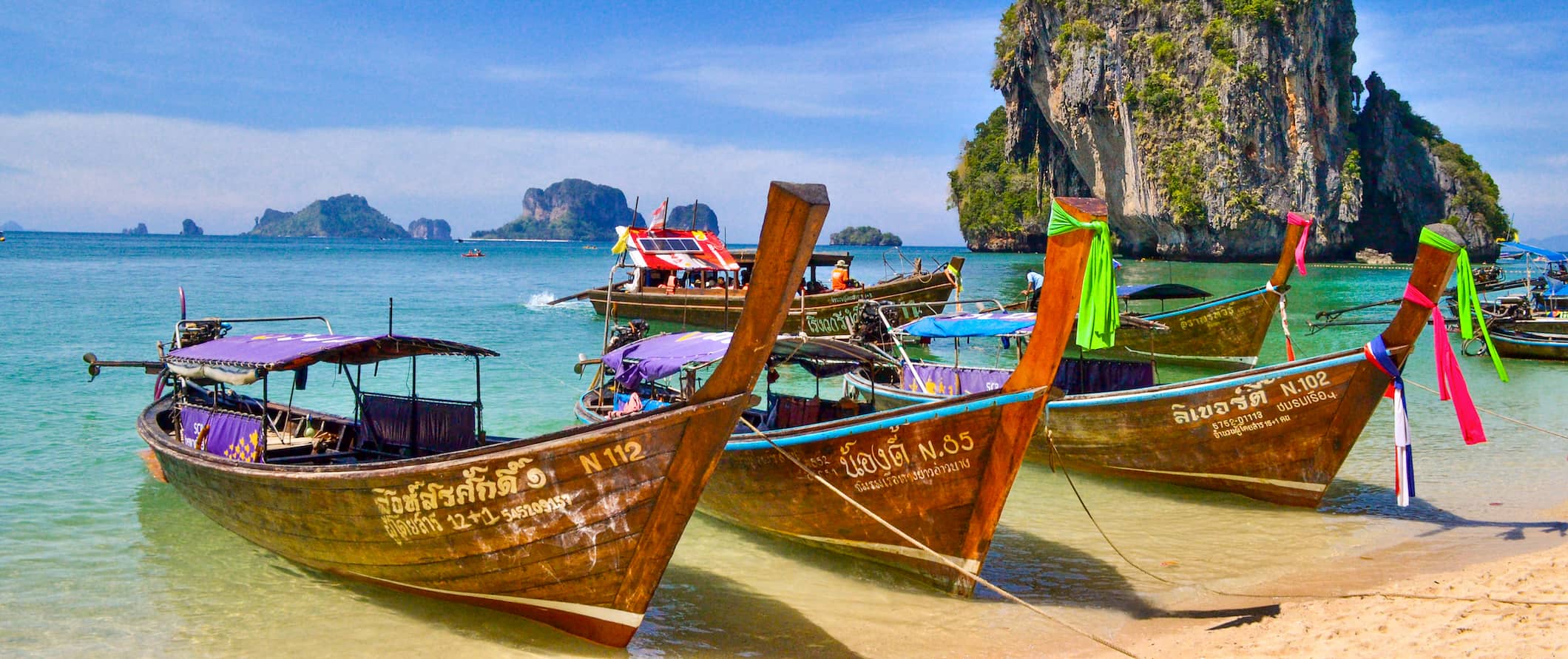
Accommodation – Accommodation in Southeast Asia is really cheap, making it the perfect place to travel if you are on a budget. Hostels are plentiful, as are budget guesthouses and hotels. It’s also very cheap to splash out here if you’re in need of some luxury.
Generally, you can find hostel dorm rooms for as little as $6-8 USD in Cambodia and $3-6 USD in Laos. In Thailand, 4-6-bed dorm rooms are $8-12 USD, while in Vietnam you can expect to pay $5-7 USD. In Indonesia, prices range between $5-10 USD for a 4-6-bed dorm room. Expect to pay at least $15-20 per night for a private room with air conditioning. Free Wi-Fi is standard in most hostels, free breakfast is common, and many hostels even have pools. In more remote areas, hot water isn’t common so make sure to check in advance if that’s an issue for you.
Simple guesthouses or bungalows throughout Southeast Asia generally cost $12-20 USD per night for a basic room with a fan (sometimes air conditioning) and hot water. If you want something nicer that includes a more comfortable bed and a TV, expect to pay $25-35 USD per night.
For backpackers, budgeting around $10 USD per night for accommodation is pretty safe no matter where you go in Southeast Asia. If you’re looking for a higher-end hotel room with more amenities, expect to pay $20-50 USD per night for a room. Anything over that is luxury territory.
Camping is available in certain areas, usually for just a few dollars per night for a basic tent plot without electricity. However, this is about the same price as hostels so it’s not really any cheaper.
Food – While each country’s cuisine varies, overall, Southeast Asian food is aromatic, spicy, and flavorful. Typical spices and herbs include garlic, basil, galangal, cilantro, lemongrass, kaffir lime leaves, chilies, and fish sauce. No matter what region you’re in, you can expect to find a variety of curries, salads, soups, noodle dishes, and stir-fries.
Rice and noodles are central to Southeast Asian food, while the meat is usually pork, chicken, fish, or seafood, which is everywhere on the islands and coastal areas.
While traveling Southeast Asia, street food is the most popular food and cheapest option. On average, these meals cost $1-5 USD. You find these stalls throughout this region lining most streets and every market. They are ubiquitous in the region. In Singapore, street food (from “hawker stands” as they’re known there) costs around $4-5 USD for a meal. Even if you go into small local restaurants, the price doesn’t increase that much.
Food that costs $2 USD at a street stall generally only costs $4-6 USD at a local restaurant. If you went into a restaurant in Thailand, you’d pay around $3-4 USD for a pad Thai that would have cost $1-2 USD on the street.
In Cambodia, street food is around $1-2 USD, while restaurants charge around $3-5 USD for a dish like amok (a coconut milk dish) or luc lac (pepper gravy beef).
Western meals, including burgers, pizza, and sandwiches usually cost around $7-10 USD. But these generally aren’t that great. If you want something that actually tastes as it does back home, expect to spend at least $10-12 USD for your meal.
While cheap, alcohol can take a bite out of your budget if you’re not careful. Those $1-2 USD beers add up! Wine and cocktails are more expensive, generally around $3-5 USD. A cappuccino is typically around $2 USD. Bottled water is plentiful and costs less than $1 USD.
There’s a growing cutting-edge foodie scene in the region and, if you want to splurge, you can do so on some really good meals. Big cities like Bangkok, KL, and Singapore, all have world-class Michelin star restaurants as well some incredible fusion restaurants.
Since dining out is so cheap in the region, there’s no point in grocery shopping unless you’re looking to get some pre-made salads or fruits. Additionally, a general lack of kitchens in most hostels and hotels makes it difficult to cook even if you wanted to. If you do purchase your own groceries, expect to spend around $25 USD per week for basic groceries like local produce, rice, and some meat (while avoiding expensive imported items like cheese and wine).
Backpacking Southeast Asia Suggested Budgets
On a backpacker budget of $45 USD per day, you can stay in hostel dorms, eat out at local markets and street stalls, limit your drinking, do mostly free activities, minimize paid activities, and use public transportation to get around. You’re not going to be able to splash out but you’ll be able to live the typical backpacker experience without really stressing over expenses.
On a mid-range budget of $85 USD per day, you can stay in budget hotels or private hostel rooms, eat more restaurant meals, do more paid activities like cooking classes, take some taxis, and enjoy a few more drinks. You won’t live large, but you won’t be missing out either.
On an upscale budget of $150 USD or more per day, you can stay in nicer hotels with more amenities, eat out as much as you want, do more paid tours including private tours, hire a driver, fly between destinations, and basically do whatever you want. The sky is the limit with this kind of budget!
You can use the chart below to get some idea of how much you need to budget daily, depending on your travel style. Keep in mind these are daily averages — some days you’ll spend more, some days you’ll spend less (you might spend less every day). We just want to give you a general idea of how to make your budget. Prices are in USD.
Southeast Asia Travel Guide: Money-Saving Tips
Backpacking Southeast Asia is cheap. There’s little opportunity to spend a lot of money since everything is already so inexpensive unless you intentionally are trying to splash out on fancy meals and high end hotels. The two reasons why most travelers end up overspending is that they eat a lot of Western food and drink way too much. If you want to save money while traveling in this part of the world, cut down on your drinking and skip the Western food. While country guides have more specific ways to save money, here are some general ways to save money in Southeast Asia:
- Stay with a local – Accommodation is cheap in Southeast Asia but nothing’s cheaper than free! Use Couchsurfing to stay with locals who have extra beds and couches for free. You’ll also meet great people who can show you around and share their insider tips and advice.
- Book tours and day trips as a group – You have more negotiation power when you’re with a group of people buying multiple spots or tickets. Traveling alone? Meet a friend at a hostel and see if they want to join the same tour as you. I’ve met some great friends over the years doing this and highly recommend it.
- Don’t book in advance – Don’t book any tours or activities before you get to your destination. They’ll be much cheaper when you arrive as you’ll be able to negotiate a lower price as you’ll find companies are often offering the same tour and competing. Anything you see online is more expensive than you need to pay!
- Eat on the street – The street food is the best food. The food is the best and cheapest you’ll find. It’s a great way to try new foods and get to chat with locals as well. This is where locals eat so if you want insight into local culture, good food, and savings, eat the street food. Look for where locals are eating to ensure that it’s safe to eat.
- Bargain hard – Nothing is ever at face value here. Bargain with sellers as most of the time, the price they’ve quoted is way higher. There’s a haggling culture in the region so play the game and save some money. It’s important not to convert it in your head to your own currency because it will usually sound cheap even though you might still be getting ripped off. You’ll never get the local price, but you might come close!
- Minimize your drinking – Drinks really add up. Even with cheap drinks, if you’re not aware, you’ll end up spending more money on beer than on food and accommodation. If you want to drink, head to the supermarkets, drink at the hostel, or check out the local happy hours.
- Pack a water bottle – A water bottle with a purifier comes particularly in handy in Southeast Asia since you can’t usually drink the tap water. Save money and thousands of plastic bottles and get a bottle that can purify the tap water for you. My preferred bottle is LifeStraw as it has a built-in filter that ensures your water is always safe and clean.
Where to Stay in Southeast Asia
I’ve been traveling Southeast Asia since 2005 and have stayed in hundreds of places. Here are some of my favorite places to stay in Southeast Asia:
- The Siem Reap Pub Hostel (Siem Reap)
- Onederz Siem Reap (Siem Reap)
- Mad Monkey Siem Reap (Siem Reap)
- Onederz Sihanoukville (Sihanoukville)
- Monkey Republic (Sihanoukville)
- Onederz Phnom Penh (Phnom Penh)
- Sla Boutique Hostel (Phnom Penh)
- The Magic Sponge (Kampot)
- Indigo House Hotel (Luang Prabang)
- Sa Sa Lao (Luang Prabang)
- Sanga Hostel (Pakse)
- Nana Backpackers Hostel (Vang Vieng)
- Dream Home Hostel (Vientiane)
- Traveller Bunker Hostel (Cameron Highlands)
- De’Native Guest House (Cameron Highlands)
- Kitez Hotel & Bunks (Kuala Lumpur)
- Sunshine Bedz Kuala Lumpur (Kuala Lumpur)
- Ryokan Muntri Boutique Hostel (Penang)
- Mad Monkey Hostel (Bangkok)
- D&D Inn (Bangkok)
- Kodchasri B&B (Chiang Mai)
- The Royal Guest House (Chiang Mai)
- Green Leaf (Khao Yai)
- Lonely Beach Resort (Ko Chang)
- The Sanctuary (Koh Phangan)
- Na-Tub Hostel (Koh Phangan)
- Pineapple Guesthouse (Phuket)
- Dream Lodge
- The Pod Capsule Hostel
- The Scarlet
- Under the Coconut Tree Guesthouse (Hoi An)
- Fuse Beachside (Hoi An)
- Pretty Backpackers House (Da Lat)
- Hanoi Old Quarter Hostel (Hanoi)
- Luxury Backpackers Hostel (Hanoi)
- The Hideout (HCMC)
- City Backpackers Hostel (HCMC)
How to Get Around Southeast Asia
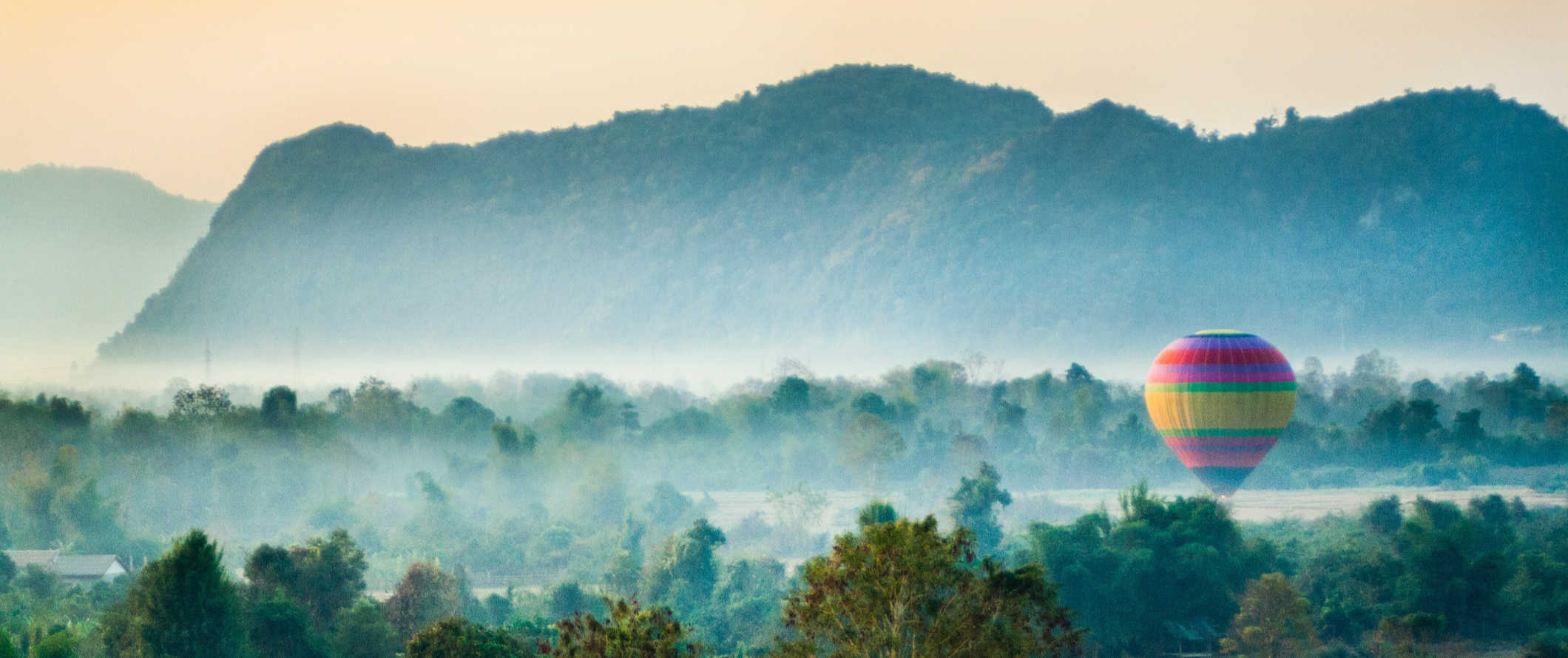
Public transportation – Public transportation costs from a few pennies to a few dollars, with Singapore and Malaysia offering the most comprehensive public transportation systems. In Thailand, local buses cost around $0.25 USD per trip, while the Metro and Skytrain in Bangkok cost $0.50-1.50 USD per trip. In Cambodia, a bus ticket in Phnom Penh costs just $0.40 USD per ride.
Major cities generally have subway systems but mostly you’ll be using the bus or shared taxis to get around.
Tuk-tuks (small, shared taxis with no meter) are available around much of the region and require a bit of haggling. They usually have 3-6 seats and generally cost more than public transportation but are faster. To find a reputable driver, ask your accommodation as they usually know someone. Tuk-tuk drivers can often be hired for the day for a discounted rate (this is what a lot of people do to visit the Killing Fields and Angkor Wat in Cambodia, for example).
Taxi – Taxis in the region are generally safe, though it’s not uncommon to have to haggle. Scams to rip you off aren’t uncommon either, so always ask your accommodation to call you a taxi whenever possible so you know you’ll get a reputable company.
In Singapore and Indonesia, taxi drivers do put on the meter. In Bangkok, you can get taxi drivers to use the meter, but if you’re hailing one in a tourist area, he might try to avoid using it. In Vietnam, the meter is sometimes rigged, but if you can get a reputable company like Mai Linh, you won’t have any problems.
Ridesharing – Grab, DiDi, and Gojek are Asia’s answer to Uber. They work the same way: you hire a driver to take you somewhere via the app, and you can pay via the app or in cash. It’s often more affordable than a regular taxi, though drivers are a bit unreliable as the practice is not as widespread here as in other parts of the world.
Just keep in mind that some drivers are driving motorcycles so be sure to double check what kind of vehicle is picking you up if you don’t want to ride on the back of one.
Bus – The easiest and cheapest way to travel around Southeast Asia is by bus. The backpacker trail is so worn that there is a very well-established tourist bus system to take you anywhere. Buses costs vary between $5-25 USD for a 5-6 hour journey. Overnight buses cost $20-35 USD depending on distance (they often have reclining seats so you can get a decent sleep).
You can check ticket prices and book tickets for all the different bus companies across Southeast Asia at 12go.asia.
Train – Train service is limited in the region and not something to really consider when you travel Southeast Asia. You can take a train up and down the coast of Vietnam and there’s some limited scenic rails in Malaysia. Thailand is the only country that has an extensive train system that lets you travel all its regions (and onward to Singapore) from Bangkok.
The train prices in Southeast Asia are determined by distance and class. Night trains with sleeper cars are more expensive than day trains. The night train to Chiang Mai from Bangkok takes twelve hours and costs $27 USD for a sleeper seat. However, that same train during the day is $8-9 USD. In Vietnam, trains run up and down the coast and cost $60 USD from Hanoi to Ho Chi Minh City.
Flying – The cost of flying around Southeast Asia has come down in recent years due to the rise of low-cost airlines. Scoot, Jetstar, and AirAsia are the biggest. Nok Air has a lot of flights within Thailand , and VietJet Air is popular in Vietnam . Lion Air serves Indonesia , but its safety record is really spotty and I personally would not fly them. If you book early, you can save on fares, as most of the airlines offer deeply discounted fare sales all the time, especially Air Asia.
Just make sure that the airport these budget airlines fly into isn’t too far out of your way (transportation from the secondary airport sometimes negates the savings from using the budget airline itself).
Also, keep in mind that you usually must pay to check your baggage on these cheap flights. If you wait to pay for your luggage at the gate, you end up paying almost double. Travel carry-on only to avoid this added cost.
All in all, I only recommend flying if you are pressed for time or find a super cheap deal. Otherwise, stick to the bus.
Hitchhiking – Hitchhiking in Southeast Asia is safe, though popularity of the practice varies by country (it’s more common in Malaysia, but not so much in Cambodia). Dress respectably, smile while making eye contact with drivers, and use a cardboard sign to tell people where you’re headed. Be prepared for long bouts of no pick-ups, especially if you’re traveling through more rural areas. Pack plenty of water and food. Also, make sure the people picking you up understand you’re hitchhiking and not flagging down a taxi.
Hitchwiki is a great resource for hitchhiking tips.
Car rental I don’t recommend renting a car in Southeast Asia. Rental cars are expensive ($40 USD per day or more) and the roads here are in poor shape. I would never drive around the region.
When to Go to Southeast Asia
The best time of year to visit Southeast Asia is from November to April when temperatures are milder (though temperatures vary drastically by region). It may be mild in Thailand in January and hot in Malaysia but in Northern Vietnam, it’s cold! Also, one of the biggest mistakes people make is not taking into account the rainy season. In some cases it won’t make a big difference but definitely does if it’s a beach trip.
In Indonesia, the best time to visit is April to October. Temperatures average 24-30ºC (75-86ºF), and the weather is mostly dry. July to September is the peak holiday season and when you can expect to pay the highest rates. December to February is the rainy season.
In Malaysia, January-March and June-September are the best time to visit, as these months have the lowest average rainfall. It is still hot and humid during this time though. The rainy season is from October to December. Singapore’s climate/weather is much like Malaysia’s.
In Vietnam, the weather varies by region. In Central Vietnam (including Hoi An and Nha Trang), January-May is the best time to visit because it is dry and the temperatures average 21-30°C (70-86°F). June to August is also a decent time to visit. If you want to stick around Hanoi, March to April is great, or October to December (for mildest temperatures). The rainy season is May-September.
Thailand has three seasons: hot, hotter, and hottest. It’s always warm, though the weather is nicest between November and February (which is also peak tourist season). Bangkok is “coolest” and driest during this time (but still averaging a hot 29°C/85°F each day). April and May are the hottest months, and the rainy season is June-October. The gulf islands get pretty rainy from August to December.
The dry season in Cambodia is from November-May and the cool season is from November-February (and when most people visit). Temperatures during this time are still high, but humidity is lower. Laos has the same cool season as Cambodia, with the dry season running from November-April.
In the Philippines, it’s mostly warm all year long with an average daily high of 26°C (80°F). There are rainy and dry seasons and temperatures are hot and dry from March-May and cooler December-February. The best time to visit is between January-April when it’s less humid. Monsoon Season is July-October.
For more information on when to go to places, visit the specific country guides.
How to Stay Safe in Southeast Asia
Southeast Asia is an incredibly safe place to backpack and travel — even if you’re traveling solo and even as a solo female traveler. Violent crime is super, duper rare. Petty theft (including bag snatching) is the most common type of crime in Southeast Asia, especially around popular tourist landmarks. Always keep your valuables out of reach on public transportation and in crowds just to be safe. Never leave your valuables unattended while at the beach and always keep a hold of your purse/bag when out and about as bag snatching is common.
That said, outside touristy areas, theft is really rare. Heck, it’s pretty rare in touristy areas too! But a little vigilance goes a long way and it’s better to be safe than sorry.
There are some common scams around that you’ll want to be aware of, such as the motorbike scam. This involves a bike rental company trying to charge you for damage to the bike that you didn’t cause. To avoid this, always take photos of your rental before you leave so you can protect yourself from baseless claims.
Another common scam involves a tuk-tuk driver taking you somewhere you didn’t want to go in hopes you’ll buy something from the shop/restaurant he dropped you off at (he gets a commission if you do). Simply refuse to buy anything and demand to go back to where you were — or find another driver.
For other common travel scams, read this post about major travel scams to avoid in the region .
Solo female travelers should feel safe here, though it’s generally a good idea to avoid walking around alone at night just to be safe. It’s always a good idea to carry some extra cash to get home in a taxi if you need to. Additionally, always keep an eye on your drink at the bar and never accept drinks from strangers. Be sensible when it comes to dating while traveling and meeting people in public places. As I’m not a woman, please check out some solo female travel blogs to get the best insight.
Overall, the people who get in trouble here tend to be involved with drugs or sex tourism. Avoid those two things and you should be fine. Keep in mind that it’s not always obvious how old someone is or if they’re a sex worker so be mindful when getting involved in romantic interactions. Also, penalties for drug use in this region are stiff so even if you’re here to party, skip the drugs.
Always trust your gut instinct. Make copies of your personal documents, including your passport and ID. Forward your itinerary along to loved ones so they’ll know where you are.
For more in-depth coverage of how to stay safe in Southeast Asia, check out this post that answers some frequently asked questions and concerns.
The most important piece of advice I can offer is to purchase good travel insurance. Travel insurance will protect you against illness, injury, theft, and cancellations. It’s comprehensive protection in case anything goes wrong. I never go on a trip without it as I’ve had to use it many times in the past. You can use the widget below to find the policy right for you:
Southeast Asia Travel Guide: The Best Booking Resources
These are my favorite companies to use when I travel. They consistently have the best deals, offer world-class customer service and great value, and overall, are better than their competitors. They are the companies I use the most and are always the starting point in my search for travel deals.
- Skyscanner – Skyscanner is my favorite flight search engine. They search small websites and budget airlines that larger search sites tend to miss. They are hands down the number one place to start.
- Hostelworld – This is the best hostel accommodation site out there with the largest inventory, best search interface, and widest availability.
- Agoda – Other than Hostelworld, Agoda is the best hotel accommodation site for Asia.
- Booking.com – The best all around booking site that constantly provides the cheapest and lowest rates. They have the widest selection of budget accommodation. In all my tests, they’ve always had the cheapest rates out of all the booking websites.
- Get Your Guide – Get Your Guide is a huge online marketplace for tours and excursions. They have tons of tour options available in cities all around the world, including everything from cooking classes, walking tours, street art lessons, and more!
- SafetyWing – Safety Wing offers convenient and affordable plans tailored to digital nomads and long-term travelers. They have cheap monthly plans, great customer service, and an easy-to-use claims process that makes it perfect for those on the road.
- LifeStraw – My go-to company for reusable water bottles with built-in filters so you can ensure your drinking water is always clean and safe.
- Unbound Merino – They make lightweight, durable, easy-to-clean travel clothing.
Get the In-Depth Budget Guide to Thailand!

My detailed 350+ page guidebook is made for budget travelers like you! It cuts out the fluff found in other guidebooks and gets straight to the practical information you need to travel around Thailand. You’ll find suggested itineraries, budgets, ways to save money, on and off-the-beaten-path things to see and do, non-touristy restaurants, markets, bars, safety tips, and much more! Click here to learn more and get your copy today.
Southeast Asia Travel Guide: Related Articles
Want more info? Check out all the articles I’ve written on Southeast Asia travel and continue planning your trip:

The 4 Best Hostels in Singapore
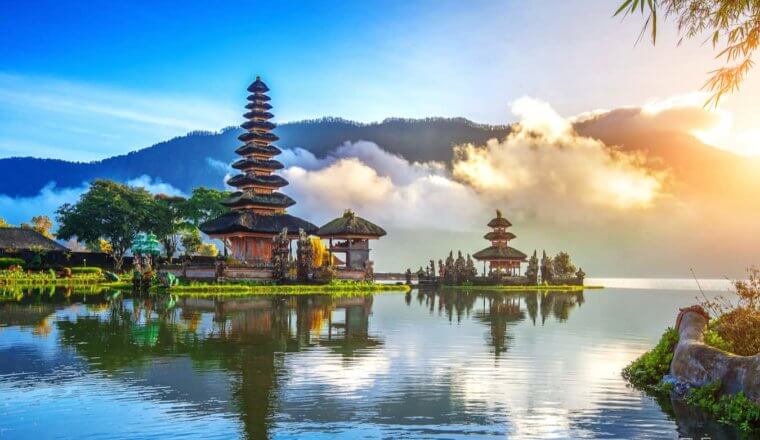
The 6 Best Hostels in Bali
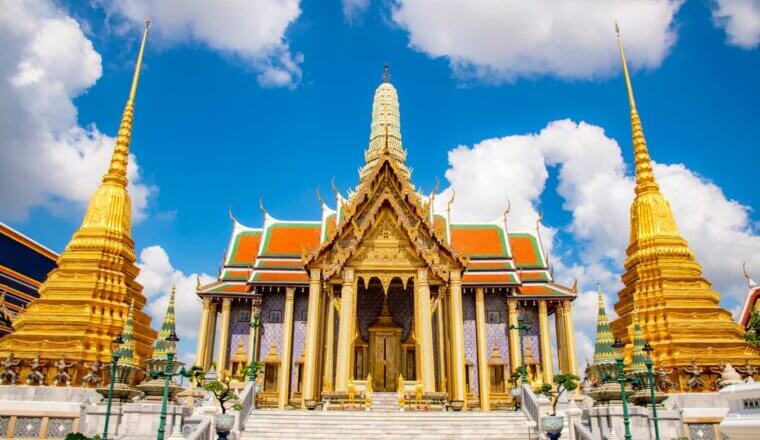
The 22 Best Things to Do in Bangkok
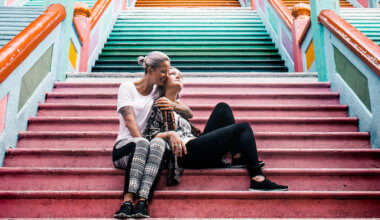
5 LGBTQ Travel Tips for Asia

Is Southeast Asia Safe for Travelers?
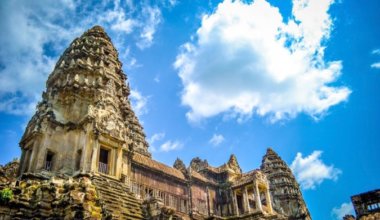
Backpacking Cambodia: 3 Suggested Itineraries for Your Trip
Get my best stuff sent straight to you, pin it on pinterest.
- Where To Stay
- Transportation
- Booking Resources
- Related Blogs
New International Travel Regulations to Enter Indonesia as of 10 November 2022
JAKARTA, 21 December 2022 - As an immediate response to recover tourism industry and relaxing the international travel restrictions, COVID-19 Task Force issued the Circular Letter of the COVID-19 Task Force Number 25 of 2022 concerning Health Protocols for International Travels during the COVID-19 Pandemic .
Coordinator of Expert Team and Spokesperson for the COVID-19 Handling Task Force, Prof. Wiku Adisasmito, stated that the adjustment to the control mechanism for international travel was urgently needed. "The COVID-19 policy must also be adaptive with the dynamics of the virus, including the dynamics of its variants that occur globally," Wiku said.
- International Travel
Here are the new international travel regulations according to the Circular Letter of the COVID-19 Task Force Number 25 of 2022 concerning Health Protocols for International Travels during the COVID-19 Pandemic
- The general requirements regarding health protocols for international travelers are as follows:
- Wearing 3 ply of fabric mask or medical grade mask, covering nose, mouth, and chin at indoor settings or any crowded situations;
- Replacing the mask regularly within every 4 hours, and dispose the waste in the proper place;
- Washing hands regularly with water and soap or hand sanitizers;
- Maintaining social distance for a minimum of 1.5 meters and avoiding crowds; and
- Keeping in mind that it is advised not to have one-way or two-way communication by telephone or in person throughout the trip using public transportation modes of land, rail, sea, river, lake, ferry, and air.
- All International travelers, both Indonesian citizens and foreign nationals, can enter Indonesia through the entry points assigned, which are:
a. Airports
- Soekarno Hatta International Airport, Banten;
- Juanda International Airport, East Java;
- Ngurah Rai International Airport, Bali;
- Hang Nadim International Airport, Riau Islands;
- Sam Ratulangi International Airport, North Sulawesi;
- Zainuddin Abdul Madjid International Airport, West Nusa Tenggara;
- Kualanamu International Airport, North Sumatra;
- Sultan Hasanuddin International Airport, South Sulawesi;
- Yogyakarta International Airport, Yogyakarta;
- Sultan Syarif Kasim II, Riau.
- Sultan Iskandar Muda, Aceh;
- Minangkabau, West Sumatra;
- Sultan Aji Muhammad Sulaiman, East Kalimantan;
- Kertajati International Airport, West Java; and
- Sentani International Airport, Papua
b. Seaports
All international seaports in Indonesia are now opened as entry points for international travel through the consideration of the Directorate General of Sea Transportation of the Ministry of Transportation.
c. Cross Border State
- Aruk, West Kalimantan;
- Entikong, West Kalimantan;
- Motaain, East Nusa Tenggara;
- Nanga Badau, West Kalimantan;
- Motamasin, East Nusa Tenggara;
- Wini, East Nusa Tenggara;
- Skouw, Papua; and
- Sota, Papua.
3. International travelers can enter Indonesia through the following conditions:
- Indonesian citizens are allowed to enter Indonesia by following the strict health protocol as mentioned in number 1.
- Foreign nationals are allowed to enter Indonesia by fulfilling the requirements as follows:
- In accordance with the provisions on immigration regulated by the ministry that administers government affairs in the fields of Law and Human Rights;
- In accordance with the agreement scheme (bilateral), such as the Travel Corridor Arrangement (TCA); and/or
- Granted special consideration/permission in writing from the Ministry/Agency.
4. Requirements for Departure Documents for international travelers from Indonesia are as follows:
- International travelers with the status of Indonesian citizens aged 18 years and above who will travel abroad from Indonesia are required to show a card/certificate (physical or digital) of receiving the third dose of COVID-19 vaccine (booster) which is shown through the PeduliLindungi app.
- The provisions on the obligation to show the card/certificate as referred to in letter a are excluded for Indonesian citizens with the following provisions:
- International travelers with the status of Indonesian citizens with special health conditions or comorbid diseases that cause them to not receive the vaccine are required to attach a doctor's certificate from the Government Hospital stating that the person concerned has not and/or cannot receive the Covid-19 vaccine; or
- International travelers with the status of Indonesian citizens who have finished carrying out COVID-19 isolation/treatment and have been declared inactive in transmitting COVID-19 but have not been able to get the third dose of vaccination (booster) must show a doctor's certificate from the Government Hospital or Ministry of Health stating that the person concerned is no longer active. actively transmit COVID-19 or COVID-19 recovery certificate.
5. Requirements for Arrival Documents for international travelers going to Indonesia are as follows:
- International travelers must download and use PeduliLindungi app before departure;
- Presenting the card/certificate (physical or digital) of receiving the second dose of COVID-19 vaccine at least 14 (fourteen) days before departure written in English, other than the language of the country of origin.
- The obligation to show proof (physical and digital) of COVID-19 vaccination certificates as requirements for entering Indonesia are excluded to:
- Foreign nationals under 18 years old; and
- International travelers with special health conditions or comorbid diseases that cause travelers cannot receive vaccines, with the requirements of presenting a doctor's certificate from the State Departure Hospital which states that the concerned person has not been and/or cannot receive COVID-19 vaccination.
- International travelers who have not received a complete dose of vaccination, have finished carrying out COVID-19 isolation or treatment, and have been declared inactive in transmitting COVID-19 with the requirement that they attach a doctor's certificate from the Government Hospital of the departure country or the ministry that carries out government affairs in the health sector on the country of departure stating that the person concerned is no longer actively transmitting COVID-19 or the COVID-19 recovery certificate;
- International travelers with the status of foreign nationals who are Diplomatic visa holders and work visas related to official visit/state officials at the ministerial level or above and foreign nationals who entered Indonesia with the Travel Corridor Arrangement scheme, according to the principle of reciprocity while implementing a strict health protocol; and
- International travelers with the status of foreign nationals who have not received the vaccine and intend to travel domestically in order to continue their journey with international flights out of Indonesian territory, are allowed not to show their COVID-19 vaccination card/certificate as long as they do not leave the airport area during transit waiting for international flights to be followed, with requirements:
- Has been permitted by the local Port Health Office to travel domestically in order to continue the journey with international flights out of the territory of Indonesia; and
- Showing the schedule of flight tickets outside Indonesia for direct transit from the departure city to the international airport in the territory of Indonesia with the final destination to the destination country.
6. COVID-19 Entry Points Health Protocols are listed as follows:
- International travelers must proceed through international travel arrival documents checking as being mentioned in no. 4.
- Upon arrival at the entry points, international travelers must undergo a COVID-19 symptom check, including a body temperature check.
- International travelers with a symptom of COVID-19 or body temperature above 37.5 degrees Celsius must undergo RT-PCR examination upon arrival with payment borne by the government for Indonesian citizen and by self-financing for foreign nationals
- International travelers without a symptom of COVID-19 and body temperature below 37.5 degrees Celsius are not required to undergo RT-PCR examination upon arrival and can continue their travel while also conducting 14 days of self health monitoring.
- International travelers conducting the RT-PCR confirmation examination as referred to in point c are allowed to continue the journey after conducting the RT-PCR confirmation examination sample and must comply with the following provisions:
- Waiting for the results of the RT-PCR confirmation examination in hotel rooms, lodging rooms, or residences; and
- Are not allowed to leave hotel rooms, lodging rooms, or residences and are not allowed to interact with other people before the results of the RT-PCR confirmation examination show negative results.
- In the event that the RT-PCR confirmation examination as referred to in point c shows a positive result, the international traveler shall be isolated/treated in accordance with the follow-up mechanism for the positive case.
- In the event that the RT-PCR confirmation examination as referred to in point c shows a negative result, the international traveler is allowed to continue the journey and it is recommended to carry out independent health monitoring of COVID-19 symptoms for 14 days by implementing strict health protocols.
7. Positive Case Follow-up Mechanism and Isolation/Treatment are as follows:
- International travelers with positive RT-PCR confirmation examination results without symptoms or experiencing mild symptoms are required to carry out isolation/treatment in isolation hotels or centralized isolation facilities set by the government or self-isolate in their own residences with isolation/treatment times as recommended by the Ministry of Health.
- International travelers with positive RT-PCR confirmation examination results accompanied by moderate or severe symptoms and/or with uncontrolled comorbidities, will be isolated/treated at a Covid-19 referral hospital with isolation/treatment time according to recommendations from doctors and recommendations from the Ministry of Health.
8. COVID-19 Vaccination Program for International Travelers are as follows:
- International travelers with the status of Indonesian citizens who have not received the COVID-19 vaccination, either the first dose, the second dose, or the third dose are required to undergo vaccination at the entry point for overseas travel after a symptom check is carried out.
- International travelers with the status of foreign nationals who are already in Indonesia and will travel, both domestically and internationally, are required to undergo vaccination through a program or mutual cooperation scheme in accordance with the provisions of the legislation.
9. Financing of all the provisions mentioned above are regulated as follows:
- The cost of RT-PCR confirmation examination at the entry point as referred to in number 5.c. for foreign nationals it is borne independently, while for Indonesian citizens it is borne by the government.
- The cost of handling COVID-19 and medical evacuation for foreign nationals is borne independently, while for Indonesian citizens it is borne by the government.
- The cost of vaccination at the entry point for international travelers with the status of Indonesian citizens as referred to in letter 7.a is borne by the government.
- In the event that the international travelers with the status of foreign nationals are unable to finance the RT-PCR confirmation examination at the entry point and isolation/treatment when the results of the RT-PCR confirmation examination show positive results, as referred to in point a and b, then the Sponsor, Ministry/Institution/State-Owned Enterprises providing the consideration of the entry permit for the foreigner can be asked for the accountability in question.
10. Other provisions are as follows:
- In regards to the results of the RT-PCR test at the entry point, a written comparison can be requested by filling out the form provided by the Port Health Office or the Ministry of Health at the expense of the inspection being borne by the international travelers.
- The implementation of the RT-PCR comparison test as referred to in point a is carried out simultaneously by the Port Health Office in 2 (two) laboratories for the purpose of SGTF comparison examination and comparative examination of RT-PCR results, namely at: Health Research and Development Agency (Balitbangkes), Cipto Mangunkusumo Central General Hospital (RSCM), 9 Gatot Soebroto Army Central Hospital (RSPAD), Bhayangkara Raden Said Sukanto Hospital (Polri Hospital) or other government laboratories (Environmental Health Engineering Center, Regional Health Laboratory, or other government reference laboratories).
- The Port Health Office of airports and international seaports facilitates international travelers requiring emergency medical services upon arrival in Indonesia in accordance with the provisions of laws and regulations.
- Every transportation mode operator at the entry point for overseas travel is required to use the PeduliLindungi app.
- Ministries/institutions/regional apparatus that carry out functions related to the international travelers must follow up this Circular Letter by issuing legal instruments that are in harmony and do not conflict with the provisions of laws and regulations.
- The legal instrument as referred to in point e is an inseparable part of this Circular Letter.
This regulation is effective from 1 September 2022 until a later date is determined. You can check the complete detail regarding this regulation on this link.
Visa Exemption Arrangement Facility and Visa on Arrival for Indonesia
- Visa Exemption Arrangement facility and Visa on Arrival for Indonesia
Furthermore, based on the Circular Letter of the Directorate General of Immigration No. IMI-0708.GR.01.01 of 2022 concerning the Ease of Immigration to Support Sustainable Tourism during the COVID-19 Pandemic effective from 23 September 2022, the Indonesian government has decided to exercise the Visa Exemption Arrangement facility and updated the list of countries eligible for Visa On Arrival (VOA) for tourism purposes.
The list of countries and special entities for Visit Visa Exemption Arrangement facility , in alphabetical order are:
- Brunei Darussalam,
- Philippines,
- Thailand, and
Visit Visa Exemption for Tourism Purpose are granted for foreign nationals at the Immigration Checkpoints as follows :
a. Airports:
1) Hang Nadim, Riau Islands; 2) Juanda, East Java; 3) Kertajati, West Java; 4) Kualanamu, North Sumatra; 5) Minangkabau, West Sumatra; 6) Ngurah Rai, Bali; 7) Sam Ratulangi, North Sulawesi; 8) Sentani, Jayapura; 9) Soekarno Hatta, Banten; 10) Sultan Aji Muhammad Sulaiman, East Kalimantan; 11) Sultan Hasanuddin, South Sulawesi; 12) Sultan Iskandar Muda, Aceh; 13) Sultan Syarif Kasim II, Riau; 14) Yogyakarta, DI Yogyakarta; 15) Zainuddin Abdul Majid, West Nusa Tenggara.
b. Seaports:
1) Achmad Yani, North Maluku; 2) Amamapare, Papua; 3) Anggrek, Gorontalo; 4) Bagan Siapi-Api, Riau; 5) Bandar Bentan Telani Lagoi, Riau Islands; 6) Bandar Seri Udana Lobam, Riau Islands; 7) Bandar Sri Setia Raja, Riau; 8) Batam Centre, Riau Islands; 9) Batu Ampar, Riau Islands; 10) Belakang Padang, Riau Islands; 11) Belawan, North Sumatra; 12) Benete, West Nusa Tenggara; 13) Benoa, Bali; 14) Biak, Papua; 15) Boom Baru, South Sumatra; 16) Celukan Bawang, Bali; 17) Cirebon, West Java; 18) Citra Tri Tunas, Riau Islands; 19) Ciwandan, Banten; 20) Dumai, Riau; 21) Dwi Kora, West Kalimantan; 22) Gunung Sitoli, North Sumatera; 23) Jambi, Jambi; 24) Jayapura, Papua; 26) Kabil, Riau Islands; 27) Kendari, Southeast Sulawesi; 28) Kota Baru, South Kalimantan; 29) Kuala Enok, Riau; 30) Kuala Langsa, Aceh; 31) Kuala Tanjung, North Sumatra; 32) Kumai, Central Kalimantan; 33) Labuan Bajo, East Nusa Tenggara; 34) Lauren Say, East Nusa Tenggara; 35) Lemar, West Nusa Tenggara; 36) Lhokseumawe, Aceh; 37) Malahayati, Aceh; 38) Manado, North Sulawesi Utara; 40) Marina Ancol, DKI Jakarta; 41) Marina Teluk Senimba, Riau Islands; 42) Merauke, Papua; 43) Muara Sabak, Jambi; 44) Nongsa Terminal Bahari, Riau Islands; 45) Nusantara, North Sulawesi; 46) Nusantara Nusantara Pare Pare, South Sulawesi; 47) Padang Bai, Bali; 48) Panarukan, East Java; 49) Pangkal Balam, Bangka Belitung; 50) Panjang, Lampung; 51) Pantoloan, Central Sulawesi; 52) Pasuruan, East Java; 53) Patimban, West Java; 54) Probolinggo, East Java; 55) Pulau Baai, Bengkulu; 56) Sabang, Aceh; 57) Samarinda, East Kalimantan; 58) Sampit, Central Kalimantan; 59) Samudera, North Sulawesi; 60) Saumlaki, Maluku; 61) Sekupang, Riau Islands; 62) Selat Lampa, Riau Islands; 63) Semayang, East Kalimantan; 64) Siak Sri Indrapura, Riau; 65) Sibolga, North Sumatra; 66) Sintete, West Kalimantan; 67) Soekarno-Hatta, South Sulawesi; 68) Sorong, Papua; 69) Sri Bayintan, Riau Islands; 70) Sri Bintan Pura, Riau Islands; 71) Sunda Kelapa, DKI Jakarta; 72) Sungai Guntung, Riau; 73) Tanjung Balai Karimun, Riau Islands; 74) Tanjung Emas, Central Jawa; 75) Tanjung Gudang, Bangka Belitung; 76) Tanjung Harapan, Riau; 77) Tanjung Intan, Central Java; 78) Tanjung Kalian, Bangka Belitung; 79) Tanjung Pandan, Bangka Belitung; 80) Tanjung Perak, East Java; 81) Tanjung Priok, DKI Jakarta; 82) Tanjung Uban, Riau Islands; 83) Tanjung Wangi, East Java; 84) Tarempa, Riau Islands; 85) Teluk Bayur, West Sumatra; 86) Teluk Nibung, North Sumatra; 87) Tembilahan, Riau; 88) Tenau, East Nusa Tenggara; 89) Tri Sakti, South Kalimantan; 90) Tual, Maluku; 91) Yos Sudarso, Maluku;
c. Cross-Border Posts:
1) Aruk, West Kalimantan; 2) Entikong, West Kalimantan; 3) Marore, North Sulawesi; 4) Miangas, North Sulawesi; 5) Mota’ain, East Nusa Tenggara; 6) Motamasin, East Nusa Tenggara; 7) Nanga Badau, West Kalimantan; 8) Serasan, Riau Islands; 9) Skouw, Papua; 10) Sota, Papua; 11) Tunon Taka, North Kalimantan; 12) Wini, East Nusa Tenggara.
Effective from 23 September 2022, below are the list of countries and special entities for VOA for tourism, in alphabetical order:
- Bosnia Herzegovina
- Brunei Darussalam
- Czech Republic
- Liechtenstein
- Netherlands
- New Zealand
- Philippines
- Saudi Arabia
- South Africa
- South Korea
- Switzerland
- Timor Leste
- Türkiye
- United Arab Emirates
- United Kingdom
- United States of America
- Vatican City
VOA for Tourism Purpose are granted for foreign nationals at the Immigration Checkpoints as follows
Immigration Checkpoints on Airports
- Hang Nadim, Riau Islands;
- Juanda, East Java;
- Kualanamu, North Sumatra;
- Ngurah Rai, Bali;
- Raja Haji Fisabilillah, Riau Islands;
- Sam Ratulangi, North Sulawesi;
- Sentani, Papua
- Soekarno Hatta, DKI Jakarta;
- Sultan Hasanuddin, South Sulawesi;
- Sultan Syarif Kasim II, Riau;
- Yogyakarta in Special Region of Yogyakarta;
- Zainuddin Abdul Madjid in West Nusa Tenggara.
Immigration Checkpoints on Seaports
- Bandar Bentan Telani Lagoi, Riau Islands;
- Bandar Seri Udana Lobam, Riau Islands;
- Batam Centre, Riau Islands;
- Belawan, North Sumatra;
- Benoa, Bali;
- Biak, Papua;
- Citra Tri Tunas, Riau Islands;
- Dumai in Riau;
- Jayapura, Papua;
- Labuan Bajo, East Nusa Tenggara;
- Lembar, West Nusa Tenggara;
- Marina Teluk Senimba, Riau Islands;
- Malundung, North Kalimantan;
- Marina Ancol, Jakarta;
- Nongsa Terminal Bahari, Riau Islands;
- Nusantara Pare-Pare, South Sulawesi;
- Padang Bai, Bali;
- Sabang, Aceh;
- Samudera, North Sulawesi;
- Saumlaki, Maluku;
- Sekupang, Riau Islands;
- Sibolga, North Sumatra;
- Soekarno-Hatta, South Sulawesi;
- Sorong, Papua;
- Sri Bintan Pura, Riau Islands;
- Sunda Kelapa, DKI Jakarta;
- Tanjung Balai Karimun, Riau Islands;
- Tanjung Emas, Central Java;
- Tanjung Pandan, Bangka Belitung;
- Tanjung Perak, East Java;
- Tanjung Priok, Jakarta;
- Tarempa, Riau Islands;
- Teluk Bayur, North Jakarta;
- Tenau, East Nusa Tenggara;
- Tual, Maluku.
Immigration Checkpoints on Cross-Border Posts
- Mota’ain, East Nusa Tenggara;
- Sota, Papua;
- Tunon Taka, North Kalimantan;
- Wini, East Nusa Tenggara.
The regulations and details for Visit Visa Exemption for Tourism Purpose and Visa On Arrival for Tourism are listed as follows:
1. International travelers must present all requirements for the VOA at the immigration counter, namely:
i. Diplomatic Passport, ii. Service Passport, or iii. General Passport;
With validity period of at least 6 (six) months;
- A return ticket or a connecting ticket to continue traveling to another country;
- Proof of non-tax revenue payment in case of applying for a VOA for tourism purpose
2. Visa Exemption Arrangement for Tourism and VOA for tourism can be used by foreign nationals to carry out tourism activities or government duties in international activities of a state or government nature;
3. In the event that the foreign national as referred to in number 3 will carry out government duties in international activities of a state or government nature, in addition to meeting the requirements as referred to in number 2 must also attach an invitation letter to attend a conference/trial/meeting issued by the related Ministry/Agency of the Republic of Indonesia;
4. VOA for Tourism can also be granted to foreign nationals holding Diplomatic Passports or Service Passports who are not citizens of the State, Government of a Special Administrative Region of a State, and Certain Entities Subject to a VOA for Tourism in the event that there is no Representative of the Republic of Indonesia in the country/place of residence or emergency/urgent activities, by examining the following requirements:
- Diplomatic Passport or Service Passport with a validity period of at least 6 (six) months,
- A return ticket or a one-way ticket to continue the journey to another country;
- Request letter from the Ministry/Agency/Agency of the Republic of Indonesia;
- Letter of approval from the Director General of Immigration;
- Proof of non-tax revenue payment for VOA for tourism; and
- Invitation letter to attend conferences/trials/meetings issued by Ministries/Institutions/Agencies of the Republic of Indonesia, in terms of the intention of visiting foreigners for government duties in international activities of a state or government nature;
5. The approval letter from the Director General of Immigration as referred to in number 4 letter d is submitted by the chairs of the Ministry/Institution/Agency of the Republic of Indonesia to the Director General of Immigration u.p. Director of Immigration Traffic by attaching:
- A request letter from the Ministry/Agency/Agency of the Republic of Indonesia containing data on foreign nationals and the reasons for the submission,
- Diplomatic Passport or Service Passport with a validity period of at least 6 (six) months, and
6. Foreign nationals holding Visa Exemption Arrangement for Tourism and VOA for tourism cannot apply for a New Stay Permit through a Visa application;
7. Foreign nationals holding Visa Exemption Arrangement for Tourism and VOA for tourism can leave the territory of Indonesia through all Immigration Checkpoints;
8. The applicable rate for a VOA for tourism is the rate for a Visa on Arrival as referred to in the Attachment to Government Regulation Number 28 of 2019 which is IDR 500,000,-;
9. Perform data reconciliation between non-tax revenue payments, use of Visit Visa stickers on VOA for tourism with immigration crossings on a daily, weekly, and monthly basis;
Passport holders outside the above listed categories in point 2, can also enter Indonesia through entry points mentioned in point 1 by applying for e-visa prior to departure.
If you are already in Indonesia and planning to depart on a domestic trip, we suggest you find an updated regulation regarding domestic travel by clicking the link here .
Second Home Visa
Foreigners can stay for 5 (five) or 10 (ten) years and carry out various activities, such as investment and others. Foreigners can also conveniently apply for a second-home visa through a website-based application( visa-online.imigrasi.go.id ).
Check here for the required documents.
E-Visa on Arrival (E-VoA)
According to the Circular Letter of the Directorate General of Immigration No. IMI-0764.GR.01.01 of 2022 concerning the Immigration Policy regarding Electronic Visit Visa Services, Visit Visa on Arrival Services, and Free Visit Visa to Support Sustainable Tourism during the Covid-19 Pandemic, as of 10 November, 2022, E-VoA program is being applied for some international travelers in order to ease their visit to Indonesia and attract more foreign travelers to come. The E-VoA program is available at 6 airports and 11 seaports across Indonesia and currently accessible to foreign nationals from 46 countries.
You can check the details regarding the E-VoA program by clicking the link here .
It is also expected for all international travelers to practice healthy habits such as washing hands frequently, wearing a mask in public places, and implementing social distancing. Kindly note that this regulation changes dynamically in order to adapt to certain circumstances. Be sure to follow us on Instagram , Facebook , Twitter , TikTok and YouTube to get an immediate update on the regulations in the future.
*Disclaimer : This article was updated on 16 January 2022. Due to the dynamic nature of travel regulations, please stay updated and confirm your itinerary with your chosen travel providers.
Suggested for you
10 Iconic Cuisines That You Must Try on Your Next Visit to Bali
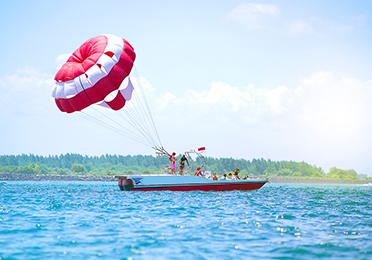
Bali's Adrenaline pumping Water Sports
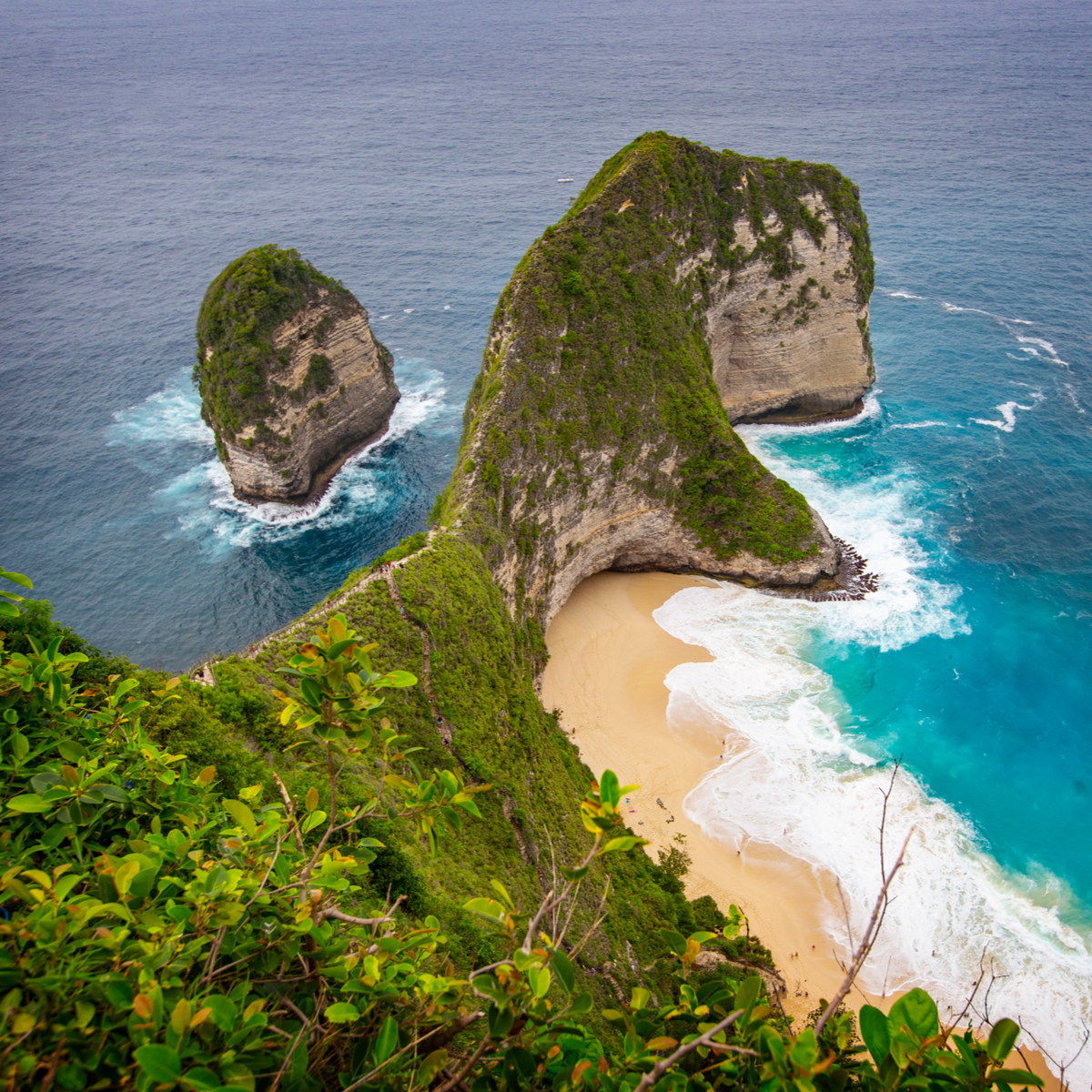
Imagine Visiting Beautiful Beaches That Match Your Chinese Zodiac
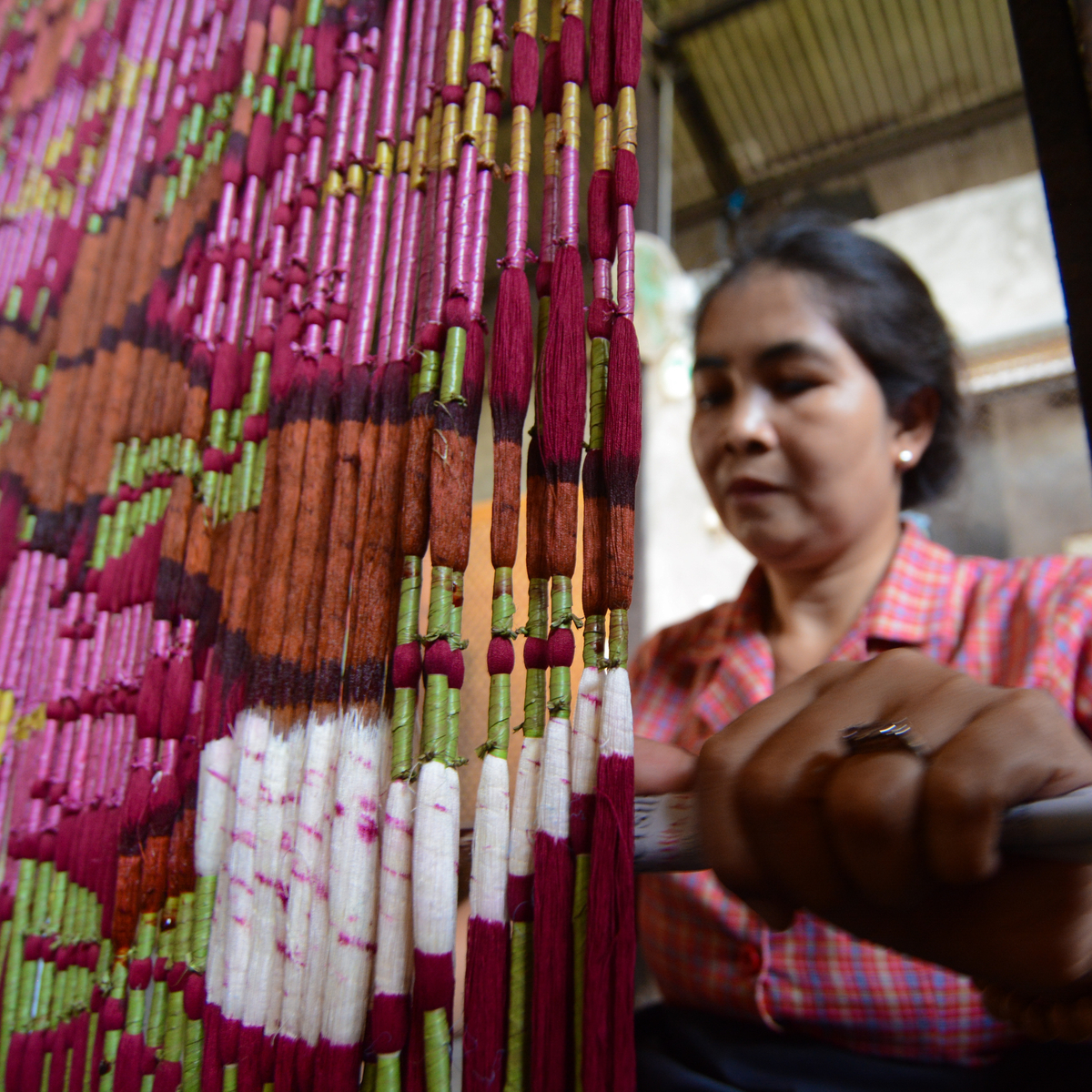
5 Enchanting Traditional Textiles from Bali
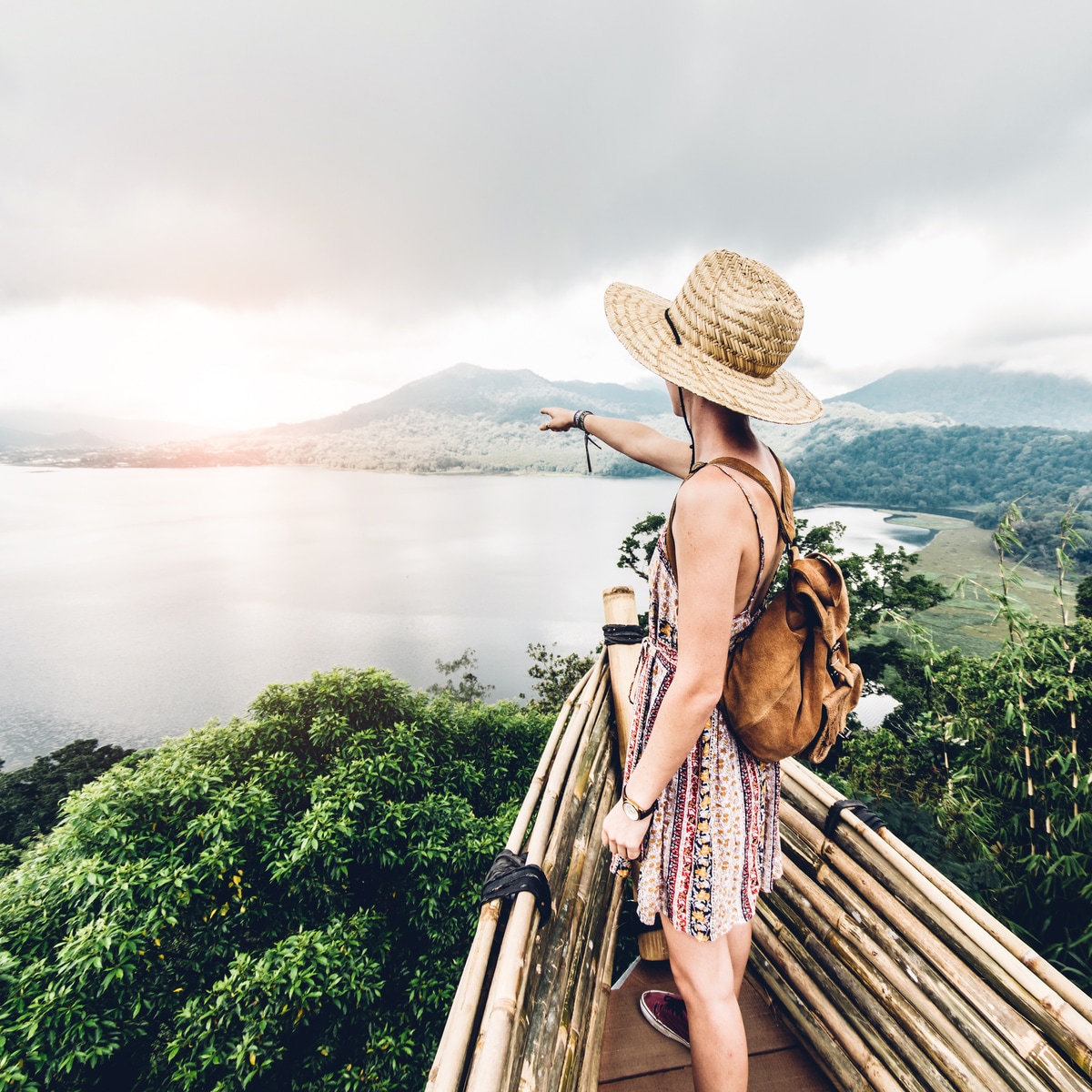
Missing Bali’s Paradise? Plan a Magical Trip with These Backpacking Ideas!

Visit our other website
This is the official website of the Ministry of Tourism, Republic of Indonesia. The contents listed on this website are intended for informational purposes rather than commercial. Any displayed sale is meant as a token of partnership and will always redirect you to our partners' sites.
The 10 best places to visit in Indonesia

Dec 10, 2023 • 7 min read
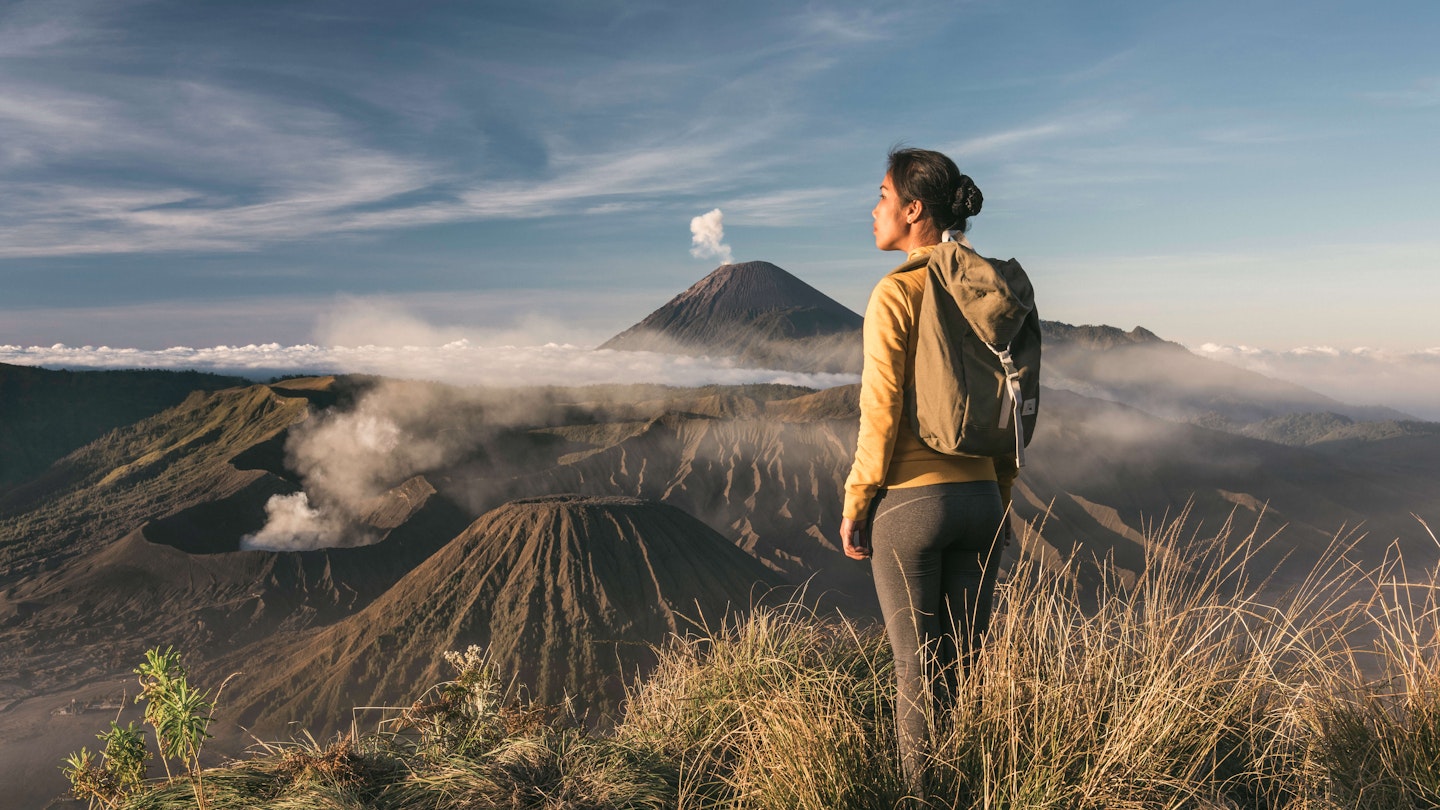
Indonesia is how you've always imagined Asia – jungles, rice terraces, beaches, coral reefs and volcanoes © Martin Puddy / Getty Images
Few destinations can beat Indonesia in terms of variety.
One day, you're strolling beneath the glistening skyscrapers of a modern city; the next, you're in a traditional hilltop village scoffing down steaming gado-gado (tofu, tempeh, vegetables slathered in a creamy peanut sauce).
From climbing the freezing-cold summit of a puffing volcano to beating through tropical rainforests in search of orangutans or tigers, Indonesia offers unparalleled opportunities for adventure. Where else can you salute the sun at sunrise and then surf a world-class barrel back to a virgin beach at sunset?
Roughly half of all international tourists land in Bali , but the nation is so much more than this one enticing island. From Java , Sumatra and Sulawesi to the frontier islands of West Papua (shared with Papua New Guinea) and Borneo (shared with Malaysia and Brunei), here are the top places to visit on a trip to Indonesia.
1. Jakarta, Java
Best city for art and history .
There’s no better place to get to grips with this vast and complex nation of 273 million people than its capital, Jakarta . Home to more than 10 million residents, it’s chaotic, traffic-clogged and sprawls over nearly 700 sq km (270 sq miles). It’s also home to the nation’s finest restaurants, wildest nightclubs and best museums.
Take time to browse the collections in the Museum Nasional (for history), Galeri Nasional (for classical art) and MACAN (for modern and contemporary art). From the Dutch colonial buildings of the Kota Tua neighborhood to the modern skyrises of the Golden Triangle, the city is both a study in contrasts and a crossroads of cultures, classes and cuisines.

2. Tanjung Puting National Park, Kalimantan, Borneo
Best place to see orangutans.
If you want to see orangutans, the island of Borneo is the last place on earth (other than a few spots in neighboring Sumatra) where these great apes still thrive. Travelers looking for surefire sightings of orangutans head to Tanjung Puting National Park , a coastal tropical swamp forest that looks today like much of southern Borneo looked a few decades ago.
Most visitors hire liveaboard boats to travel up the Sekonyer River to feeding stations in the rainforest and Camp Leakey, the iconic rehabilitation center deep in the jungle where these auburn-haired 'men of the forest' live out a serene, semi-wild existence.
3. Raja Ampat, West Papua
Best place for snorkeling and diving.
Raja Ampat was once an under-the-radar destination visited only by intrepid scuba divers, but the whispers about this enticing island group have now reached a fever pitch. Off the coast of West Papua, the archipelago is a picture-perfect vision of paradise. Its lumpy green isles are blanketed in rainforests, dotted with languid lagoons and surrounded by warm turquoise seas at the vibrant heart of the Coral Triangle – an area of ocean with some of the greatest marine biodiversity on earth.
Raja Ampat's prismatic birds-of-paradise, which dance through the trees each morning at sunrise, informed the theory of evolution through natural selection, first developed by Charles Darwin’s less-appreciated contemporary, Alfred Russel Wallace. The British naturalist's restored hut is a popular attraction on the island of Gam. In addition to the dive lodges on Waigeo and Misool, many visitors sleep in homestays on virgin beaches, offering a chance to learn more about West Papua's distinctive culture.

4. Ubud, Bali
Best city for wellness and culture.
Rice paddies tumble down palm-lined hills, gamelan music fills the air, and floral offerings fill the streets in Bali’s most alluring (and on-trend) city, Ubud . By day, you can take a motorcycle out to the Monkey Forest for simian encounters, pop into the Yoga Barn for an ashtanga session, ogle the art at the Agung Rai Museum or shop for word-class beauty products, woodcarvings and batik textiles downtown. After dark, many people attend evening performances at local temples, where visitors are hypnotized by the beauty of courtly Legong ballets or wild Kecak fire dancing. Be careful! Many foreigners come to Ubud for a few days and end up staying a few years.
5. Komodo National Park, Nusa Tenggara
Best place for surprising wildlife encounters.
Dragons really do roam the earth at this sprawling national park , covering the three arid islands – Komodo, Padar and Rinca – that provide shelter for the world’s largest lizards. Komodo dragons are ancient-looking creatures that can grow up to 3m in length and weigh up to 70kg. Sadly, there are fewer than 1400 of these fork-tongued giants left in the wild. The chance to see them lures thousands of visitors each year, many of whom arrive on a boat tour en route from Lombok to Flores , stopping along the way to snorkel or dive off the coast of Sumbawa .
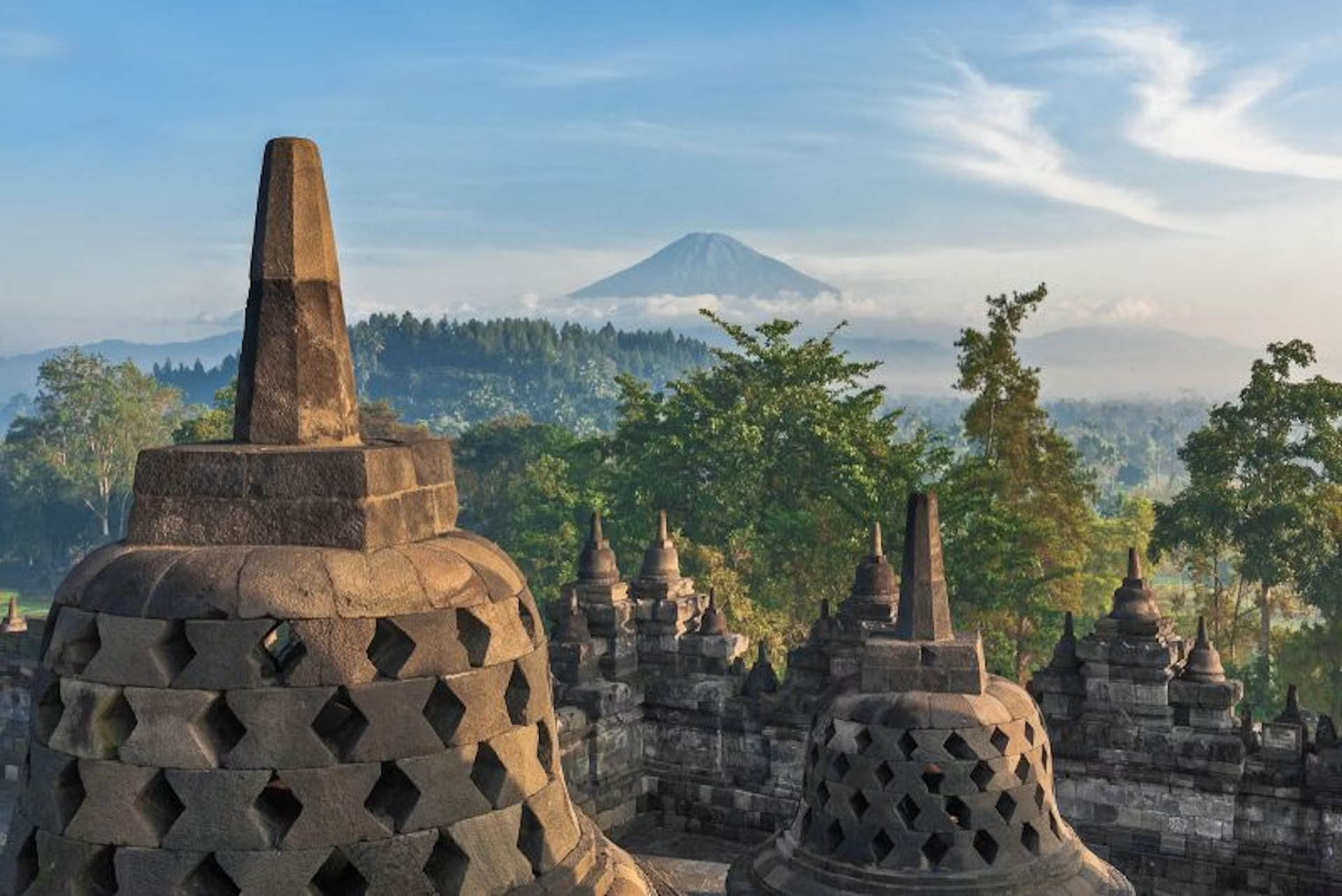
6. Borobudur and Yogyakarta, Java
Best place for indonesian history.
Peru has Machu Picchu, Cambodia has Angkor Wat, and Indonesia has Borobudur , a nine-tiered temple from the 9th century that clocks in as the largest Buddhist structure in the world. Emblazoned across its walls are some 2672 intricately-carved bas relief panels featuring Buddhist legends and scenes of daily life in Java, as well as 72 distinctive, perforated stupas and more than 500 Buddha statues.
This colossal World Heritage Site lies amid sprawling rice paddies near Yogyakarta , an important education center and a hub for classical Javanese art forms, including batik-making, wayang puppetry and silversmithing. Yogya, as the city is known locally, is fiercely independent and still headed by a resident sultan, whose walled palace complex is the city’s top attraction.
7. Tana Toraja, Sulawesi
Best place for cultural traditions.
The jungle-clad hills and rugged granite cliffs of Tana Toraja would be enough of a lure for most places, but the big draw of the central highlands of Sulawesi is the Torajan people themselves. The inhabitants of this fascinating region maintain traditions that mark them apart from other Indonesians, living in villages of elaborately decorated houses with intricately carved walls and boat-shaped roofs.
Many rituals here revolve around death and the afterlife. The bodies of the deceased remain in the homes (and lives) of their relatives for months or even years after they pass – for Torajans, death is viewed as a gradual and social process, and locals are generally comfortable sharing these unusual traditions with visitors.

8. Kerinci Valley, Sumatra
Best place for hiking.
Southeast Asia’s tallest volcano, Gunung Kerinci – a 3805m (12,484ft) monster – lords over this remote highland valley on Sumatra , which has become one of Indonesia’s top spots for adventure travel. You can climb to the summit of this active volcano, swim beneath cascading waterfalls or search dense jungles for gibbons and langur monkeys.
Much of the land here is protected as Kerinci Seblat National Park, which is two times the size of Bali and protects more forest than all of Costa Rica’s national parks combined. At 13,791 sq km (5325 sq miles), Kerinci Seblat is the last large refuge for the critically endangered Sumatran tiger, which survives here in greater numbers than anywhere else on the planet.
9. Bromo Tengger Semeru National Park, Java
Best place for beautiful indonesian views.
You don’t have to look far in Indonesia to find a volcano, but Bromo Tengger Semeru National Park in East Java contains a whopping five volcanoes right next to each other. These conical peaks are dotted around a lunar landscape that has sprung from the ancient Tengger caldera.
The most striking site is smoldering Gunung Bromo, which rises 2329m (7641ft) out of a crater that is almost 10km (6 miles) across, surrounded by the nation’s only erg (dune sea). Most visitors time the trek to the summit to arrive at dawn to view the crater and volcanoes at their ethereal best.

10. The Gili Islands, Lombok
Best place for beach parties.
These tiny dollops of coral and sand off the coast of Lombok carry an outsized reputation thanks to their crystalline turquoise waters, white-sand beaches, ambitious vegan and health food restaurants, renowned freediving schools and epic beach parties. The Gilis started out as a boho backpacker destination, but the islands now cater to all types of travelers, with everything from backstreet hostels to luxurious beachfront cabanas (beach huts).
Gili Trawangan (aka ‘Gili T’) is the largest and most developed of the islands, with a main drag that heaves with shops, massage parlors and cafes. Gili Meno is the smallest and most traditional island, while Gili Air offers the best of both worlds and is a lively hub for yoga tourism.
This article was first published Apr 21, 2022 and updated Dec 10, 2023.
Explore related stories
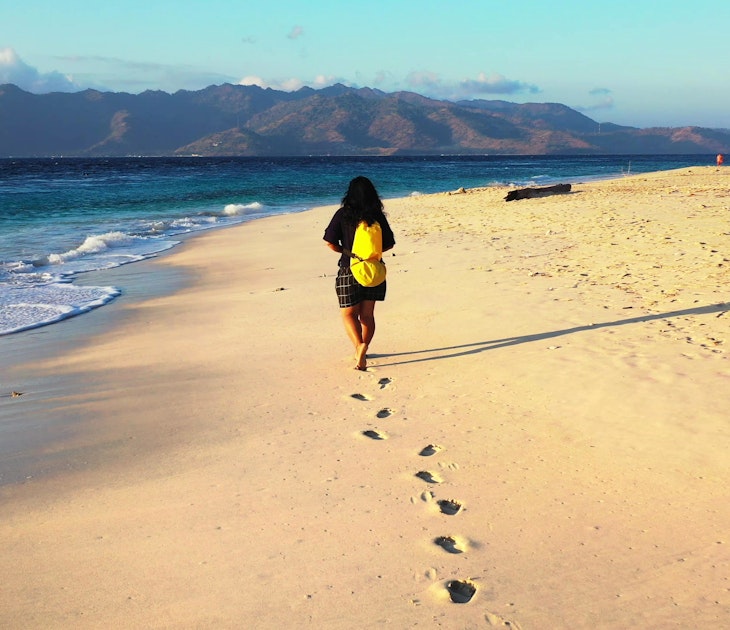
Apr 22, 2024 • 7 min read
They may be very peaceful and small in size, but the Gili Islands pack a punch in terms of things to do. Here are the islands' best experiences.
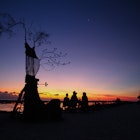
Apr 22, 2024 • 6 min read

Mar 20, 2024 • 8 min read

Mar 4, 2024 • 8 min read

Feb 12, 2024 • 10 min read
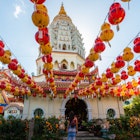
Jan 22, 2024 • 11 min read

Jan 5, 2024 • 20 min read

Dec 10, 2023 • 6 min read
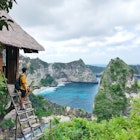
Dec 8, 2023 • 7 min read
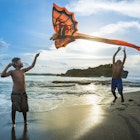
Nov 28, 2023 • 5 min read
- All Activities
- Sustainable Development Goals
- Conference of the Parties (COP)
- Events and Meetings
- News Portal
- Media Releases
- Latest Publications
- Publication Series
- Fact Sheets
- Photo Galleries
- WMO Community
- The Secretariat
- Our Mandate
- WMO Members
- Liaison Offices
- Gender Equality
- Partnerships
- Resource Mobilization
- History of IMO and WMO
- Finance and Accountability
- World Meteorological Day
- WMO Building
WMO and the Early Warnings for All Initiative

The Early Warnings for All initiative aims to ensure universal protection from hazardous weather, water, or climate events through life-saving early warning systems by the end of 2027, a call echoed by the United Nations Secretary-General António Guterres in 2022.
Today, one third of the world’s people, mainly in least developed countries and small island developing states, are still not covered by early warning systems... This is unacceptable, particularly with climate impacts sure to get even worse. Early warnings and action save lives. To that end, today I announce the United Nations will spearhead new action to ensure every person on Earth is protected by early warning systems within five years.
UN Secretary-General António Guterres on World Meteorological Day 23 March 2022
With human-induced climate change leading to more extreme weather conditions, the need for early warning systems is more crucial than ever. Despite the urgent need, only half of the countries worldwide report having adequate multi-hazard early warning systems. A Multi-Hazard Early Warning System (MHEWS) is an integrated system which allows people to know that hazardous weather or climate events are on their way, and informs how governments, communities and individuals can act to minimize impacts. MHEWS should be people-centred to empower those threatened by hazards to act in sufficient time and in an appropriate manner, and must build on partnerships within and across relevant sectors.
Four pillars for delivery of end-to-end MHEWS
The initiative is built on four pillars to deliver effective and inclusive multi-hazard early warning systems, and is co-led by the World Meteorological Organization (WMO), the United Nations Office for Disaster Risk Reduction (UNDRR) , the International Telecommunication Union (ITU) and the International Federation of Red Cross and Red Crescent Societies (IFRC) and other partners.
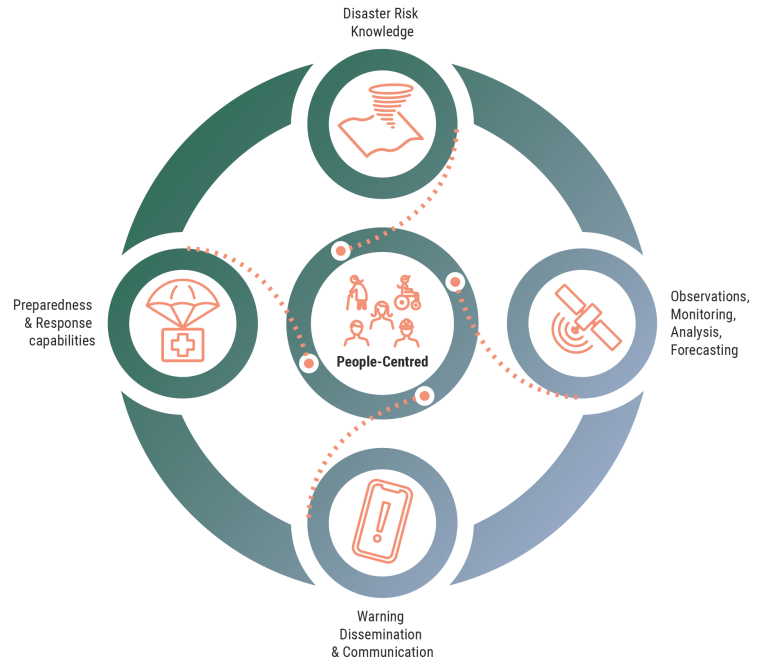
The delivery of Early Warnings for All requires scale up and coordinated investments and action across the four essential pillars of end to end, people-centred Multi-Hazard Early Warning Systems (MHEWS):
- Pillar 1: Disaster risk knowledge
- Pillar 2: Detection, observation, monitoring, analysis, and forecasting
- Pillar 3: Warning dissemination and communication
- Pillar 4: Preparedness and response capabilities
WMO leads the implementation of Pillar 2: Detection, observation, monitoring, analysis, and forecasting, with support from UN Development Programme (UNDP), UN Educational, Scientific and Cultural Organization (UNESCO) and UN Environment Programme (UNEP).
Pillar 2 is critical for societies to be better equipped to understand, prepare for, and respond to the evolving challenges of our changing climate: Early Warning Systems rely on worldwide sharing of data collected from the Earth's surface and space. This information is freely exchanged between countries and analyzed by highly advanced supercomputing modelling centres. These centres run numerical models which simulate how different parts of the Earth System (weather, hydrology, oceans, and cryosphere), interact with each other. From these simulations, predictions are made and then passed down from global to regional and national levels. This allows National Meteorological and Hydrological Services (NMHSs) to provide accurate forecasts to citizens. Without this coordinated effort facilitated by WMO, modern day weather and hydrology forecasts would not be possible.
Pillar 2 aims to address several challenges:
In response to these, the Pillar 2 Implementation Plan is focused on delivering 5 outcomes:
Improving data quality and access:
It's essential to have more high-quality data available for checking and keeping an eye on major dangers. This data forms the backbone of services for weather, climate, and water. We need to make sure countries can get to and use this data to watch over their main risks.
Sharing data worldwide:
Ensuring easy sharing and access to data globally is paramount, particularly when it comes to forecasting and issuing early warnings. Organizations tasked with collecting or generating data sets, creating forecast products, refining information, and offering storage services play a pivotal role in this effort. Our goal is to enable smooth data sharing across local, national, and global scales while keeping it cost-effective.
Enhancing forecasting capabilities:
Our focus is on refining the utilization of predictive tools for significant weather-associated challenges. Leveraging improved data, advanced computational power, and deepening insights into weather dynamics, our weather forecasting precision is enhancing. As we coordinate member capabilities, we prepare and distribute meteorological analyses and forecast products for all Members, ensuring the provision of consistent and harmonized services, which is essential for our future readiness.
Proactive measures for early action:
It's essential that our forecasts and alerts adhere to international standards. Strengthened by regional partnerships and bolstered by advanced tools and training, we're dedicated to enabling every nation to issue round-the-clock warnings. Our commitment isn't just about predicting severe weather events; we also emphasize the associated dangers. Such detailed insights equip communities to effectively brace themselves, safeguarding residences, infrastructure, and their environment.
Establishing robust leadership frameworks:
Robust governance is pivotal, which involves crafting appropriate policies, establishing efficient organizations, and ensuring collective participation to facilitate prompt warnings and actions. Such frameworks also foster platforms for knowledge exchange and discussions on current advancements and trends in disaster risk reduction.
The 193-Member Congress, which is the WMO’s top decision-making body, has accorded that Early Warnings for All is the top overriding priority of the organization, as enshrined in the WMO Strategic Plan 2024–2027
Accordingly, key WMO activities are coordinated and consolidated under the Early Warnings for All umbrella including the work of the technical commissions and regional activities aligned to achieve the goal.
National Meteorological and Hydrological Services are the official and authoritative providers of early warnings for hydrometeorological hazards.
WMO's work for the implementation of Pillar 2
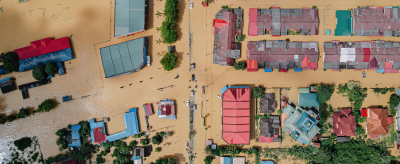
Tropical Cyclones
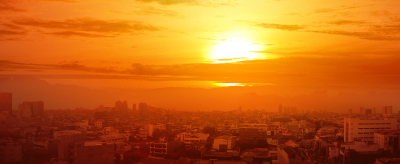
The WMO Congress has accorded that Early Warnings for All is the top overriding priority of the organization, as enshrined in the WMO Strategic Plan 2024–2027 . Accordingly, WMO activities are coordinated and consolidated under the Early Warnings for All umbrella including the work of the Technical Commissions and regional activities aligned to achieve the goal.

Systematic Observing Financing Facility (SOFF):
The SOFF is a UN vertical fund co-created by WMO, UNDP, and UNEP to close the climate and weather observations data gap in countries with the most severe shortfalls in observations, prioritizing Least Developed Countries (LDCs) and Small Island Developing States (SIDS).
Learn more about SOFF
Climate Risk and Early Warning Systems (CREWS):
WMO hosts the secretariat of the CREWS. CREWS provides financing to LDCs and SIDS for people-centred risk informed early warning systems to reduce vulnerability and strengthen resilience and adaptive capacity.
Learn more about CREWS
Related Publications
Early warnings for all in focus: hazard monitoring and forecasting, assessment guidelines for end-to-end flood forecasting and early warning systems.

COMMENTS
The shoulder season (March-June & September-November) is the best time for natural encounters. With its winning combo of superb weather, reduced tourist numbers, and lower prices, the shoulder season periods at either end of the peak season are our favorite times to visit Indonesia. Though you may get some rain (especially towards March and ...
The best time to visit Indonesia is from April to October, the dry season, ideal for outdoor adventures and easier travel across the country. This period offers sunny, warm weather, perfect for activities like swimming, sailing, and trekking. It's also the peak tourist season, especially in Bali, with numerous cultural events and lively beach ...
Weather in Indonesia in September. September is one of the best months to visit Indonesia — when the summer chaos has dissipated. Still dry and sunny, it's a great time for land-based activities. September is when one can catch the Erau Festival Tenggarong — a fantastic display of indigenous Dayak skills and dancing.
Conclusion: Best Time to Visit Indonesia. Indonesia's allure is year-round, with each season offering its unique charm and possibilities. From the sun-drenched beaches and vibrant festivals of the dry season to the lush landscapes and serene tranquility of the wet season, there is no definitive best time to visit Indonesia.
Best time to visit. The best time to visit Indonesia is between April and October, when the weather is perfect for island-hopping, snorkeling, and beach relaxation. Bridging the Equator, Indonesia is hot all year round, with the only change coming between November and March when the country sees widespread rain, particularly in the south.
From getting ready before you go to important etiquette and safety information, here are 15 things you need to know to help you plan your trip to Indonesia. 1. Pick the best season depending on where you're going. Most visitors to Bali do their best to avoid the rainy season (normally November to March), but there is really no bad time to visit ...
Generally speaking, the best time of year to visit Indonesia is between May and September when the days are dry and sunny. However, during wet season temperatures remain high and rainfall comes in the form of intense tropical downpours that tend to last for a couple of hours and needn't spoil your trip.
The best time to visit Indonesia. Nov 28, 2023 • 5 min read. Whether you're dreaming of hitting the beach in Bali or searching for orangutans in the jungles of Borneo, these are the best times to visit Indonesia. Tips & Advice. 10 of the best foods and drinks to try in Indonesia. Apr 29, 2024 • 6 min read.
The best time to visit Indonesia is between April and October, when you'll find warm and sunny weather for beach-hopping, temple touring and walking, as well as snorkelling and diving.Despite its vast size, the country has a fairly even climate. The rainy season in Indonesia is between November and March, when you can expect sudden tropical downpours most days.
Weeks with ideal weather are listed above. If you're looking for the very warmest time to visit Indonesia, the hottest months are October, May, and then November. See average monthly temperatures below. The warmest time of year is generally mid October where highs are regularly around 89.8°F (32.1°C) with temperatures rarely dropping below ...
The best time to visit Indonesia is from May to September when the country experiences the dry season. However, if you're looking to catch the best sets, the best time for surfing is the shoulder season from April to June before the peak season crowds arrive. Indonesia's wet season falls from October to April, sometimes impacting travel ...
Build your ideal Indonesia trip. Call 1.406.541.2677. Start Planning My Trip. The dry season, which runs from May to September, is the best time to visit Indonesia's most popular islands for hiking, cycling, and diving. If it's your first trip to Indonesia, you will probably want to visit Bali, Komodo National Park, and Lombok.
With sunny skies and temperatures ranging from 27°C (80°F) to 32°C (90°F) on average, the dry season is the best time to visit Indonesia. However, this is also the peak season for most travelers, which means you will find higher rates and more crowds. Average temperatures: 27°C (80°F) to 32°C (90°F)
The best time to visit Indonesia is during its dry season from mid-April to September. The weather in this tropical country can be split into two seasons - dry and wet. Indonesia experiences its wet season in the remaining months from October to mid-April. The dry season has warm, sunny and dry days that offer the perfect conditions for ...
In terms of tourist seasons, the best time to travel to Indonesia is during the shoulder season, which includes the months of May, June and September. During these months, the temperature is very pleasant and the tourist areas are less crowded. The off-season in Indonesia, that extends from October to April, is also the rainy season.
Best time of year to visit Indonesia. Ideal for all kinds of water activities, April through October is considered the best time to visit Indonesia. The weather is stunning, so you can explore magnificent Mount Rinjani National Park or climb Mount Borneo. The country sees heavy short downpours and high humidity between November and March ...
Best Times to Visit Bali for Good Weather . Sunseekers should time their trip with Bali's dry season, which runs from April to October. During this period, humidity and rain decrease, creating ...
The best time to visit Indonesia is between May and September. Little rainfall, clear skies and average temperatures of 30°C (86°F) are perfect conditions for exploring the islands. Indonesia's tropical rainy season falls between November and February. Showers typically pass quickly and with less crowds, travel at this time has its benefits.
It's always a good time to travel to Indonesia. The climate of Indonesia is unlike other Asian countries. Most of the islands have an equatorial climate. Indonesia is characterized by two seasons, the dry season and the rainy season, however, this varies on each of the 17,000 islands, which means you can travel to Indonesia almost all the ...
The Worst Time to Visit Bali. The rainy season (November to March) seems to be the worst time to visit, particularly the rainiest month, January.So for sun seekers with flexible schedules, avoid this period or go to sunbathing island destinations, like Thailand, Vietnam, and the Philippines.. Rainfalls are occurring every 2 or 3 days during these months.
Best Times To Visit Bali. The best time to visit Bali is between April and October, during the dry season, when you can expect warm, sunny days and low humidity. The offseason (from November to ...
Bali Dry Season. The dry season is the best time to visit Bali when it comes to the weather because for half of the year you can expect beautiful clear skies and almost no rainfall. The dry season in Bali runs from May to October, although this can vary each year. The peak months are the height of the Balinese winter, which is June, July, and ...
By far the largest country in Southeast Asia, Indonesia lies at the southern end of the region and consists of roughly 17,500 islands, including Sumatra and Bali. With so many islands, it's no ...
In Indonesia, the best time to visit is April to October. Temperatures average 24-30ºC (75-86ºF), and the weather is mostly dry. July to September is the peak holiday season and when you can expect to pay the highest rates. December to February is the rainy season.
According to the Circular Letter of the Directorate General of Immigration No. IMI-0764.GR.01.01 of 2022 concerning the Immigration Policy regarding Electronic Visit Visa Services, Visit Visa on Arrival Services, and Free Visit Visa to Support Sustainable Tourism during the Covid-19 Pandemic, as of 10 November, 2022, E-VoA program is being applied for some international travelers in order to ...
Best place for hiking. Southeast Asia's tallest volcano, Gunung Kerinci - a 3805m (12,484ft) monster - lords over this remote highland valley on Sumatra, which has become one of Indonesia's top spots for adventure travel. You can climb to the summit of this active volcano, swim beneath cascading waterfalls or search dense jungles for ...
Only a third of WMO Members and Territories report having multi-hazard monitoring and forecasting system: Half of the 30 countries initially selected for Early Warnings for All coordinated assistance operate with basic monitoring and forecasting capacity, and close to a quarter with less-than-basic capacity: There are critical gaps in surface and upper air meteorological observations across ...
[Chorus] They not like us, they not like us, they not like us They not like us, they not like us, they not like us [Verse 3] Once upon a time, all of us was in chains Homie still doubled down ...